Talking Roots

‘Despite

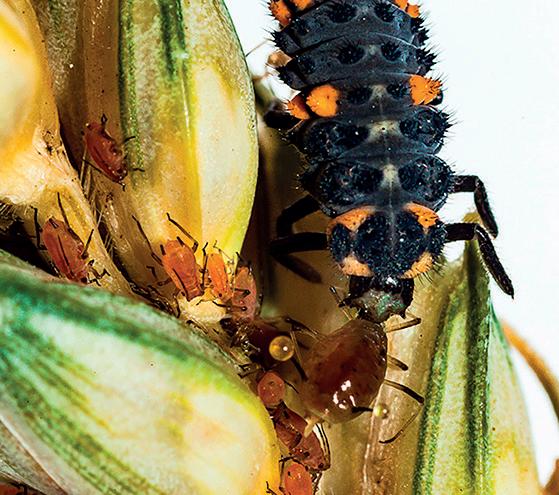
































Page

Pages
Pages
Pages
The weather will change on its own timetable, I’m primed and ready for the ag leaf, and Revystar ® XE at T2 will ensure a quality wheat crop. Use plant protection products safely. Always read the label and product information before use. For further product information including warning phrases and symbols refer to www.agricentre.basf.co.uk. Revystar ® XE contains mefentri uconazole (Revysol®) and uxapyroxad (Xemium® ). Revystar ® XE, Revysol® , and Xemium® are registered Trademarks of BASF. ©BASF 2023. All rights reserved. Innovation in action for progressive arable farmers
17
all the rain, we are still in a water deficit’ May 2023 Volume 46 Issue 5
6-7
18-21 BIOLOGICALS BUSINESS Informing a UK biopesticides policy B Corp gains farming ground
34-37 ON-FARM TRIALS Could plant breeding provide a slug solution?
SU BARESI & SU ARVID Hybrid Rye
SU Baresi and SU Arvid are new hybrid ryes with flexible end market potential for UK growers. With high-mass dry matter yields and consistently high methane content out of whole crop harvests, both are excellent choices for biogas. Both benefit from strong standing power and new genetics give improved brown rust resistance. When you’re after new generation biogas varieties, these are the two to go to.




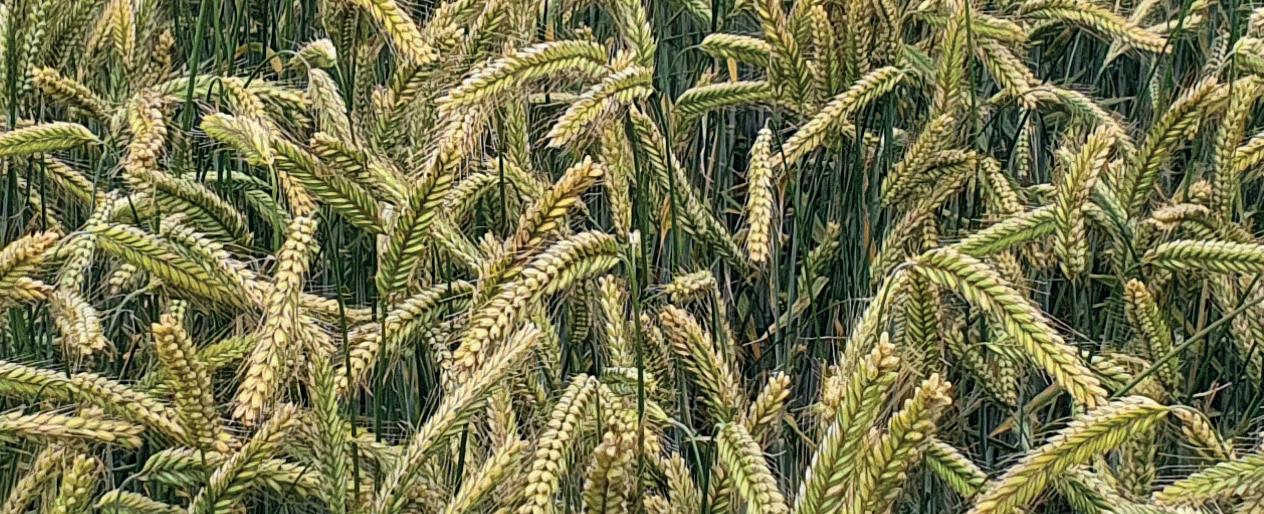


Ask your merchant about availability or see more at elsoms.com




NEW
Working in partnership for the UK grower elsoms.com
HYBRID RYE
Comment
10 Talking Arable
If there is to be a year when we learn how much we miss chlorothalonil, this might be it
14 Talking Agronomy
Managing the height of some early-drilled wheat will be testing
17 Talking Roots
Despite all the rain, we are still in a water deficit
73 Talking Policy
Urea offers a crucial opportunity to show self-regulation works
Technical
22 Fresh thinking key to unlocking biologicals value
Research into bio-solutions is revealing the opportunities they offer mainstream arable production
26 Farming carbon as a crop
How a Sussex estate is aiming to maximise carbon capture and credits
32 How digital tools can inform disease management strategies
Digital tools are helping translate complex data into simple insights
40 LepR1 genetic resistance will provide added layer of security
OSR varieties with a new phoma resistance gene are in the UK testing pipeline
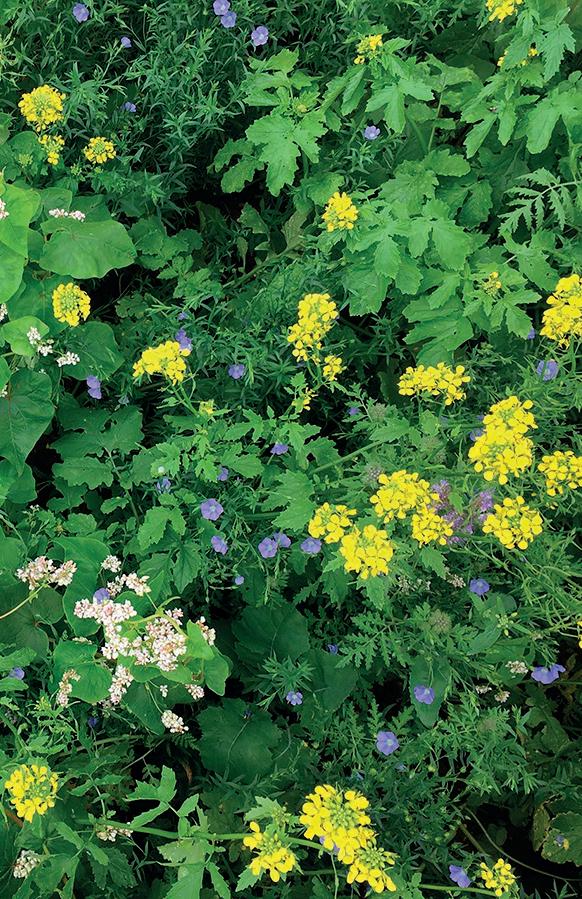
43 Sugar beet optimism despite challenging start

The contract price increase has given beet a boost
Machinery
48 Fendt tractor test

Fendt 516 shows small is powerful
52 ‘Handle anything’ tractors delivering value all year round
Why half-tracks have joined wheels in one Linc’s tractor fleet
54 Coming soon to the digital shed
Autonomous machines are making good progress to market
60 Rain stops play on demo day
Agrii reconvened its 2022 Lincs drill demo in Kent with a wider range of machines
65 Drill trials establish plant count benefits
Plant counts were a differentiating factor in a North West drill trial
67 On test: Long-term flexibility from Horsch Focus 3TD
Part 2 of our Horsch drill test
Product
72 Mancozeb supplies for 2023 blight season BASIS
74 How to find an environmental consultant
3 MAY 2023
CONTENTS: REGULARS
news
news
MAY 2023 VOLUME 46
26 48 43
In this issue of
56
6
6 Business
Certification schemes
Why a Hertfordshire farm has looked to B Corp to measure its business impact
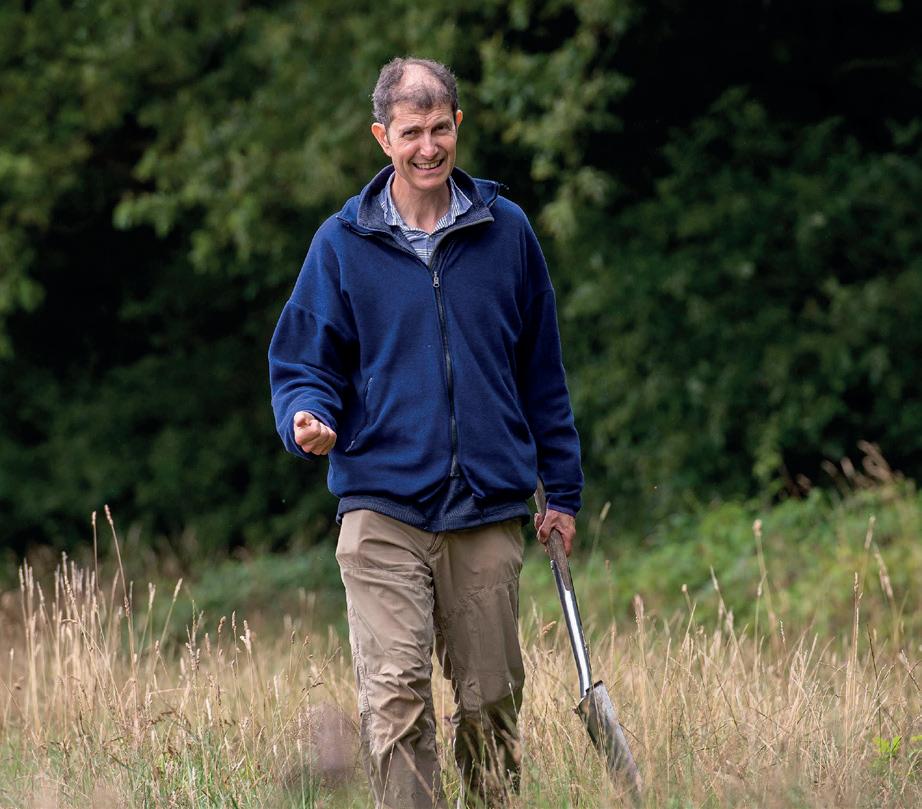
34 Technical
Slug control
On-farm trials are helping to improve slug control on one Yorkshire farm
38 Plant breeding
Oilseed rape
A ‘hard reset’ of the RAGT OSR programme is starting to deliver promising new varieties

46 Research and development
Pest management
How genetics might help beat cabbage stem flea beetle
56
Machinery
Materials handling
Efficient bulk handling is underpinning a Nott’s business’ diversification success

CONTENTS: FEATURES 4 MAY 2023
38
a word from the editor
Contacts
Group Editor – Arable
Teresa Rush 01787 282 822 teresa.rush@arablefarming.com
Senior Arable Technical Specialist
Alice Dyer 07966 445 458 alice.dyer@arablefarming.com
Arable Technical Specialist
Ash Burbidge, 07786 190 188 ashleigh.burbidge@agriconnect.com
Machinery Editor
Toby Whatley 07583 054 831 toby.whatley@arablefarming.com
Head of Creative Services
Gillian Green, 01772 799 417 gillian.green@agriconnect.com

Picture Editor
Marcello Garbagnoli 01772 799 445 marcelllo.garbagnoli@arablefarming.com
Key Accounts Manager
Jane Newton 01948 780 783 jane.newton@arablefarming.com
Key Accounts Manager
Mark Jackson 01322 449 624 mark.jackson@arablefarming.com
Account Manager
Chris Knowles 01772 799 550 chris.knowles@agriconnect.com

Sales Director
Mike Hartley 01772 799 532 mike.hartley@arablefarming.com
Advertising Production
Justine Sumner 01772 799 437 justine.sumner@arablefarming.com
Circulation and subscriptions 0330 333 0056 help@subscribe.farmers-guardian.com
© Agriconnect 2023
All rights reserved. No part of this publication may be reproduced or transmitted in any form or by any means, electronic or mechanical including photocopying, recording, or any information storage or retrieval system without the express prior written consent of the publisher.
The contents of Arable Farming are subject to reproduction in information storage and retrieval systems. ISSN 0269-6797

Spring has shown its face but is taking its time to put in a full appearance. Late frosts, a wet March and early April, and generally unpredictable weather have thrown spring drilling schedules into disarray and left agronomists wondering how many more revisions they will need to make to crop protection plans before sprayers can finally get the job done.
Looking out of my window I see a stiff breeze is rising, after a bright, still start to the day, which means that sprayers will once again come to a halt, but at least the sugar beet drills will be moving.
The general feeling is that this season’s beet drilling campaign is two weeks or so behind where it normally would be expected to be. However, with plenty of moisture available in seedbeds, there is optimism that crops will get away well in good conditions (p43) and growers will be well placed to take advantage of the 48% price uplift for the new season beet crop.
Plant breeding is a big theme in this issue, with news of developments in commercial oilseed rape breeding programmes that could bring improved genetic protection against key diseases (p38-42), while at a research level, there is hope that genetics can help tackle the cabbage stem flea beetle (CSFB) threat (p46-47), which continues to undermine so many growers’ confidence in the crop.

While genes and traits will without doubt have a crucial role in crop protection going forward, developments in biopesticides also continue apace, with predictions that bio-products could potentially make up over a third of crop protection inputs within the next decade, playing a key role in integrated pest management (IPM) approaches. However, that won’t happen without a regulatory framework that is fit for purpose.
Industry leaders from across the arable and commercial horticulture sectors are voicing concerns over the lack of progress, post Brexit, in implementing a new GB framework in the crop protection space, which would encompass chemical as well as biological control actives. It was interesting to hear at a recent meeting organised by Fera of the success Brazil has seen with the uptake of biologicals following implementation of a clear policy for bio-inputs (p18-21).
In the field meanwhile, pathogens are no doubt doing their best to test the genetics and chemical and biological actives that we currently have at our disposal. Let’s hope our crop protection tools are successful in their work this spring.
46 www.croptecshow.com November 29-30, 2023 5 MAY 2023 Origination
Published by Agriconnect. Printed by Precision Colour Printing, Halesfield 1,
TF7 4QQ. No responsibility can be accepted by Arable Farming for opinions expressed by contributors.
Arable Farming, Unit 4, Fulwood Business Park, Caxton Road, Preston, Lancashire PR2 9NZ
by Farmers Guardian, Unit 4, Fulwood Business Park, Caxton Road, Preston, Lancashire, PR2 9NZ.
Stirchley, Telford
With the social and environmental performance of farms rising up the agenda and attracting new funding, a number of pioneering farms are embracing what is seen by many as a gold standard certification system. Cedric Porter reports.
B Corp gains farming ground
Easthall Farm near Hitchin, in Hertfordshire, grows 405 hectares of wheat, oats, beans and stewardship options, with a 120-head suckler herd plus followers. According to owner Fergus Lyon, minimising the farm’s environmental impact has always been important.

He says: “Our mission is to preserve and enhance the landscape and support local communities while running a sustainable business and growing excellent quality food. We have been running a regenerative system for a number of years and are Leaf Marque certified. We practice no-till, grow cover and catch crops and avoid using insecticides. A significant proportion of the estate is in Countryside Stewardship schemes.”
It was in Prof Lyon’s academic role as professor in the Centre for Enterprise, Environment and Development Research at Middlesex University that he
came across the B Corporation or B Corp certification system.
“I was impressed by the way B Corp was a much broader measure of the impact of a business than other schemes that focus on one aspect. It allows us to not only track our economic and environmental performance but our social performance as well,” he says.
Beyond profit
So what is B Corp? It began in the United States in 2006 when friends and business executives Andrew Kassoy, Bart Houlahan and Jay Coen Gilbert decided there was a need for a system that would make businesses a force for good by looking beyond their profit margins. It has evolved into system that certifies for-profit companies in any sector on their social and environmental performance.
In its own words, it says: “We envision a global economy that uses business as a force for good. This economy is comprised of a new type of corporation - the B
Corporation - which is purpose-driven and creates benefit for all stakeholders, not just shareholders.”
Easthall Farm’s list of stakeholders is a long one and not only includes the family but future generations. Also on it are staff, suppliers and customers.
“A farming business has a very wide impact and influence, so our stakeholders are not only human ones such as our neighbours, the local community and the wider public, but also nature, the landscape and the wider global environment,” says Prof Lyon.
As well as taking part in Open Farm Sunday, Easthall Farm hosts educational visits and provides information for the local
community on what it is doing.
A network of not-for-profit ‘B Labs’ have certified 6,000 businesses in 150 industries over the years, with 1,200 in the UK. The first step in the process is to complete and submit a free B Impact Assessment online. It comprises 200 questions that are tailored to a company’s size, sector and locations. It is designed to measure the business’s positive impact on workers, suppliers, community and the environment. Any sensitive practices, fines and sanctions must be declared.
The assessment is marked out of 200, with 80 points needed to be eligible for certification. B Labs say it is rare for businesses to achieve a score of 80 at the first try, with most spending time to improve their score. The system includes improvement reports, best practice guides and a goal-setting function.
Before B Corp certification can be submitted and reviewed, the business must change its Articles of Association to reflect a commitment to creating a material positive impact on society and the environment, with consideration
6 BUSINESS MAY 2023
B Corp is a good way of holding the business to account
PROF FERGUS LYON
Lyon of Easthall Farm, Hertfordshire.
B Corp gives a good framework within which to improve a farm business and an opportunity to learn from a strong network across a number of sectors, says Prof
Other B Corp farming businesses
RIVERFORD
rOrganic producer supplier Riverford says its current B Corp score is 124.6 out of 200, putting it in the top 5% of B Corp businesses of a similar size. Riverford adds that it scored highly when it came to staff, partly because of its employee ownership model. Its community score was high, but reducing and offsetting carbon and improving biodiversity were identified as areas for improvement.
SUMMERDOWN FARM
thinking about our impact on the environment and how we can maintain a thriving, sustainable ecosystem.”
VERTICAL FARMERS
for the impact that decisions and operations may have on all stakeholders. For registered companies, these articles are filed with Companies House.
After completion of a disclosure questionnaire, the assessment can be submitted for review by the B Lab. It will check business eligibility and applicants will be asked to provide evidence to back up any statements. The process can take several months. Once certification is awarded the business needs to sign a B Corp agreement. Fees for certification include a submission fee of £250, a 12-month pending fee of £500 and then an ongoing annual sliding fee based on turnover, which ranges from £1,000 for a business with sales of up to £150,000 a year to £1,500 for sales of up to £1 million, £4,000 for up to £10 million and a maximum rate of £50,000.
Once certification is awarded companies can use the B Corp logo in marketing and attend networking and working groups with other members. Members must also publish an annual impact report and share progress

and goals. Recertification takes place every three years.
At Easthall Farm, certification is delivering a number of benefits.
Prof Lyon says: “B Corp is a good way of holding the business to account in all the ways it operates and for all the people it impacts. It also gives a good framework to improve the business and a strong network of businesses across a number of sectors that we can learn from.”
Criticisms
There are criticisms of the system. Sustainability consultancy business Akepa says that it has been accused of being elitist with its goals more achievable for larger multinational companies than smaller ones. It added that its process of certification is regarded as bureaucratic, long and expensive by some. Meanwhile, there accusations of greenwashing among some environmental charities who criticise the awarding of certification to subsidiaries of food giants such as Nespresso.
B Corp responds to the greenwashing accusation by saying that controversial
rOwned by the Colman family of mustard fame, Summerdown grows 40.5ha of peppermint alongside 688ha of other crops and stewardship schemes in Hampshire. It says: “We believe in farming for the future, so we’re always

rB Corp has been adopted by several vertical or controlled environment farmers. These include LettUs Grow in Bristol and Harvest London, while fellow London business Zero Carbon says that it was the first of its type to meet B Corp’s standards. It claims that its herbs use 90% less water to produce than other systems and that it is already carbon neutral.

industries as a whole would be ineligible for certification. Individual operators may be certified if they are going above and beyond to reduce negative impacts and make improvements. In 2020 it released guidance on the measures it would require to certify agribusiness operators in Brazil, including evidence of no illegal deforestation since 2008 and protection of
land rights for indigenous people. Will Sibly, business relationship co-ordinator at Leaf has been looking at the impact of B Corp.
“I don’t see the certification as competitive to LEAF Marque, but complementary as it covers some social and economic impacts that Leaf does not. It is also clear that Leaf’s standards would contribute to gaining B Corp certification,” he says.
7 BUSINESS MAY 2023
Fergus
B Corp has been adopted by several vertical farming businesses.
Red Tractor defends ‘greenwashing’ slur R
ed Tractor has vowed to ‘strongly defend every aspect’ of its promotional activities, after a campaign group accused it of ‘greenwashing’ agricultural pollution on an ‘industrial scale’.
River Action filed three complaints to the Advertising Standards Authority (ASA) against Red Tractor, accusing the agricultural assurance body of masking agriculture’s role as one of Britain’s most environmentally destructive industries.
The campaign group has accused Red Tractor of mislead-

Joining forces to promote biodiversity
JThe UK Centre for Ecology and Hydrology (UKCEH) is working with Land App and Sainsbury’s on a partnership aiming to give farmers in Great Britain greater abilities to enhance their positive impact on biodiversity, soil health, river pollution and climate.

The partnership utilises Land App’s digital mapping tool and UKCEH’S existing E-Planner data, enabling farmers to choose the best place for activities such as planting trees, creating pollinator-friendly areas, river protection and wild bird food.
Dr John Redhead, spatial ecologist, UK Centre for Ecology and Hydrology, said: “It’s really important for us as environmental scientists to find ways to ensure that our research can make a difference on the ground. We designed E-Planner to place our research data in the hands of farmers, in a way that helps them
find opportunities to manage their land in more environmentally sustainable ways.
“It’s been great to work with Sainsbury’s, with its broad range of suppliers, and with the Land App’s widely used digital mapping tool, to widen the reach of E-Planner and help integrate it into farm decision-making.”
Gavin Hodgson, director of agriculture, horticulture and fisheries at Sainsbury’s, said: “The environment is extremely important to Sainsbury’s and our customers. As a business we depend on nature and want to ensure that through our direct operations and wider supply chains we are doing everything we can to protect and preserve it. By collaborating with industry experts and combining it with the wealth of knowledge that our farmers have, together we can play a part in making our food better for the planet.”
ing consumers via its advertising, website and YouTube content. It has based its complaints on an assessment carried out by the Environment Agency (EA) in 2020, which found that Red Tractor membership was ‘not currently an indicator of good environmental performance’ and that members are more likely than other farms to cause pollution incidents.
It says Red Tractor failed to comply with ASA codes issued following the EA report that found RTA farms accounted for
62% of Category 1 and 2 pollution incidents (the most severe incidents) and 56% of Category 3 pollution incidents.
Misleading
A Red Tractor spokesperson said: “Red Tractor maintains that the suggestion that ‘Red Tractor farms are more likely to pollute the environment’ is inaccurate, misleading and a disservice to 46,000 Red Tractor farmers. The data in the EA report actually supports the opposite conclusion.”
Contracting prices on rise
JContracting price rises are ‘inevitable’ this spring as inflation continues to impact costs for contractors.
Releasing its latest survey of contracting prices, the National Association of Agricultural Contractors (NAAC) highlighted the UK inflation rate was currently over 10% but there were more modest increases in contracting rates, with significant price rises in some services while
others have seen barely any movement.
More than 90% of farmers use a contractor, according to NAAC, with the organisation adding it is important for farmers and contractors to work in partnership to maximise efficiency, productivity and cost benefit for both parties.
Overall soil preparation costs have increased by just over 4%, with drilling costs up almost 3.5% since last year.
8 NEWS REVIEW MAY 2023
The UKCEH is working with Land App and Sainsbury’s to help farmers enhance their positive impact on biodiversity, soil health, river pollution and climate.
Teachers inspired to educate children about food
JFarmers from across the industry helped inspire teachers about where food comes from at four regional conferences held across the UK.
More than 300 teachers were given an insight into farming and the care and attention that goes into producing food to help them learn more about delivering food education to their students.
The conferences were organised by Food – a fact of life, managed by the British Nutrition Foundation in partnership with AHDB.
Each event featured a working farmer who gave an insight into their daily life and how they fit into the food production process, as well as dispelling myths and misconceptions about agriculture.
Mixed farmer James Taylor and arable farmer Richard Orr each presented at a conference, alongside speakers from across the food and education sectors.
They emphasised the practices that are followed here in the UK, as well as the environmental benefits and efficiencies.
Almost all of the teachers attending the events said they ‘gave them ideas to take back’ and 77% said they were likely to change their teaching practices.
Fertiliser price drops could be levelling off
JFertiliser prices have declined across the board since the turn of the year, with changes in the supply and demand balance and a fall in gas prices.
According to Josh Joachim, fertiliser procurement manager at farm buying group AF, urea prices have led the way – recently dropping from a peak of £710 to £450/tonne.
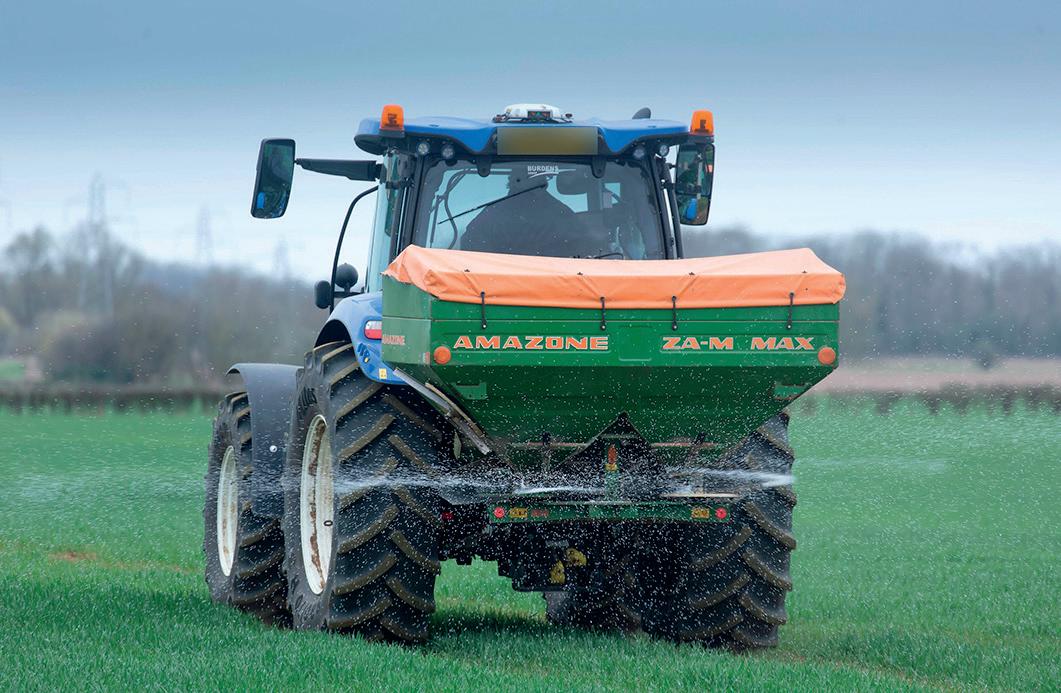
Mr Joachim said: “Ammonium nitrate prices have followed suit –the market is waiting for the new season CF Fertiliser prices, with farmers hoping they will begin with a three.”
Although phosphate and potash production does not rely on gas to be produced, the two nutrients also saw big increase in prices a year ago, but they also have
moderated, Mr Joachim added. “TSP [triple super phosphate] price peaked at £900/t but is now down to £560/t, while the muriate of potash price has fallen from £720/t to £570/t. While most growers need nitrogen fertiliser, many were prepared to skip phosphate and potash applications, which reduced demand and fed through to lower prices.”
Behaviour
The high prices of the last 18 months have altered farmer behaviour, with more farmers using a fertiliser-use calculator that AF launched, plus testing soil and checking nitrogen content in grains. More growers have also switched to slow-release urea.
“If there is a positive to the recent high prices, then it is a focus
John Davidson announced as NFUS chief executive
JNFU Scotland has announced former senior civil servant John Davidson as its chief executive
Mr Davidson was a familiar face in farming circles during his years as private secretary to Richard Lochhead when the latter was Cabinet Secretary for Rural Affairs.
Currently the deputy chief
executive at Scotland Food and Drink, Mr Davidson replaces Scott Walker who stepped down from his post last November.
Senior roles
Mr Davidson joined Scotland Food and Drink in 2020 after a lengthy career in various senior roles across the Scottish
Government including five years as the head of food and drink. He was instrumental in supporting the sector’s recovery from Brexit and the Covid-19 pandemic.
He will start his new role at NFUS in late June, when he will become the 11th chief executive since the organisation’s formation in October 1913.

on the value of fertiliser to the crop and the optimum way to apply and use it,” said Mr Joachim.
However, Jo Gilbertson, head of fertiliser at the Agricultural Industries Confederation, warned that gas prices have not come down much since February and had even risen a little recently.
“While we welcome the reduction in the unprecedented high cost of gas, we need to remain aware that instability in the gas price disproportionately affects fertiliser production costs,” he said.
Current gas prices are still not low enough for the reopening of fertiliser plants that were closed when gas prices soared. CF’s Billingham plant remains the sole UK-based manufacturer of nitrogen, supplying ammonium nitrate to the UK market.
John Davidson
9 NEWS REVIEW MAY 2023
Fertiliser prices are falling but gas price instability remains.
The market is waiting for the new season prices, with farmers hoping they will begin with a three
JOSH JOACHIM
OLLIEMartin
Ollie Martin is responsible for the arable and grain business enterprise across Bedfordia Farms’ 2,450-hectare operation, with 27,000 tonnes of grain storage, near Bedford. He studied agribusiness management at Writtle University College and has held previous farm management roles in Norfolk, Hertfordshire and Fife.
After six long weeks of wet weather, the wheels are finally turning again and we are busy spraying and spreading slurry and digestate on to crops that are very glad to receive it.
The now rapid accumulation of green ticks on the Gatekeeper planning tab is working wonders for my mood. Watching the slurry lagoons empty is also a big relief since the anxiety levels were becoming palpable, in line with the lagoon level.
At the time of writing, I have just ordered the required chemistry for our T1 fungicide applications, the cost of which is enough to make you go organic. The wet weather has seen septoria pressure in the wheat the worst I think I have seen at this stage of proceedings, making the ‘cheap and cheerful’ approach inadequate in my opinion.
already significant cost per hectare. However, I have a nagging doubt that a decade or more of incidental stem disease control from prothioconazole-based products that were primarily targeting septoria have lulled us into a false sense of security.
While more modern azoles and SDHIs now perform more favourably on septoria, they do not provide comparable protection for eyespot. The question is, does it justify additional spending?
Spending
Farm facts
rBedfordia Farms has more than 2,400 hectares of combinable crops including wheat, barley and beans
rThe business also provides grain testing in its on-site lab and has 27,000 tonnes of grain storage and processing capacity
rThere are 27 soil types across the farms, but most of the land consists of Hanslope clay, Faulkbourne and Stretham, which are classified as chalky clay, becoming waterlogged in winter
rThe farm utilises a number of precision technologies and has two pig units totalling 1,100 breeding sows
We will be taking a mefentrifluconazole-based approach with Revystar (mefentrifluconazole + fluxapyroxad) and folpet going on the Crusoe, and Rylox (mefentrifluconazole + pyraclostrobin) and folpet planned for the yellow rust-susceptible Skyfall and Zyatt. If there is to be a year where we learn just how much we miss chlorothalonil then this might be it.
I have been wrestling with the dilemma of whether or not to include some prothioconazole for stem-based disease. It is hard to justify given the

Winter beans have received their first fungicide dose following significant levels of chocolate spot.
Talking of additional spending, Avocet (pyroxsulam) is in danger of becoming a routine part of the wheat herbicide program in order to control brome. This bodes well neither for resistance management nor the bank balance. The frustration is that the already one hundred and something pounds per hectare black-grass strategy does very little to upset the brome, meaning it is an additional spend.
A greater focus on cultural controls including rotational ploughing, break crops and sterile strips where crop meets margin is necessary.
Significant levels of chocolate spot mean the beans have now received their first fungicide of Seraphin (azoxystrobin + tebuconazole) with phosphite, tying us in to a three spray programme.
Generally, the crop looks well, having also received bentazone to control broad-leaf weeds, mainly charlock,
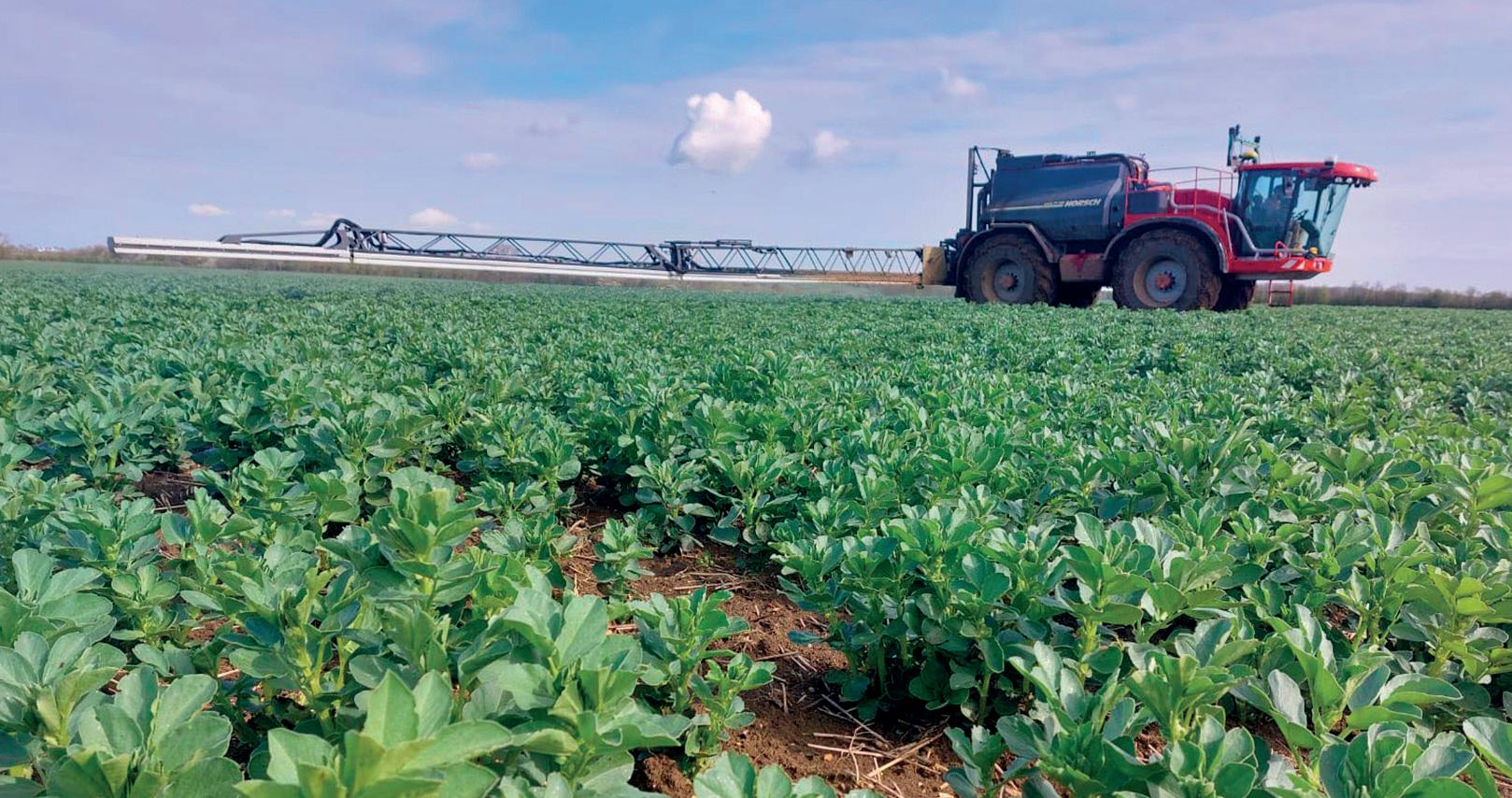
10 MAY 2023
If there is to be a year where we learn just how much we miss chlorothalonil then this might be it OLLIE MARTIN
and Fusilade (fluazifop-P-butyl) for brome and volunteer cereals. I have always enjoyed growing pulses; it’s a shame the satisfaction of growing them isn’t replicated in their market value.
Wheat markets continue to languish in the doldrums with little news from around the world to get excited about. Of course, it would only need Russia to turn cantankerous over the Black Sea grain corridor and that could change. For the moment there is









History is created - BYDV tolerance built-in
not enough concern over crop condition globally to provoke a market reaction.
Oilseed rape prices are as uninspiring as the crop itself currently. Every time I talk myself out of growing it next year I seem to manage to talk myself back in to it again. Beyond financial value, its intrinsic value is the fact that it is a break crop. Besides, there are few, if any, compelling alternatives. Here’s hoping for a prolonged spell of fine weather.
Wet weather has left winter wheat needing a robust septoria programme.

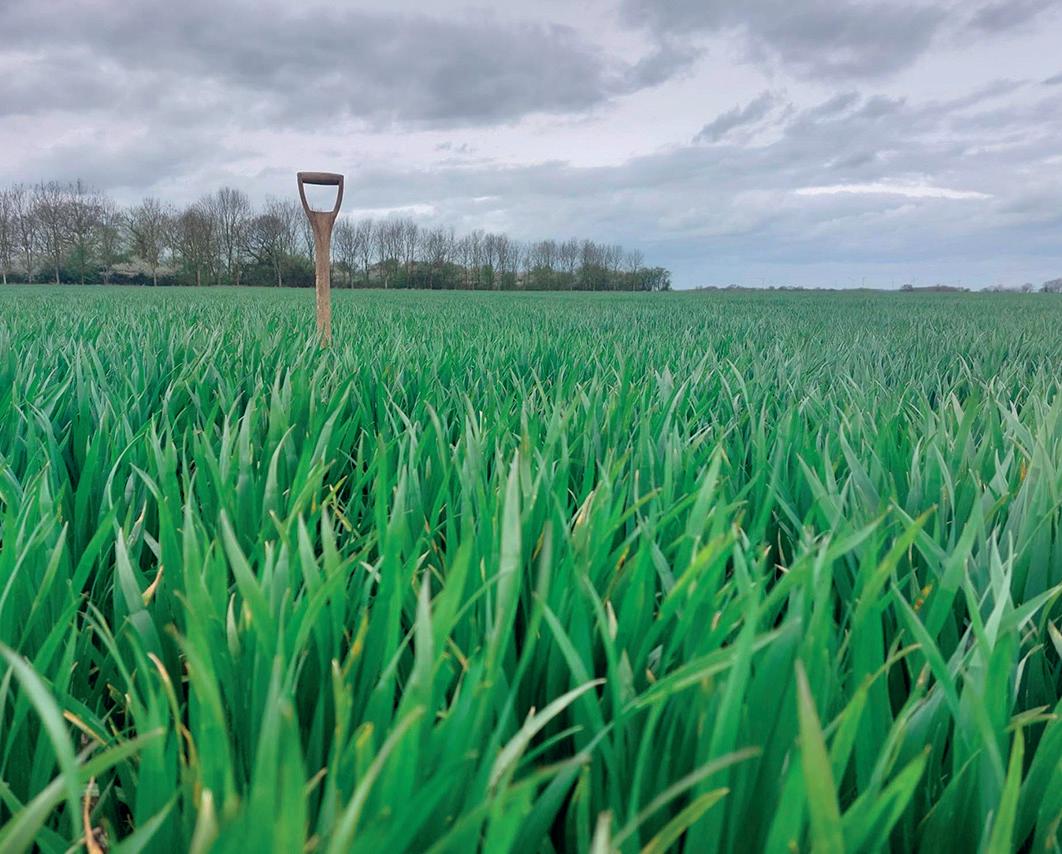
KWS FEERIS
n Excellent yields with BYDV tolerance built-in



n Ultimate risk management tool for those looking to drill early
n Stiff strawed with good specific weight and low screenings
KWS Feeris is a great variety coupled with the added benefit of BYDV tolerance, it is the only solution for those looking to grow barley in high BYDV hotspots or for those looking to push drilling as early as possible. For growers looking to reduce inputs and produce a more sustainable winter barley crop this season, KWS Feeris is the only barley they need to put in the drill.
Scan the QR code to find out more

www.kws-uk.com




11 TALKING ARABLE MAY 2023
Winter Barley
ROB Beaumont
Rob farms on the Worcestershire/Herefordshire border with his parents and young family, growing combinable and forage crops with a mix of owned, tenanted and contracted land. An agronomist for Edaphos, Rob also hosts AHDB Monitor Farm events.
Afew choice words that aren’t publishable would be best to describe the last month. As I’m sure many of you have faced, conditions have been challenging to say the least. Some of the beans that went in, in perfect conditions have struggled where soils have lay wet through March. Mostly they are okay though and I’m glad we got 90% in the ground before the weather turned. We started our first patch on February 20 and finished the last field yesterday (April 9).
Still awaiting drilling for us is wholecrop grass and maize. Some of my agronomy clients still have barley to drill and I’m sure the cuckoo has started calling. There doesn’t seem to be a huge amount of fun in it at the moment. Three dry springs on the bounce and then a wash-out. I don’t care what anyone says, the climate is becoming more erratic. The switch seems to be either on or off.
The Easter weekend brought us a chance to catch up with spraying, drilling and fertiliser spreading. Field conditions were variable, and the
pressure washer was put to good use once we’d finished. Wheats look okay in general. The graminicides that went on in early March have yellowed a few patches, but they have had a nutritional rescue-remedy and a second dose of N now. Unlike the last few years, there are noticeable levels of septoria and eyespot, especially in susceptible varieties.
Balance
Attention will now turn to T1 and my thoughts are that this year may require some decent chemistry where farmers feel it is appropriate (as long as they have not fallen off their chairs at the price of it). The balance between reducing inputs but protecting your investment is something we all need to be thinking about, especially when considering the cost of the N to grow it.
Then there is OSR. The wet and cold did no favours for any crops that came out of the winter struggling, especially on heavy ground. A couple of patches I look after got finished off by the flying rats for good measure. On a more positive note,
Farm facts
rFamily farm covering 200 hectares of mainly silty/clay loams, growing combinable and forage crops
rRob is BASIS and FACTS qualified, having also received a post graduate diploma in sustainable agriculture from Harper Adams
rCurrently in the third year of strip till establishment
rFarming operation is focused on reducing inputs and maintaining profitability

rRob is using cover crops and organic manures to build fertility
rUsing integrated pest management practices to reduce pesticide usage
OSR that established well on light to medium soils is looking promising.

12 MAY 2023
The balance between reducing inputs and protecting your investment is something we all need to be thinking about ROB BEAUMONT
those on light to medium soils that established well are racing away and should make a decent crop, providing Mother Nature doesn’t throw some other spanner in the works. Whether or not anyone makes any money growing it is another thing.


Markets continue to be volatile. One minute the world is crashing around us, the next another £15 rally is on. Fortunately, we are out of the old crop game and so we’re watching to see what happens to new crop over the summer. We have taken some cover for November. It’s anybody’s guess if this will prove to be prudent risk management or selling it way too cheap. There’s plenty of time for a negative weather situation in a major producing area and I suspect there will be more twists and turns in the Ukrainian war.
Which leads me to my final thought. Without being too pessimistic, there are good years and bad years in farming. However, things do feel particularly worrisome at the moment. Reductions in direct support at a time of huge inflationary pressures, coupled with the volatility of the markets and unpredictable weather patterns is making the game of growing commodity crops less and less attractive.
The fortunes of many farming businesses are increasingly influenced by factors beyond our control. Without a sensible policy to ensure sustainable and economic food production I suspect many growers may decide that the juice is no longer worth the squeeze. Hopefully by the time you read this, the sun will be shining and everything will be green and growing again.

SCAN ME
DISC ROLLER XL CONTOUR
Precise cultivation & consolidation




MULTI-PURPOSE PRIMARY & SECONDARY CULTIVATOR
Precise depth control and contour following gives uniform soil movement across the full operational width - vital if employing reduced tillage or creating stale seedbeds for blackgrass control.




• Hydraulic SAT system - “contour” following system on folding models.
• DSD - depth synchronised disc, system ensures the whole soil profile is moved across the full working width.

• Hydraulic depth control

• 2 rows of opposing 610mm sabre discs
• Single or twin V-profile or twin U-profile roller rings - optimum re-consolidation for weed germination.
• Working widths from 2.75m to 7.25m.


13 TALKING ARABLE MAY 2023
OPICO Ltd. 01778 421111 ask@opico.co.uk opico.co.uk Profit from our knowledge
Distributed by
FRONT LEVELLING SHATTABOARD
Scan from your mobile and sign up for a demo he-va.co.uk
Wheat is showing noticeable levels of septoria and eyespot, especially in susceptible varieties.
TALKING AGRONOMY
BEN Boothman
Managing height on some early drilled wheat will be testing
April started off carrying on the trend of its predecessor March - wet and cold. This has caused the growing backlog of spray jobs to swell even more, with spray plans ever-changing from the originals prescribed six weeks ago. I forget what version I’m on, but I’m pretty sure we passed plan C a while ago.
We have just had a week of dry sunny weather, although this was less than the 10 days promised at the end of last week. However, I will take anything I can get at the moment.
Hopefully the respite will allow sprayers to get caught up, though in many situations land will need several days to dry up before big, hefty sprayers can venture in to fields. I fear a tidal wave of water could be racing ahead of the wheels in the tramlines only to retreat into some impressive wheelings.
Early sown winter wheats are fast
Agronomist facts
approaching their first main T1 fungicide timing, with leaf 3 from three-quarters to fully emerged. Some of these early drilled crops could be excused for canary grass and managing their height will be testing.
With most sulfonylurea grass-weed herbicides now applied, I usually count this as a start to my plant growth regulator programmes, with a split of trinexapac and chlormequat added in with the T1.
Yellow rust has been halted by the cold March, but septoria is the lingering beast which, if persistent rain comes back, could swiftly arise from hibernation.
I have planned most of my T1 fungicides around the more septoria-active mefentrifluconazole and fluxapyroxad actives. In relatively low risk varieties such as Extase a lower dose of the SDHI accompanied by metconazole will be my go-to choice.
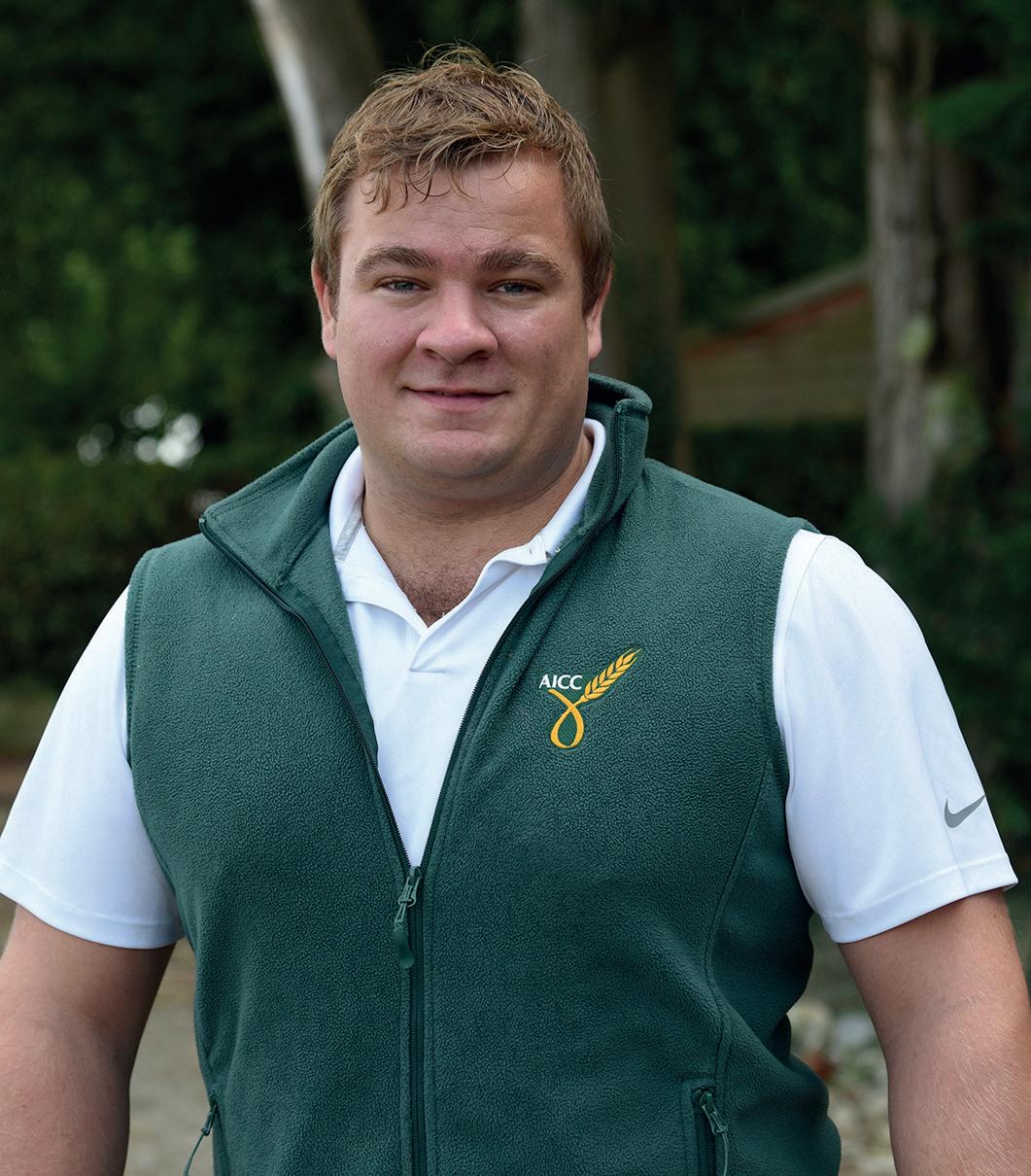
Winter barleys are going through the growth stages day-by-day with the earlier sown crops now displaying their flag leaves. Due to the unsettled weather and ground conditions many have only just received their T1 fungicides and a first PGR application. Where crops are large and final nitrogen applications completed, as long as flag leaves are still tucked away a recommendation of mepiquat chloride will be prescribed. Rate will depend on the individual crops and if anything else is partnered with it.
Oilseed rape crops are now well into flower and survived the early April frosts relatively
unscathed. As crops slowly burst into flower, sclerotinia is our main target with bixafen and prothioconazole my preferred actives. This spray will be applied when the crop is in full flower. If conditions stay dry during flowering, then a second spray may not be needed as petal stick onto the plants will be vastly reduced and with a significant change in commodity price to this time last year, money must be spent wisely. Pigeons are still feasting on some crops and unfortunately their desire to fatten up means there have been a few late calls on crop survival.
Spring barleys
Late February drilled spring barleys are looking well and will soon be ready for a broad-leaved weed tidy up, a dash of prothioconazole and a good helping of manganese. These well tillered crops should now have received their full nitrogen complement while the later sown fields that are now all poking through can also be finished off.
Winter bean crops have recovered from the battering they took over winter and even those suffering a bentazone hangover are starting to display their first flower buds.
Winter linseeds have all had their early spring herbicide mixes to try and get on top of troublesome poppies and other sand land broad-leaved weeds. Plans will be left this week (April 17) for another hit of PGR accompanied by a late spring fungicide.
14 MAY 2023
JBen Boothman is an independent agronomist and member of the Arable Advisor Group and the Association of Independent Crop Consultants (AICC), covering Yorkshire and the North East. He is BASIS, FACTS and BETA qualified and studied for a degree in agriculture and crop management at Harper Adams University.
KEEP YOUR BEANS SPOTLESS.
UNLOCK PULSE POTENTIAL


WITH SIGNUM
Growers know that pea and bean yields are notoriously unpredictable. Proven fungicides, such as Signum














are one way to improve results.

control, Signum £30/ha

farm standard programme*, Signum







Widely recognised as the best product for chocolate spot maximises pulse yields by stopping botrytis and rust in their tracks, whilst also keeping leaves greener for longer. Shown to increase yields by 20% compared to untreated bean crops and achieve £30/ha more margin than a builds yield and margin. for more.









agricentre.basf.co.uk/signum

of Signum










































Signum contains boscalid and pyraclostrobin. Use plant protection products safely. Always read the label and product information before use. For further product information including warning phrases and symbols refer to www.agricentre.basf.co.uk. © BASF 2022. All rights reserved.
*Based on two winter bean trials by PGRO and OAT in 2020 comparing two applications at 0.5kg/ha with two applications of azoxystrobin and tebuconazole, mean untreated yield of 4.2t/ha, no chocolate spot present. Beans price based on £200/t.
TALKING AGRONOMY
PHIL Warham
The return to warmer and drier weather has been very welcome following the wet March and much of April.
While winter wheats generally look very well, they are also rather lush and leggy after the rains, offering ideal conditions for disease development and potential lodging issues later on.
Septoria was easy to spot lurking in many crops but was kept under control with a robust T1 centred around mefentrifluconazole plus boscalid with the multisite folpet added to boost protection and as an anti-resistance strategy. Growth regulation was based on chlormequat and trinexepac. Crops look well set up with plenty of potential, which we need to safeguard at the all-important T2 timing.
Wheat prices have come under pressure of late but we have already invested a lot of money establishing, feeding and protecting
Agronomist facts
JPhil Warham has been an Agronomist with Agrovista for six years. He gained a degree in land and farm management at Harper Adams University and managed farms for several years afterwards. He now advises on combinable crops, cereals, maize and vining peas in Lincolnshire, Nottinghamshire and into Leicestershire. Key interests include direct drilling and soil health, as well as making farms profitable. In his spare time he is a keen runner and horseman.

crops. Gross margins will be tight, but yield remains the key driver to improve headroom, so sensible, targeted inputs according to potential remain the order of the day.
Treatment
All other things being equal, the best crops will repay the best treatment. With that in mind I’ll be recommending quite a lot of Inatreq (fenpicoxamid), in conjunction with prothioconazole, as our own trials and commercial experience have shown it is technically the best septoria product on the market, and, importantly, the best value.
Last season my growers who used Inatreq at 200 litres/hectare water volume and followed manufacturer’s guidelines suffered no problems.
I will add folpet again and will also use benzovindiflupyr for rust if necessary. I will also have discussions with growers about using Klorofill, which improves chlorophyll production and maximises green leaf area.
This is an important consideration during periods of rapid growth such as during the flag leaf stage. So too is magnesium, which can run short at this stage in a crop’s life and depress yield.
Weed control worked well earlier in the season. That said, it’s worth checking as late May is the best time to make the decision to patch spray any areas for black-grass before seed shed.
I’m monitoring oilseed rape crops for mealy cabbage aphid. Last season I saw much more than in recent years, and numbers can build quickly in warm dry conditions, damaging pod-bearing racemes. If the threshold of 13% plants affected is reached it would be worth
adding tau-fluvalinate to the fungicide flower spray.
Mid-flowering fungicides may have occurred; if not I would recommend fluopyram and prothioconazole, as well as Klorofill and Roller, the latter to improve coverage and absorbtion to enhance spray performance.
The wet first half of April brought on infections of chocolate spot in winter beans, so we have already had to apply a fungicide – this early on the disease can have a devastating effect on the crop.
If we go again we will use azoxystrobin and tebuconazole or benzovindiflupyr and prothioconazole with Calfite Extra. This contains calcium phosphite to stimulate root and biomass growth plus L-PGA (pidolic acid) to increase nitrogen assimilation within the plant.
With the Yield Enhancement Network project showing a positive association between K inputs and high yielding bean crops, I will recommend adding Wholly K to the mix to deliver potassium when conditions may limit soil uptake. It also contains L-PGA.
Spring barley crops were sown early and are now at late tillering, so we need to prepare for T1 at GS30 I will be applying a fungicide programme of fluoxastrobin, prothioconazole and trifloxystrobin plus growth regulation, as well as Klorofill and trace elements based on a prior leaf test.
We have now applied pre-emergence pendimethalin sprays to forage maize; follow-ups of mesotrione and perhaps pyridate if necessary. This will all be done before the crop gets to the five-leaf leaf stage or we will see crop yield penalties. Just be aware of following crops when making your herbicide decisions.
16 MAY 2023
Sensible, targeted inputs according to potential remain the order of the day
DARRYLShailes
Despite all the rain, we are still in a water deficit
There is a saying ‘be careful what you wish for’ and last time I wrote I was saying the Waveney Valley was very dry and we needed more rain. Since then, we’ve had the wettest March for 40 years or more depending on who you listen to, and potato plantings and sugar beet drilling are well behind where they would normally be for the middle of April.
Even with all the rain we’ve had, the garden didn’t flood at Easter and I heard on Radio Norfolk a spokesperson from Anglia Water saying that there is still potential for a hosepipe ban this coming summer. Apparently we are still in a deficit and ground water levels are low.
At least we’ve now managed to cut all the grass while watching the cock pheasants squaring up to each other.
The next big event will be the arrival of the cuckoo, so I can get Dad over again, this time with his hearing aid working. I checked
Agronomist facts
the Cuckoo Tracking Project on the British Trust for Ornithology website and the earliest birds are currently in Spain and the south of France.
Apart from delaying plantings, the few crops that have been drilled have seen some free-living nematode damage. Free-living nematodes are one of the biggest threats to agriculture worldwide and in the UK beet and potatoes can both be affected.
Damage
The testing we did last autumn showed that the levels in the topsoil were very low and I was very wary of making too many assumptions as we had had such a long dry spell. This has changed now after a month of wet weather, and they have migrated up the soil profile and affected the crops planted in sandy soils. Once infected, there is nothing we can do apart from foliar feed the affected crops as their root systems will be damaged.
With limited treatments available to us, a more integrated approach is needed. Mustard biofumigant cover crops are one of the few ways we can affect the population in the soil, but they need to be managed correctly or they can increase the problem.
The use of cover crops is becoming increasingly common in sugar beet and
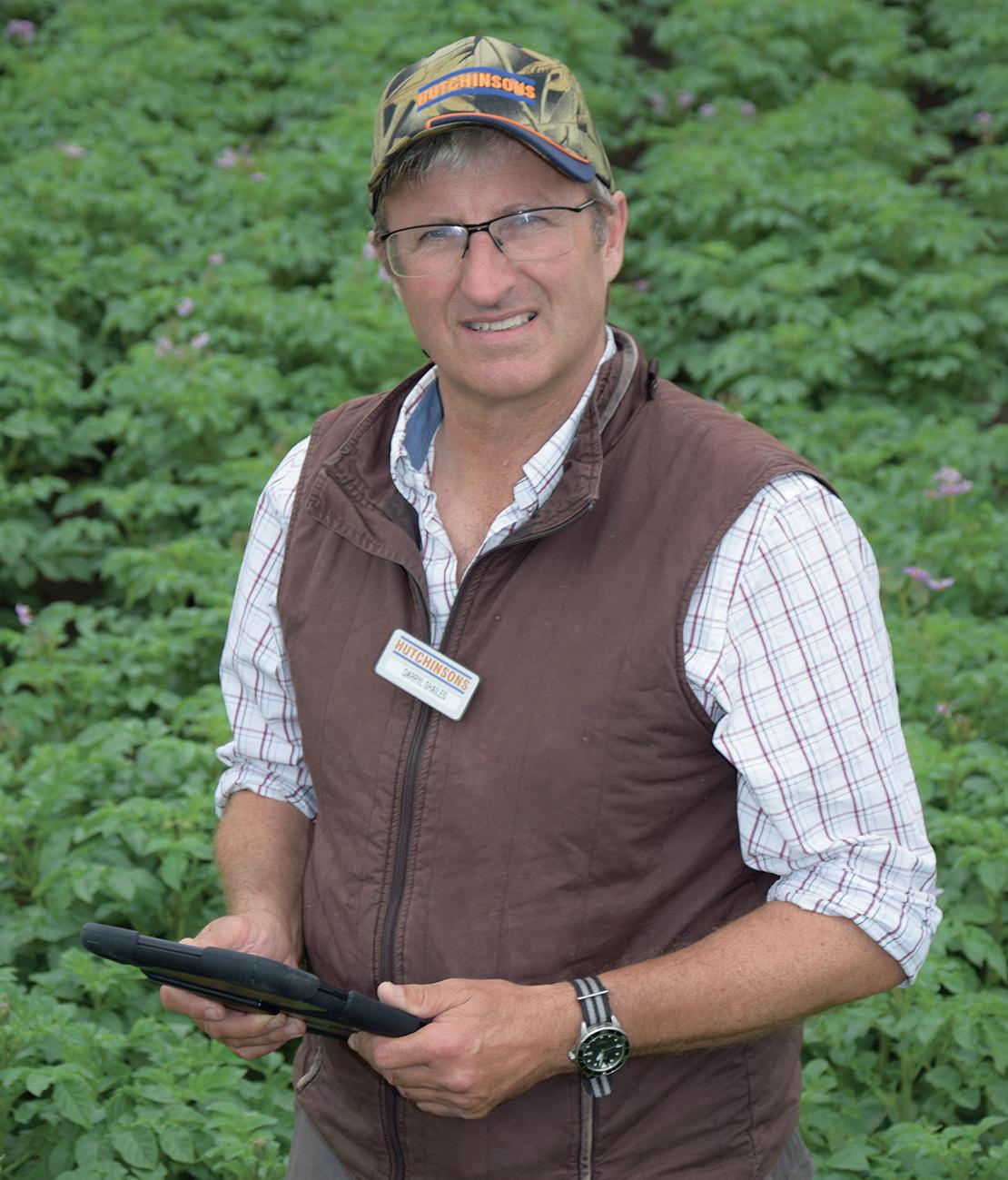
potato rotations for the soil benefits they undoubtedly bring and for benefits to pest management.
One of the best uses of a cover crop is barley in sugar beet to camouflage the beet from aphids and it can have a big influence on how early they invade the crop and hence infect the crop with virus. I have seen it for myself now on several occasions.
The increase in wireworm in potatoes can be affected by cover crops, and we are part of a project looking at that in trials. The trials will be discussed at out Silt Potato Demo Trials site being run in conjunction with A.H. Worth Farms at Holbeach and Simon Faulkner of SDF Agriculture.
The open day is on Thursday, July 13, and we will look at a range of topics that are issues, not only for potato growers on Lincolnshire silts, but across a much wider range of soil types.
Topics we plan to discuss will include wireworm, how to manage it and what cover crops to use; PCN resistance and tolerance across a range of new varieties; and what effect post-emergence herbicides have on the same varieties.
We will also be looking at some nutritional aspects of growing potatoes and what alternative strategies are available among other things. Hopefully we will see some of you there.
17 ROOTS TALKING AGRONOMY MAY 2023
JDarryl Shailes is root crop technical manager for Hutchinsons, with a nationwide remit. He has been working in potato agronomy for more than 20 years.
A recent webinar on biologicals organised by Fera sought to address ‘where are we now, and where do we want to be’? Teresa Rush reports.
Informing a UK biopesticides policy
Biopesticides have the potential to provide growers with a further set of tools to manage pests, diseases and even weeds within an integrated pest management strategy.
In October 2022, the European Commission adopted new rules designed to approve new biopesticide agents and authorise new biopesticide products more effectively and efficiently. These came into effect in November 2022 and even though the UK has left the EU, there are indications that this remains a domestic objective, the webinar heard.
Survey
Earlier this spring, Fera undertook an industry survey to build a picture of biopesticide use in the UK and examine current challenges and future opportunities. The survey ran during February and March and attracted 66 responses, of which 30% were from farmers, 30% from advisers, with the remainder coming from associated sectors, including research and the grain trade.
Almost 60% of respondents
had an interest in cereal production, with salads, vines, maize, flowers and ornamentals also represented.
Some 70% of respondents were either using or advising on use of biopesticides and where biopesticides were being used they comprised just less than 30% of crop protection inputs.
“When we asked people ‘what crops do you think most favour biologicals?’, the high numbers were around salads, fruit and vegetables, with quite a low number of respondents thinking that potatoes and cereals favour biological products or biopesticides,” said Dr Aoife Dillon, Fera

principal scientist, crop protection.
In salad crops and fruit, insecticides were the main biopesticides used, while in cereals and oilseeds fungicides made up the biggest group, and in roots and vegetables it was bio-nematicides.
The typical level of investment in crop protection products among respondents was £339/hectare; with investment in biological crop protection standing at £245/ha.
The main barrier identified to biopesticide use was concern around efficacy, followed by uncertainty as to how to integrate biopesticides into conventional plant protection programmes. Cost was also an issue.
Further concerns included inconsistency of performance, short shelf life, availability, and lack of field-scale data.
“People are saying that more research, advice and IPM are at
the top of their list, followed by better regulatory understanding and guidance for use and improved efficacy. People are looking for a better understanding of how to integrate [biopesticides] with conventional plant protection products, improve cost effectiveness and supply chain acceptance,” said Dr Dillon.
Despite the barriers to adoption of biopesticides, there was an acceptance that they would continue to form part of the crop protection toolkit. Respondents expected biopesticides to account for an average of 36% of crop protection inputs within the next five to 10 years.
International experience
Given the desire for a regulatory framework for biopesticides, policymakers may be interested to take note of evidence from Europe and further afield that the existence of a bio-products policy boosts progress in uptake.
“Where there’s a national biological policy of some kind, then we see faster change. That’s what we’re seeing in other parts of the world. There is a bio-inputs policy in in Brazil, and a national strategy for use of bio-controls in France. Both have seen big progress compared to some other countries,” said Jennifer Lewis, executive director, International Biocontrol Manufacturers Association.
Ms Lewis explained that Brazil had made drastic changes to its regulations in 2014 as part of a biologicals policy. These
18 TECHNICAL BIOLOGICALS MAY 2023 22 Fresh thinking key to unlocking biosolutions value 26 Farming carbon as a crop 30 Urea rules will come into play next spring 32 How digital tools can inform disease management 34 Could plant breeding provide a slug threat solution? 38 New OSR breeding programme showing green shoots 43 Optimisim for 2023 beet crop despite challenging start 46 Oilseed rape genetics might beat CSFB Also in this section
People are looking for a better understanding of how to integrate [biopesticides] with conventional plant protection products
DR AOIFE DILLON
Winter oats yield lifted with Tevos® + Innox®
An application of Tevos® (fluxapyroxad + pyraclostrobin)
+Innox® (prothioconazole) at T1 saw the yield of winter oats rise by 0.7 tonnes per hectare to a bumper 11.06t/ha at Kirkton of Kinellar last year.
Winter oats have all but replaced winter barley in the rotation on the 415ha arable cropping enterprise in Aberdeenshire, farmed by Scott Campbell in partnership with his father and uncle.
Mr Campbell has been part of the Real Results Circle for three years and appreciates the opportunity to trial new products on his farm, in fields he is in daily and which he knows the performance of.

Low disease
Last year his Real Results trial was in winter oats and compared T1 treatments: the new BASF box offer of Tevos® 0.4 litres/ha + Innox® 0.4 litres/ha was compared with solo prothioconazole in the form of Decoy® 250 EC 0.4 litres/ha.
Results showed the T1 of Tevos® + Innox® outperformed straight prothioconazole by 0.71t/ha.
Scott Milne, agronomy manager at BASF for Scotland and northern England, says: “The trial was in Mr Campbell’s crop of Dalguise, which followed winter wheat.

“The T1 programme was applied across three full tramlines for each treatment on May 2.”
Prior to T1, the normalised difference vegetation index, a spectral reflectance index which shows a combination of canopy size and greenness, was relatively even.
“Disease levels were independently assessed on June 17.
Mr Milne says: “Very low levels of ascochyta leaf spot were present on all leaf layers, but the crop was virtually disease-free.
There were no significant differences between treatments in disease severity or green leaf area (GLA), but there was a trend for slightly higher GLA in the Tevos® + Innox® treatment on all leaf layers.
Keeping it green
The BASF-treated crops had 94% GLA on the flag leaf, 94% on leaf 2 and 87% on leaf 3.

Keeping a high proportion of upper leaves green for as long as possible is key to realising a high yield, as during grain filling, about 40% of sunlight is intercepted by the flag leaf, 20% by leaf 2 and 10% by leaf 3.
Mr Milne says: “When it came to harvest, the average measured dried yield [14.5% moisture] of the straight prothioconazole treatment was 10.35t/ha, with the BASF treatment increasing yield to 11.06t/ha.
“The 0.71t/ha yield difference is large enough to suggest a ‘real’ treatment effect and is supported by the trend for higher GLA in the BASF treatment.”
“The combination of Tevos® + Innox® is an outstanding all round solution for oats, covering the main disease issues and is equally effective at the T1 or T2 timing.”
Tevos® brings Xemium® (fluxapyroxad), an excellent active ingredient on crown rust and leaf spot, as well as bringing benefits to straw quality.
Pyraclostrobin (F500®) provides good control of crown rust and delivers proven physiological benefits, including:
l Enabling the plant to use nitrogen more efficiently.
l Keeping leaves greener and healthier.
l Preventing physiological leaf spotting.
Perfect year
Winter oats have been good for the rotation, with the following wheat doing well and they also have the advantage of giving the farm a longer summer, in which to concentrate on their excavation business.
Harvest at Kirkton commences with oats in mid-August.
Mr Milne says: “Last year was a perfect year for growing cereals in Aberdeenshire as there was plenty of moisture and a lot of sunshine which manifested itself in yield. By applying Tevos® + Innox®, Mr Campbell produced 11.06t/ha, maximising sunlight and driving more profitable oat production.”
19 SPONSORED CONTENT MAY 2023
SPONSORED BY For more information, please visit agricentre.basf.co.uk or any of our social media channels. Always read the label and product information before use. For further product information including warning phrases and symbols, refer to agricentre.basf.co.uk.
Trademarks of
All other
Scott Campbell Scott Milne
Tevos® contains fluxapyroxad + pyraclostrobin. Innox® contains prothioconazole. Decoy® 250 EC contains prothioconazole. Tevos® Xemium® , Decoy® and F500® are registered
BASF.
products are those of other manufacturers where proprietary rights may exist. ©BASF 2023. All rights reserved.
FULLY LOADED HYBRIDS


changes saw a shift to product registration by target, rather than by crop; differentiated labelling for organic agriculture and registration of formulated products with no requirement to register the technical substance.
In addition, waivers were introduced for studies that were not relevant for bio-control products, and biologicals were differentiated and prioritised in the queue for product registration.
The result was massive growth in the market for biologicals, amounting to a compound annual growth in Brazil of 42% between 2017 and 2020 compared to 16%, globally, according to CropLife Brazil data.
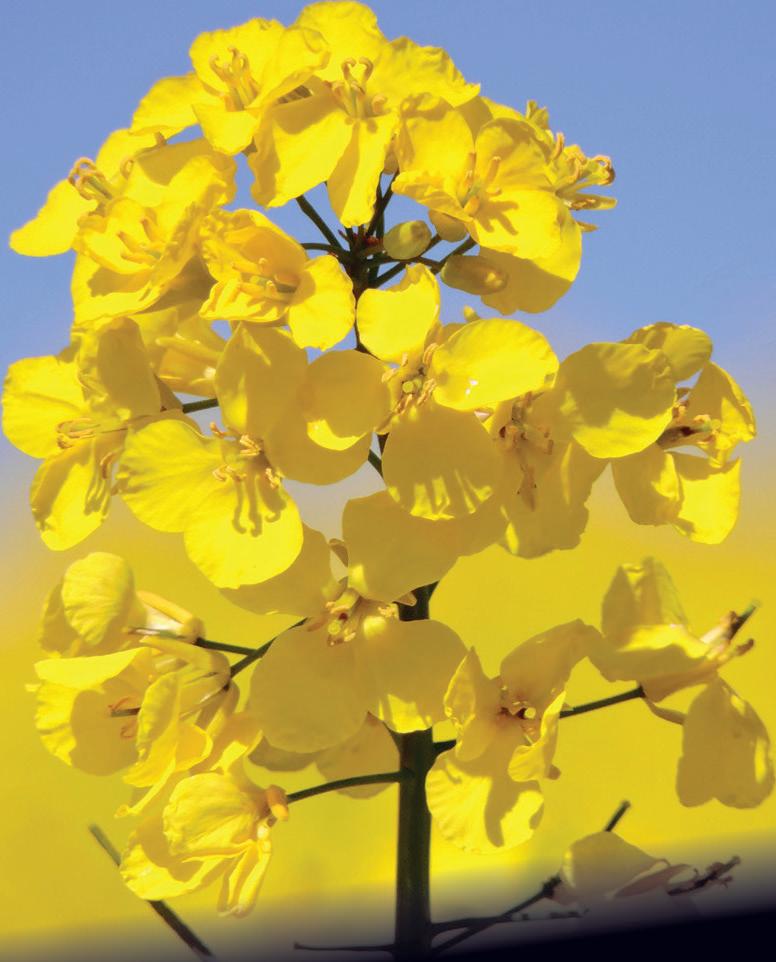
Digging deeper into those numbers reveals that at the start of the process Brazil had 107 bio-controls authorised, four years later, there were 433 products authorised and a market penetration of 10 million hectares, which grew in two years to 23m hectares and has continued to grow.
Data from 2022 shows that 40% of nematicides used in Brazil are bio-controls, as are 80% of
insecticides and 10% of fungicides, said Ms Lewis.
“What we also see is use in arable fields. If you think about the Brazilian market, there’s an awful lot of soybeans and maize and 77m hectares in total. We’re moving into arable and already we have whole programmes that are just bio-control, involving beneficial insects, microbials and biostimulants.”
Disrupt


Ms Lewis also highlighted an example from Albufera, Spain, where rice growers were supported to switch from using insecticides against rice stem borer to using pheromones to disrupt the pest’s breeding cycle.
“This was a huge programme supported by the regional government, in Valencia, the manufacturers, the farmers, the advisers - my point here is that everybody was involved. Everybody took the journey together and the results were, frankly, stunning. What they saw was a huge tail off in classical insecticide use and a gradual increase in use of pheromones and a huge increase in numbers of nesting aquatic birds. And all this while farmers
In the field Ali Capper, Kent
JAli Capper, Herefordshire apple and hop grower and chair of the NFU’s National Horticulture and Potatoes Board, called on Government to deliver a clear regulatory framework for biopesticides as well as chemical control options.

“We need clear, certain, navigable regulation and I wouldn’t say that those that I speak to in the industry feel that it is particularly any of those things at the moment,” she said.










Highest Yielding Variety for the North

lgseeds.co.uk/lg-wagner



“Brexit happened in 2016, and we transitioned out of the EU in 2020. Here we are in 2023 and there still doesn’t appear to be a clear mandate from Defra around a GB framework
for regulation in this space.
“We’re massive adopters of integrated pest management in the horticultural sector but if we have a pest or a disease that goes above a certain threshold

20 TECHNICAL BIOLOGICALS MAY 2023
LG WAGNER
were





retaining their profitability.”
In the UK a Crop Health North project has looked at reducing dependence on conventional fungicides and insecticides in wheat production, using bio-controls and was able to show that in









regulation.
three years there was very little difference between chemical and biological approaches; a result which should reassure growers in terms of the impact on yield and profitability of using biologicals, said Ms Lewis.
to react to it and we need a regulatory framework that can react quickly.
“I think we need to press our foot to the accelerator, and then speed up what GB regulation is going to look like. This is now urgent for the sector.”

There are a ‘huge amount’ of products coming up for re-registration in 2024 as their active ingredient approvals for use expire.
ALI CAPPER
we do need tools in the toolbox. We need agile regulation. Our businesses move at pace and so do the pests and so does the weather. And that means if something comes up, we need

DONE THIS YEAR” REALLY WELL FOR US

“And a third of those sit in the biopesticides space as I understand it. That is going to give CRD a real challenge - a challenge that we all need to get our shoulder to the wheel on and work out a plan of action and urgently,” said Ms Capper.
LG AVIRON FULLY LOADED HYBRID

Incredible Vigour and Disease Resistance




21 MAY 2023
Ben, Herefordshire
lgseeds.co.uk/lg-aviron
“IT’S
We need agile
Our businesses move at pace and so do the pests and so does the weather
A Fera survey identified concerns around efficacy and integration into crop protection programmes as barriers to uptake of biopesticides.
Research into a broad range of bio-solutions – both bio-controls and bio-stimulants – is revealing the opportunities they offer mainstream UK crop production. But only as part of far more integrated approaches to crop management than have become the norm. Arable Farming reports.
Bio-solutions such as pyro-glutamic and humic acids are a well-established part of crop management today, says Agrii head of integrated crop technologies, Dr Ruth Mann.

“And we can only see bio-products playing an increasingly important role in maintaining the viability of crop production as legislation and consumer pressures grow and our chemical armoury declines,” she adds.
“The more we learn about biologicals, the more we appreciate we can’t simply replace existing chemistry with them, or even just bolt them into established treatment regimes. Instead, we need to employ them in a much more integrated way, based on a better understanding of how they work in the field and where they will do so most effectively.”
Integrated solution
Agrii’s Green Horizons Initiative is aimed at improving the sustainability of UK farming. Crop management trials under the integrated whole farm solutions pillar of the initiative, across 14 different wheat varieties at three sites, show a four-spray combination of biologicals alone increasing the average untreated yield by 0.33 tonnes/hectare. At one site, though, the increase averaged 0.5t/ha. And for one particularly disease susceptible variety at this site it was 0.73t/ha.
Overall, the average three-site yield improvement from the biologicals alone in this trial series was much less than the 1.17t/ha lift achieved from a standard fungicide programme at the same timings. However, the addition of key biologicals allowed the standard fungicide rates to be reduced by a third for a very similar yield response (see Figure 1)

Fresh thinking key to unlocking biologicals’ value
“From the more than 180 different products we have tested in recent years, it’s clear that some are having a useful effect in controlling disease, improving plant performance or both,” says Agrii agronomist and biologicals business manager, Dr Mark Glover.
“Unlike the chemistry we have increasingly come to rely on over the past 50 years, the extent to
which their effect varies with variety, location, crop nutrition, soil condition and a range of other environmental factors is a key consideration. As is the whole economics of the business.
“Doing the sums on our 2021 trials still shows established chemical programmes delivering noticeably higher margins than those including biologicals; especially so where they included
the best of the new fungicide chemistry.
“That’s why we need to think differently rather than simply trying to replace conventional chemistry with biologicals – especially without sufficiently good fleld research evidence. For example, elicitors which trigger plants’ natural defences and symbiotic organisms which out-compete pathogens within the
22 TECHNICAL BIOLOGICALS MAY 2023
Trials are building up evidence around the best use of the latest bio-products found useful in managing septoria.
The more we learn about biologicals, the more we appreciate we can’t simply replace existing chemistry with them
DR RUTH MANN







USE PLANT PROTECTION PRODUCTS SAFELY. Always read the label and product information before use. For further information including warning phrases and symbols refer to label. Corteva Agriscience UK Limited, CPC2 Capital Park, Fulbourn, Cambridge CB21 5XE. Tel: 01462 457272. ®, ™ Trademarks of Corteva Agriscience and its affiliated companies. © 2023 Corteva. Univoq™ contains fenpicoxamid (Inatreq™ active) and prothioconazole. Discover more at www.corteva.co.uk Technical Hotline: 0800 689 8899 E-mail: ukhotline@corteva.com Protect now. Profit later. Univoq offers persistent, curative and protective control against all Septoria strains. Its broad spectrum disease control ensures you can secure your yield and the future of your farm. Discover more about the benefits of Univoq and our latest application advice at www.corteva.co.uk/univoq STEWARDSHIP MATTERS Unique chemistry proven to deliver robust performance and higher yields.
TECHNICAL BIOLOGICALS
plant ideally need to be in place ahead of the diseases they are combatting. So, even T0 can be too late to apply them in many cases.”
So, how can we best see the wood for the trees with the plethora of bio-solutions becoming available these days, to make sure we take as much advantage as we can from those that offer the greatest value for crop production moving forward?
Dr Mann believes it is much more about establishing the circumstances in which biologicals are most likely to deliver and developing integrated strategies to use them to greatest effect than understanding how they actually work.
“There’s plenty of published scientific literature behind many of the biologicals we test,” she says. “In most cases, we know how they work biochemically and physiologically. What we really need to
understand far more about is whether or not they work in our particular cropping circumstances. Equally, how best to adapt our management programmes to make the most of their capabilities.
“Our research is focused on identifying where particular products might have a role in integrated crop management
(ICM) programmes; in helping to protect, enhance or safen conventional chemistry; in replacing the loss of conventional chemistry; in facilitating reductions in its use; or in reducing risks from stresses linked to climate change.
“We take a thoroughly evidence-led approach to our investigations, using laboratory and glasshouse screening to identify products with the best potential and better understand how they function within the plant. This allows us to concentrate our small plot, replicated tramline and finally commercial scale farm trials on those showing the most promise.
“It’s a very complicated business, but our evaluations have become increasingly multi-factorial, taking into account crop genetics, nutrition, soil type, rotation and cultivation regime, amongst other variables. As well as exploring how the most
Biologicals news
CORTEVA STRENGTHENS BIOLOGICALS PORTFOLIO
JCrop protection business
Corteva has strengthened its position in the rapidly expanding biologicals market with the acquisitions of Symborg, an expert in microbiological technologies based in Murcia, Spain, and Stoller, one of the largest independent companies in the biologicals industry, based in Houston, USA.
Corteva first collaborated with Symborg to scale up and bring farmers the Utrisha N and Blue N nutrient efficiency optimisers under a distribution agreement between the two companies.
The biologicals market is expected to be the fastestgrowing crop protection segment in the industry, representing 25% of the overall market by 2035.
ACCESSING THE AHDB HORTICULTURE BIOLOGICALS ARCHIVE
JSince 2017 bioproduct efficacy trials have been co-ordinated across the horticultural sectors to tackle common challenges, including aphids, fusarium, downy and powdery mildews, and weeds.
Following the wind down of AHDB Horticulture, AHDB
promising biologicals behave in different environments, we are also examining how best to integrate their use with advanced risk assessment tools.”
Mr Glover adds: “Our approach to introducing biologicals commercially is very much step-by-step and always thoroughly evidenced-based too.
“We are continuing to find ways of making more of existing bio-solutions which have proven themselves through our past research and field use.
“Alongside this we are building up robust evidence around the best use of more recent products we have found useful in managing septoria – especially in the post-CTL world – and others which might better work alongside wheat varieties with reasonable septoria disease resistance ratings.”
Dr Mann’s research and development team is also tapping into the experience of Agrii’s fruit and vegetable specialists where biologicals have, of necessity, already become more mainstream, as well as exploring the role of organisms like Bacillus subtilis that have proved their worth in turf and other sectors.
In addition to the products themselves and their best timings, the way they are applied is another priority for Agrii’s evaluation programme, to ensure growers get the greatest value from them at the least possible risk.
has advised that the main outcomes of the projects Sceptre (Sceptre: Sustainable Crop and Environment Protection - Targeted Research for Edibles); SceptrePlus (Research for sustainable plant protection products for use in horticulture) and 2022-2023 efficacy trials are available on the project pages at https:// archive.ahdb.org.uk

24
MAY 2023
We need to think differently rather than simply trying to replace conventional chemistry with biologicals
DR MARK GLOVER
Average 14 variety/ three site yield (t/ha) 12 10 8 6 4 2 0
Figure 1: Wheat disease management trials 2021
(14 varieties/three sites) Untreated Biologicals only Standard rate fungicides Two-thirds rate fungicides and biologicals 9.53 9.86 10.70 10.54
SOURCE: Agrii
Communicating with the public effectively is key
Career progression can happen at any point along your route and with a record number of schools and consumers seeking opportunities to connect with farmers, there are plenty of training courses and educational initiatives available.


Visit My Farm
Developed in collaboration with educational partners and supported by some of the leading agricultural stakeholders, Visit My Farm has advice and educational courses for farmers.
■ Visit visitmyfarm.org
Cevas Training
The Countryside Educational Visits Accreditation Scheme is a detailed training programme aimed at those wanting to provide on-farm education or farming experiences for schools.
■ Visit visitmyfarm.org
Farmer Time
A unique initiative for farmers to engage with schoolchildren through video calls to educate on the journey from farm to fork.

■ Visit visitmyfarm.org
Leaf Education
Get access to courses, advice and training materials to begin or continue the journey of promoting appreciation for British farming in every day life and inspire the next generation.
■ Visit leaf.eco/education/for-farmers/ get-involved
Advice guides
WE are producing a series of downloadable advice guides about how better improve communicate with consumers and how to recruit and retain good staff.
■ For more information, visit FGinsight.com/ThisIsAgriculture

Cevas Plus
Cevas Plus is a refresher course for those who took the qualification more than two years ago and who want to update their knowledge and skills surrounding educational visits on-farm.

■ Visit visitmyfarm.org/courses
Speakers For Schools
Delivered by NFU Education, farmers are offered presentation training to deliver to local secondary schools. The 45-minute session provides media content, quizzes, farm myth-busting and opportunity for discussion and questions.
■ Visit education.nfuonline.com/ SpeakersForSchools

Educating children is vital towards a positive future for British farming.
For the full video scan the QR code or visit youtu.be/FDToRER3TLg
25 MAY 2023
Catherine Wilkinson on Farmer Time
It is so different to other parts of the curriculum... it offers children context into what they are learning and how it fits into our lives
CATHERINE WILKINSON, teacher at Washingborough Academy in Lancashire
Farmers practising minimum or no-tillage will be sequestering significant carbon in their soils. With the carbon credit market offering opportunities to capitalise, Martin Rickatson reports from a Sussex estate open day outlining paths to maximise capture and credits.
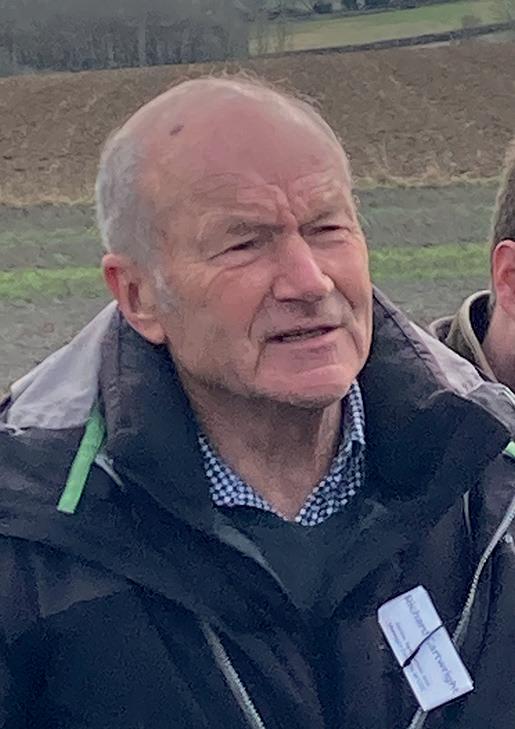

Farming carbon as a crop

Carbon certification schemes could help insulate against arable income uncertainty by providing an additional revenue stream from the sale of carbon certificates – or their retention to prove carbon responsibility to, and earn bonuses from, produce buyers – while enhancing sustainability and resilience of both soils and businesses through the practices required to join them.
That was the cross-presentation message from a ‘carbon farming’ day at a Sussex estate targeting carbon neutrality. Organised by co-operative Fram Farmers, the event was co-hosted by carbon certification company Agreena, which oversees certification on more than 500,000 hectares in 15 countries.
Richard Cartwright, agronomist for the 1,200-hectare host Iford Estate, said that beyond the reduced soil movement approach to crop establishment adopted by estate managing director Ben Taylor, the two have worked together to adopt a number of other techniques to minimise carbon release during the cropping year.

Future use
Mr Cartwright said: “Ben focuses on the estate as a whole, recognising the variability in its land, and that’s leading to consideration of the best future use for poorer areas, which may be better reverted to downland or planted to trees.
“But while much is thin, flinty chalk, we still achieved a 12 tonnes/
ha milling wheat average last year despite the drought, and I’d put some of that down to the regenerative, carbon-capturing practices Ben has adopted, from minimal soil disturbance to extensive use of variety blends. A blend of Crusoe, Illustrious and Zyatt is used extensively to provide a mix of disease resistance qualities and protein performance and has helped achieve good milling wheat yields at target protein levels,” he said. There is also spring barley in the rotation and this year much of the area is down to Null-Lox variety CB Score.
“This is providing a direct example of reward for meeting a buyer’s environmental requirements, in that it’s earning a significant premium for the minimal carbon way it is being produced, based on assessments including deep nitrogen testing, use of a cover crop beforehand, and a commitment to three different crops in five years. This is the first time the estate has been rewarded directly for changing its farming practices,” says Mr Cartwright.
Iford is performing regular assessments and taking deep nitrogen samples to better assess
What if you are a tenant farmer?
JSavills’ Tom Brunt addressed how tenant farmers and those involved in contract farming approach the issue of carbon credits, suggesting early dialogue was essential.
“Before making any decisions or commitments, talk with the landowner and work out where each of you stands in terms of reward in relation to yearly and ongoing farm activities and practices. You then have a good footing from which to calculate the rewards each of you may
take for carbon capture.
“I’m quite relaxed about annual carbon credit sales based on farm tenant management techniques –they’re part of the farmer’s annual income from the land resulting from those practices. But landlord communication is crucial, particularly if your carbon plan exceeds the length of your tenancy and beware that many new tenancies contain clauses concerning carbon credit rights being reserved to the landlord.”
26 TECHNICAL CARBON FARMING MAY 2023
Iford Estate manager Ben Taylor is working to minimise carbon release and earn a premium for meeting buyers’ environmental requirements.
While much is thin, flinty chalk, we still achieved a 12t/ha milling wheat average last year
RICHARD CARTWRIGHT
YieldON switches “ON” crop profitability This revolutionary biostimulant contains a unique blend of natural plant extracts – which stimulate the flow of nutrients into seeds for higher yields. In UK trials over 3 years, YieldON increased wheat* yields by 0.47 t/ha on average Oilseed rape** and barley* trials showed yield increases of 0.33 and 0.37 t/ha respectively

YieldON is available from Hutchinsons (www hlhltd co.uk) and Agrii (www.agrii.co.uk)
For further information, email technical.uk@valagro.com www.valagro.com
*single application of 2 litres/ha at flag leaf growth stage; **single application of 2 litres/ha between early to mid-flowering.
the effect on residual N of reduced ground movement, the use of cover crops and a wider cropping mix. Cover crop seed, including linseed, phacelia and buckwheat, is being home-grown.

“But we have experienced some cover crop challenges,” said Mr Cartwright.
“Increased slug activity is the primary one, especially on heavier ground in wet autumns. Harbouring other pests such as leatherjackets and wireworm and the BYDV risk is also a concern. But I think overall they [cover crops] have significant value.”
Danish firm Agreena’s carbon programme is audited by, and works to, the carbon measurement standards of Verra, which manages the Verified Carbon Standard, claimed to be the world’s leading voluntary carbon markets programme. Thomas Gent, Agreena’s UK market lead, suggested carbon farming offered both business resilience and revenue benefits.
“Certificates earned by proving carbon sequestration can be retained – perhaps to offset against another business the farm operates, or to prove sequestration to a commodity buyer, potentially resulting in a premium. Alterna-
tively, they can be sold by the farmer, or marketed through Agreena. Buyers are those companies seeking carbon certificates to offset their unavoidable emissions because they face greater challenges cutting them. Our farm programme has so far accounted for 700,000 tonnes of CO2,” he said.
Certification
To prepare for certification assessment with Agreena, farmers are required to provide details of the fields they choose to enter, to allow the measure-
Conventional fertiliser alternatives
JThere are alternative fertilisers whose manufacture and use both create far lower CO2 emissions than conventional types, suggested Alex Hammond, of CCm Technologies.

The company captures CO2 from industrial power generation to stabilise a variety of materials, such as ammonia and phosphates from agricultural and industrial waste streams, and uses them to create new fertiliser products with significantly lower carbon and resource footprints.
The waste CO2 is utilised by reacting it with ammonia to form stable nitrogen,
which is then blended with a fibrous material. Additional CO2 stabilises volatile chemicals within this, said to improve nutrient delivery within the eventual fertiliser pellet.
The business also recovers ammonia from the waste sector, including water and food manufacturing. CO2 is used to react with this to form stable nitrogen compounds, which are used to boost fertiliser nutrient content, with further benefits said to include reduced leaching and volatilisation.
Mr Hammond said: “We use recovered nutrient sources,
ment of factors such as soil carbon content, plus details of how fields have been and will be managed, including soil types, cropping, fertiliser applications and work operations. This data is entered into a scenario planning tool that calculates each field’s carbon emissions, and the number of carbon certificates it should yield.
Mr Gent says: “Post-harvest, farmers report each field’s actual activities versus planned – crop type, operations, yields – supported by satellite imagery, data analysis, soil sampling and random
field inspection. Results are entered into our computer modelling, measuring carbon production activities such as emissions from diesel and fertiliser against carbon sequestration activities, such as cover cropping, no-till and residue management, adding values for each. This helps calculate the resulting number of certificates, each representing the equivalent of one tonne of CO2. It’s technically possible to obtain up to three certificates per hectare, but most farms average one to two, each an annually-produced, tradeable asset with a £25-50 market value.
including food waste, to act as a substrate for the added nutrients within the process, further improving nutrient delivery and locking additional carbon into the soil.
“Manufacturing data collection ensures full traceability of process and feedstock data, to help all interested parties from crop buyers to carbon verifiers and improve traceability of related carbon emissions.
“The fertiliser sequesters organic carbon into the soil, storing it permanently for at least 20 years, and as a result improving soil
structure, permeability and soil biodiversity. This improves overall soil health, which leads to better yield production. The sequestered carbon can also generate a commercial carbon credit value. For every tonne of CCm fertiliser, approximately one tonne of CO2 equivalent can be sequestered.”
He suggested the food waste/digestate-based pellets have sufficient consistency and structural integrity to be spread at up to 36m.
“Once on the soil surface, breakdown and nutrient release is triggered slowly by moisture, even in heavy rain.”
28
MAY 2023
TECHNICAL
Thomas Gent
Successful cover crop establishment has sometimes proved challenging at Iford Estate, but is just one tool being used to reduce carbon emissions.
rAgreena will be exhibiting at The CropTec Show at the NAEC Stoneleigh, on November 29-30. For more, go to croptecshow.com
“Once issued, the farmer chooses each year whether to trade them personally, trade them via Agreena – the current most common choice – offset them against other business activities or use them to earn a premium for crops produced, or retain them.
“Currently we’re only able to


Cover crops
JBeyond their soil and nutrient preservation properties ahead of cash crop planting, cover crops can play a significant role in helping sequester carbon, suggested Ian Gould, of seed mix specialist Oakbank.
“They not only help prevent soil, nutrient and moisture loss, but also yield a return in carbon sequestration, particularly where this is certificated. Used correctly, the right mix can help reduce workload and carbon output as rooting reduces cultivation needs. Some species cycle carbon within the soil in the form of glomalin, a sugary carbon exudate from root hairs which binds silt, sand and clay and helps open up storage space for water, air, nutrients and decaying biological matter which contains carbon.
“You cannot make your farm bigger horizontally without acquiring land, but you can do so vertically, increasing its depth
assess cropped areas of fields, but we hope to develop this to account for carbon capture by land under hedges, woodland and permanent pasture.
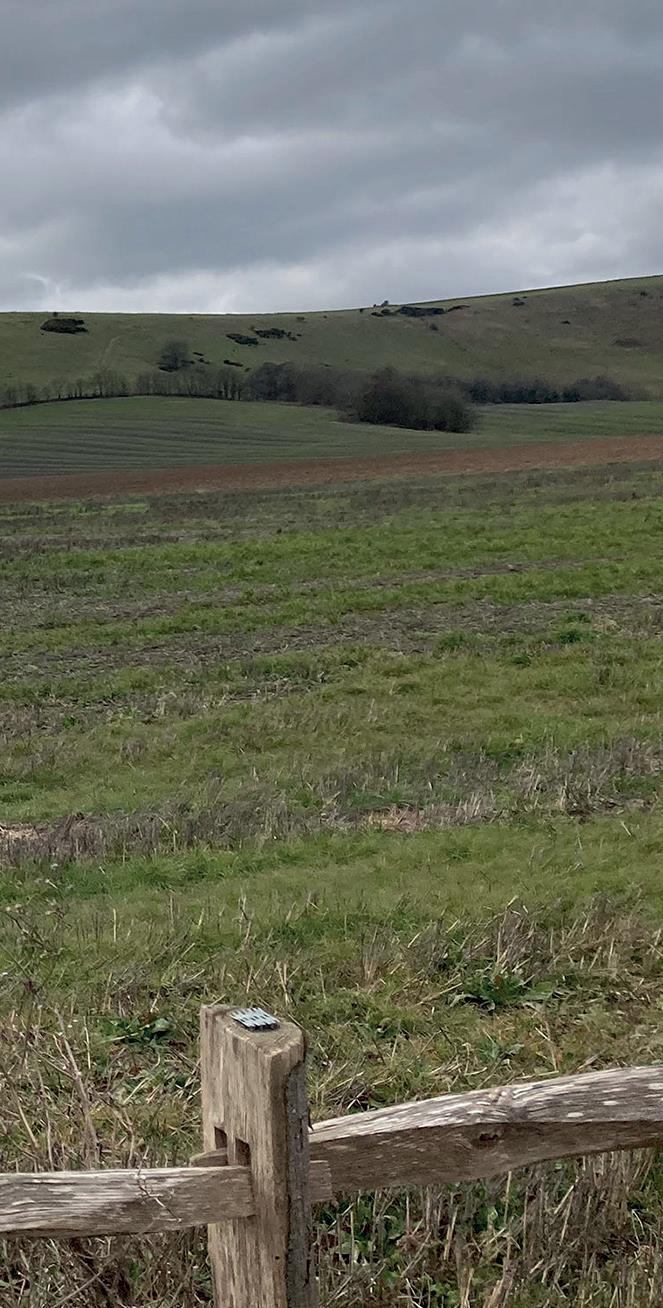
by building soil through creation of humus, which captures and retains nutrients, water and carbon. This is what the best cover crop mixes ultimately create.”
Consult
Mr Gould urged farmers to consult their agronomists before committing to cover crops, taking their advice and starting on a manageable scale.
“First identify your goals. They might include moisture retention on light land, but on heavier ground could conversely be focused on drawing moisture from wet soils. Even the best cover crop will not sort drainage problems, though. Address these first if necessary.”
Once key cover crop aims have been identified, species and mix selection can be made, he suggested.
“Multi-species mixes, combining the likes of vetches,

“To underline our alignment with Verra standards, we have a premium pool that stores 10% of issued certificates, acting as a farmer incentive to long-term
phacelia, linseed, cereals and buckwheat, will feed different soil biology, which will further aid carbon capture, but also consider the characteristics of different varieties. Biomass production is one of the biggest indicators of benefit – the bigger the plant the bigger its roots and the more nutrients it will retain.
“Establish crops as soon as possible post-harvest to preserve moisture, and drill rather than broadcast where possible, treating the crop as you would a cash one.

“Once up, cover crops will help prevent rainfall impact on soil, slowing it and aiding infiltration. Improved drought resilience and reduced plant stress in following crops are often noticeable within two to three years of adoption, particularly beneficial at tillering and grain fill, where seven-10 days delay in drought stress can make a big difference.”
commitment to good practice. This 10% is forfeited should the farmer choose to leave the programme, but there are no other penalties for doing so,” said Mr Gent.
29 CARBON FARMING TECHNICAL MAY 2023 EFFECTIVE cropscience.bayer.co.uk/roundup n Rainfast from 1 hour n Proven reliability in plant uptake and translocation n Excellent performance in challenging spring and summer conditions n Modern drift-minimising formulations Proven Effective Dependable For further information, visit www.cropscience.bayer.co.uk/roundup, or call 0808 1969522 for technical enquiries. Roundup is a registered trademark of the Bayer Group. Roundup contains Glyphosate. USE HERBICIDES SAFELY. ALWAYS READ THE LABEL AND PRODUCT INFORMATION BEFORE USE. © 2023 Bayer Group. All rights reserved.
CropTec exhibitor
New rules on the use of urea fertilisers will be implemented from next spring, Defra has confirmed. Alice Dyer reports.
Urea rules will come into play next spring
New rules mean most urea applications to England’s crops after April 1, 2024 must include a urease inhibitor if containing more than 1 per cent urea.
Farming Minister Mark Spencer said that the new legislation, which was pushed back a year to help growers ride the fertiliser price hikes caused by the conflict in Ukraine, was essential to ensure that emissions of ammonia are reduced as part of the UK meeting legally binding targets which it is at risk of breaching.
Defra had been exploring an outright ban on urea, but following consultation came to an agreement
Application information
JThe new rules mean fertiliser containing urea must only be applied where the following requirements are met in England:
rUnprotected/uninhibited solid and liquid fertiliser containing urea can only be applied between January 15 and March 31
rUnprotected/ uninhibited liquid fertiliser containing urea can only be
that it would allow the industry to self-regulate, termed ‘Option 4’.
In a meeting with industry stakeholders in March, Mr Spencer confirmed that the self-regulation scheme proposed by the farming industry scheme would be incorporated into the Red Tractor farm assurance scheme. He warned that if the industry scheme was not implemented, the Government would regulate to ensure compliance.
The long-awaited decision comes after the Agricultural Industries Confederation (AIC) wrote to Secretary of State Therese Coffey last month requesting an urgent clarification ahead of the new season.
Because any industry approach needs to be auditable, Red Tractor was asked to support the industry and deliver value for scheme members by helping demonstrate responsible use of untreated urea fertiliser.
Uptake of the scheme will be monitored through fertiliser sales and treatment data, Red Tractor monitoring data, and the British Survey of Fertiliser Practice.
Monitoring
This will establish whether the ammonia abatement expected is achieved. In addition, Defra will gather relevant data to monitor and assess the level of ammonia abatement achieved by the scheme. A decision on whether new legislation is needed will likely be made in 2025/26.
its value stretches further when you consider its role in keeping the UK market competitive and minimising nutrient leaching risks associated with early season use of ammonium nitrate.
“With the Government’s Clean Air strategy targeting, among other things, reduction in ammonia emissions, farming must demonstrate we can play our part in reducing emissions while maintaining competitiveness. Demonstrating responsible use of urea fertiliser will show government that we can act responsibly and hopefully open the door to other industry-led solutions,” Mr Bradshaw adds.
Businesses found not to be complying with Option 4 by Red Tractor will be required to undertake the BASIS module: Reducing Ammonia Emissions.
applied between April 1 and last application in autumn if agronomic justification is provided by FACTS-qualified farm personnel or advice specific for the crop has been provided by a FACTS-Qualified Adviser and been followed
rIn Northern Ireland, Scotland and Wales fertiliser containing urea can be applied as per relevant legislation
Source: Defra
NFU deputy president Tom Bradshaw says: “We have informed Defra that the industry self-regulation approach to the use of uninhibited urea fertiliser under a new Red Tractor standard will be enforced from April 1, 2024.
“The NFU and industry partners fought hard for nearly two years to achieve a robust and pragmatic industry-led approach, without this, the clear proposal from Defra was an outright ban on the use of uninhibited urea fertilisers.
“Using uninhibited urea saves farmers £13.8 million annually and

The NFU says the module, which has been funded and developed in collaboration with AIC, AICC, CLA, NIAB, Red Tractor and NFU, is designed to give farmers the knowledge and tools to reduce ammonia emissions from both manufactured fertilisers and organic materials in livestock housing, storage and when applied to land.
Before the introduction of Option 4, the NFU is urging all members to complete the BASIS module: How to Reduce Ammonia Emissions from Farming.
30 TECHNICAL CROP NUTRITION MAY 2023
From April 2024 unprotected urea cannot be applied to crops in England.






Call us on 01799 533700, or visit us at ragtseeds.co.uk HYBRID WINTER
RGT Kanzzas.
2022/23.
shatter resistance
the standard for LLS resistance
maturity with very vigorous Autumn growth
stem canker resistance
height variety with very stiff straw think OSR think RAGT Thought you knew RAGT OSR varieties? We have news for you, our portfolio is getting wider!
OSR RGT KANZZAS
Candidate List
Pod
Raises
Early
Excellent
Medium
EXCLUSIVE
How digital tools can inform disease management strategies
Disease management can be challenging, but digital tools can help translate complex data into simple insights. Teresa Rush reports.
Every grower and agronomist wants to make the best use of fungicide inputs, but with so many variables involved, seemingly small changes can make a big difference either way to the bottom line. Digital tools can help support disease management in three key ways - through monitoring and comparing fungicide performance; through helping inform fungicide timings and lastly through supporting decisions around application.
That is according to Bayer digital campaign manager Max Dafforn, who explains, for example, how using satellite imagery in conjunction with tramline trials can be a useful tool for monitoring product performance in the field simply by highlighting differences in crop greening.

That analysis can be taken a step further with Bayer’s FieldView platform by capturing data from the sprayer, to do, for example, a side-by-side tramline comparison of a new fungicide product versus the farm standard.
“The nice thing about FieldView is you can capture data directly from the sprayer, which means when you carry out trials like this and they’re very easy to do – you are not having to go and set canes out in the field or remember where you did one treatment or another. You know as soon as you capture that data, that you can go and revisit those points and later on when you’re
combining you know where you’re driving into those different treatment areas.
“And the next benefit is that once you capture the yield data, you can overlay that data on top of the spray data. So, in order to do the yield analysis, it’s simply a case of tapping on product A, tapping on product B and getting a yield result from those different areas. It makes conducting tramline trials really accessible, really easy without having to use complicated software.”
Tramline trial
One FieldView user, for example, conducted his own tramline trial with four different products, says Mr Dafforn.
“He was looking at new chemistry on the market and how it compared. The data was captured directly from the sprayer and overlaid with the yield map. Very quickly, within moments of the combine leaving the field, he could start doing the analysis.”
A second area where digital technology is supporting disease management is in the field of digital decision support tools. With several factors to take into consideration in fungicide programme decision-making it is an area perfect for digitalisation, maintains Mr Dafforn.
“Information can be fed into an algorithm that can support those decisions, taking out some of the subjectivity,” he says.
Data sources include disease risk assessments derived from digital disease risk models; phenology models used to monitor growth stage or leaf layer emergence and weather data.
“So, weather forecasts are feeding in. And then you’ve got crop variety, drilling date - all of these can feed into an algorithm, which will then support a decision on disease management. And that algorithm can have a very simple interface, whether it’s a disease dashboard or a risk alert allowing the agronomist to prioritise where they focus, where they go crop walking first and prioritising which fields need spraying first.”
Mr Dafforn cites another example of a FieldView user
mulling over whether or not to apply a T4 fungicide. In the end, the grower decided to use FieldView to compare areas where a T4 was applied with areas that were left untreated.
“With FieldView it was very easy then to overlay that application data with the yield data and with this example we in fact got just over 4.5% yield benefit from the T4. It makes it easy to evaluate additional inputs or omitted inputs rather than going out and putting an application on and then having a gut feel about the response – it’s actually being more scientific and getting a tangible result.”
Satellite imagery
And the third area, currently being evaluated, is using satellite imagery to derive absolute crop biomass values which are used to identify any variation around a normal biomass level - at T1, T2, T3 fungicide timings, for example. This variation is then used to deliver a consistent rate of fungicide across the field.
“The theory behind this is that each kilo of crop receives a consistent dose of active ingredi-
32 TECHNICAL PRECISION FARMING MAY 2023
That algorithm can have a very simple interface, allowing the agronomist to prioritise where they focus
MAX DAFFORN
With FieldView it is easy to overlay application data with yield data to evaluate variations in inputs, says Max Dafforn.
inform strategies

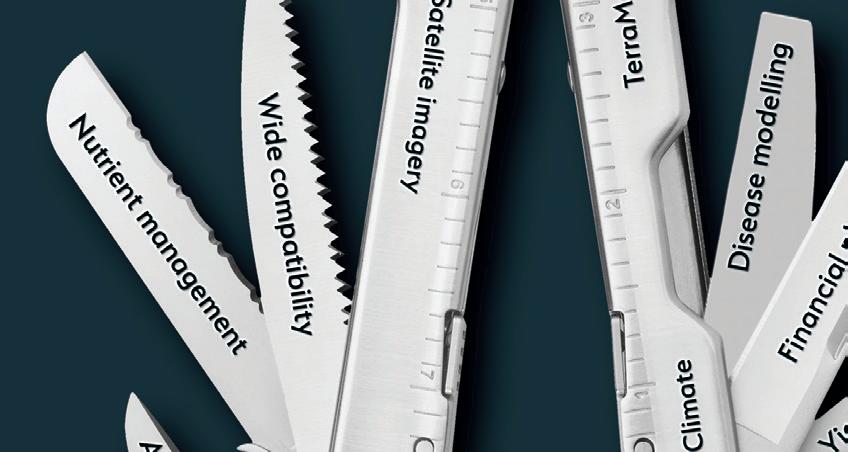

ent. This is something our colleagues in Denmark have been testing. The logic behind it is that where you have got higher biomass there will be more plants, more leaves, there will be more disease and a different microclimate in the crop canopy, which would justify a higher fungicide rate.

“There are already tools and services that are offering this kind of functionality in the market and what we’re interested in is putting a bit of science behind that, and doing something to evaluate what impact it has and whether this approach adds value for growers,” concludes Mr Dafforn.


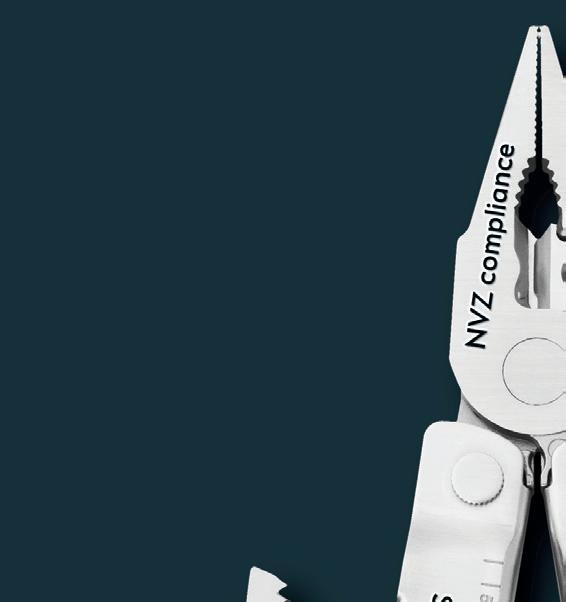

33 PRECISION FARMING TECHNICAL MAY 2023
Open out the full potential of precision agronomy visit: www.omniadigital.co.uk to sign up for free
By capturing data from the sprayer, FieldView can be used to do tramline comparisons of fungicide inputs.
C M Y CM MY CY CMY K 6833_Omnia Ad 210x139_ART.pdf 1 20/12/2022 10:51
Omnia is the most versatile platform on the market
Could plant breeding provide
Establishing a series of on-farm trials has helped one Yorkshire farmer better understand the behaviour of slugs in a bid to tackle burdens in a post-metaldehyde era. Charlotte Cunningham reports.
Slugs present a huge challenge for Yorkshire grower Graham Potter, routinely wreaking havoc on his 200-hectare arable farm near Topcliffe, North Yorkshire.
Mr Potter grows 89 hectares of first and second wheats, 50ha of high erucic acid oilseed rape, 45ha of spring barley and 95ha of cover crops, with 9ha put to permanent grass to host a music festival once a year.

All operations are run on the John Deere RTK system at 2.5cm accuracy, with controlled traffic practised on all the land. For crop establishment, Mr Potter has been using the Claydon system for about 10 years.
“This works a bit like strip-till really – we’re not moving a lot of soil,” he explains.
“We haven’t gone the full direct drill route yet, not that our land is ready for it, but the biggest problem is that these
drills are very expensive. So, we’ve chosen to stick with the Claydon system, and it works very well.”
Away from the farm, he runs a contracting business, carrying out operations including drilling

and combining, and is a lead farmer for Yorkshire Water’s Sustainable Landscapes programme.
“My main role as part of this is to try and improve water quality with direct drilling and cover cropping. Our eventual goal is to try to go carbon neutral,” says Mr Potter.
Approach
Despite his success with the Claydon system, Mr Potter says that back in 2019 he was noticing quite a lot of slug damage as a result of his minimal soil movement approach.
With the metaldehyde ban on the horizon at the time, he began looking into other control options, only to find research on slug control was very limited.
“There weren’t many people doing a great deal of research
out there – everyone was basically just whacking some slug pellets on,” he says.

When the ban came into force, Mr Potter saw an opportunity to look more holistically at how he could improve slug control on his farm.
“I thought it would be good to start doing my own studies on the job to better understand the ways in which slugs can be controlled and more about slug behaviour to optimise these measures.”
The first trial took place after oilseed rape harvest in 2019 and involved sowing a small amount of wheat in a field badly affected by slugs.
“We tested out the theory that rolling twice would have an impact on slug burdens,” says Mr Potter.

34 TECHNICAL SLUG CONTROL MAY 2023
Soil mapping has enabled use of variable rate slug pelleting maps to prioritise soil types known to be preferred by slugs.
As a group we’re learning a lot about slug behaviour
GRAHAM POTTER
Graham Potter’s first on-farm slug control trials looked at the impact of rolling on slug burdens.
Farm facts
r200-hectare arable farm























rGrowing 89ha first and second wheat, 50ha of high erucic acid oilseed rape, 45ha of spring barley and 95ha of cover crops
r9ha put to permanent grass to host a music festival once a year








This theory was based on the knowledge that open, cloddy seedbeds expose germinating seedling to slug damage, while a more consolidated soil helps to protect crops, he adds.


“We double rolled some of it, single rolled some, and we left some unrolled. Within the wheat that hadn’t been rolled there was a massive difference – the slugs were eating it like mad and hollowing the seed. There was a lot of noticeable activity.”
Damage was not as severe where the wheat had been rolled once, recalls Mr Potter, but where the greatest success was seen was in the double rolled block.
“We went at 90 degrees, got a really good



soil-to-seed contact and closed up that trench in which slugs like to move about. It certainly made a lot of difference.”
Change

This marked the start of a change in farm practices, with Mr Potter now ensuring that all high-risk slug fields are double rolled. From here, he began exploring the potential of using biologically-derived materials to control slugs by exploiting their perceived repellent properties. Specifically, he trialled the use of recycled gypsum.


“It tends to dry things out, which has a good effect on the land, and certainly has helped with our slug problems,” says Mr Potter.

Stubble management has been another area of investigation. Mr Potter has found that taking advantage of peak slug activity time, with regards to how stubbles are managed, can help minimise damage.
“We’ve got the Claydon TerraStar and the Claydon stubble rake and we now tend to go out with them at nighttime, when the slugs are on the surface. This doesn’t necessarily
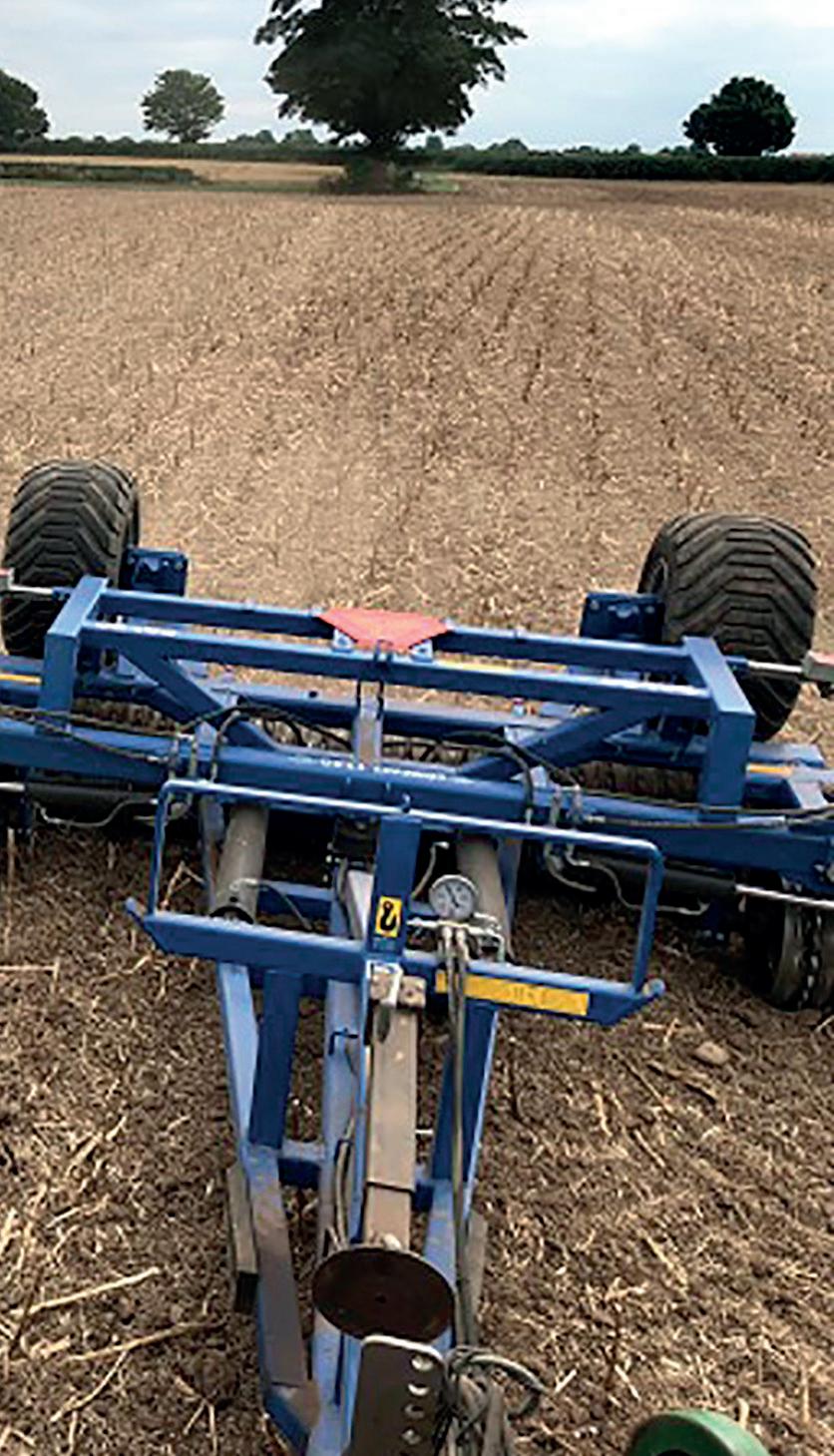

1 2 3














35 SLUG CONTROL TECHNICAL MAY 2023 Future proofing your Cereal Disease Control Effective against septoria in wheat and rhynchosporium and ramularia in barley ARIZONA The essential multi-site fungicide ARIZONA POWERED BY MSI Protech Visit www.adama.com/uk for more information ADAMA Agricultural Solutions UK Ltd. Third Floor East, 1410 Arlington Business Park, Theale, Reading RG7 4SA Telephone 01635 860 555 UKenquiries@adama.com ARIZONA® is a registered trademarks of the ADAMA group. ARIZONA® contains 500g/L (39.5% w/w) folpet. Always read the label and product information before use. For further product information, including warning phrases and symbols, refer to www.adama.com/uk or call The Technical Helpline on 01635 876 622. CONTROLLING CEREAL DISEASES FOR LONGER PROTECTING SINGLE-SITE CHEMISTRY MAINTAINING YIELD AND PROFITABILITY
PARTNER (500g/L folpet) ARIZONA THINK multi-site first... 0542_ADAMA_Arable Farming_Arizona Disease Control Ad_121x170.indd 1 17/02/2023 11:21 provide a slug threat solution?
Feeding trials at John Innes Centre identified the landrace wheat variety Watkins 788 as a wheat that was consistently spurned by slugs.
control them, but it does disturb them.
“We’ve also changed our seed dressings,” he adds.
“We used to use Redigo Deter (prothioconazole + clothianidin) but have now moved onto Vibrance Duo (sedaxane + fludioxonil), which gets the crops up and out the ground quickly. My theory was that the quicker that they were up, the less chance slugs would have.”
As a last resort, Mr Potter uses slug pellets as part of his control programme but applies them at a variable rate.
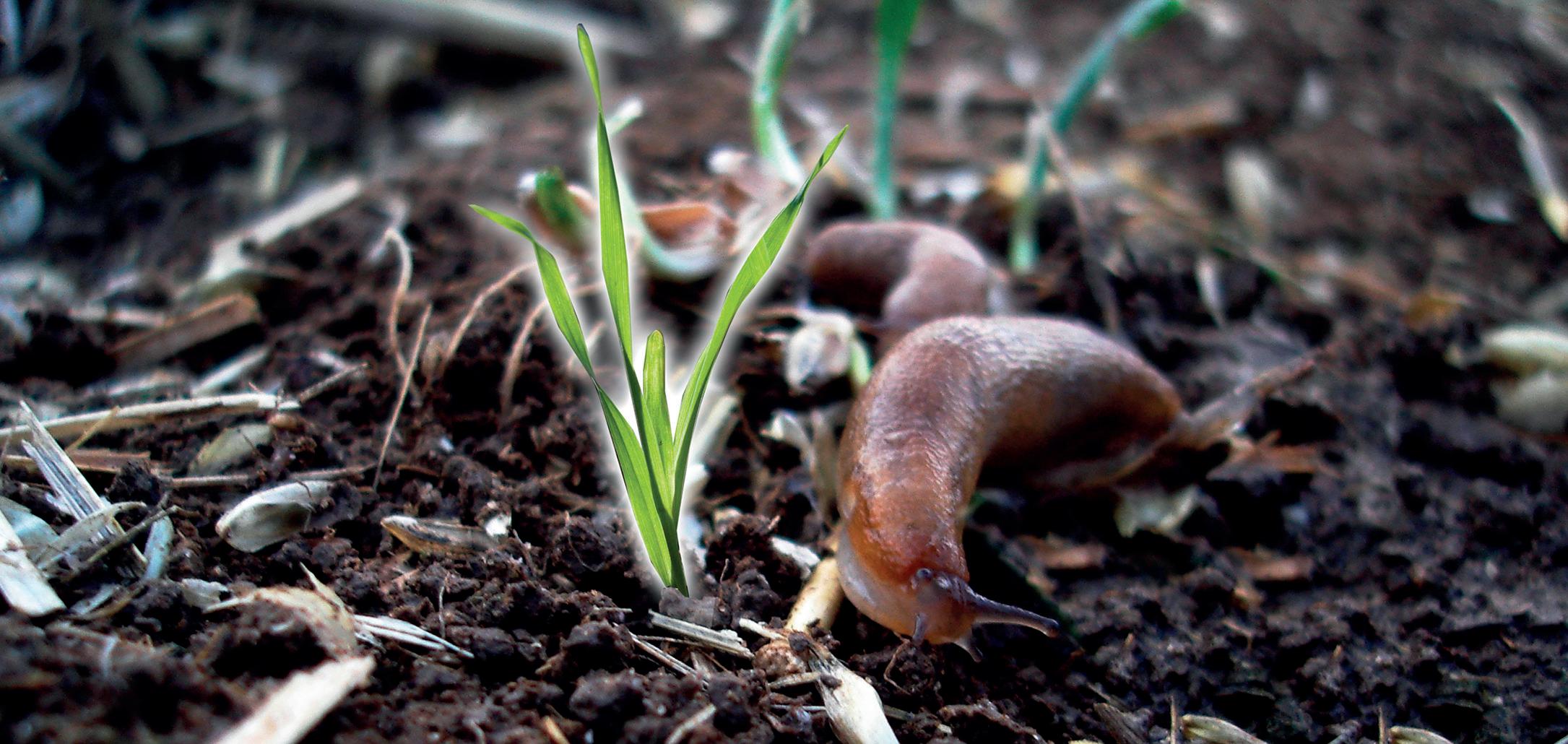
“A few years ago we had the whole farm conductivity tested and found that we can go from blowaway sand to heavy clays,

BOFIN
rThe British On-Farm Innovation Network (BOFIN) was founded in September 2020 by Tom Allen-Stevens to represent farmers who carry out their own on-farm trials rThe network currently has over 400 members, 65% of whom are farmers. The rest are scientists, knowledge exchange managers, industry innovators and the ‘just curious’
all in one field. Variable rate slug pelleting maps then allow us to prioritise the soil types we know slugs prefer.”
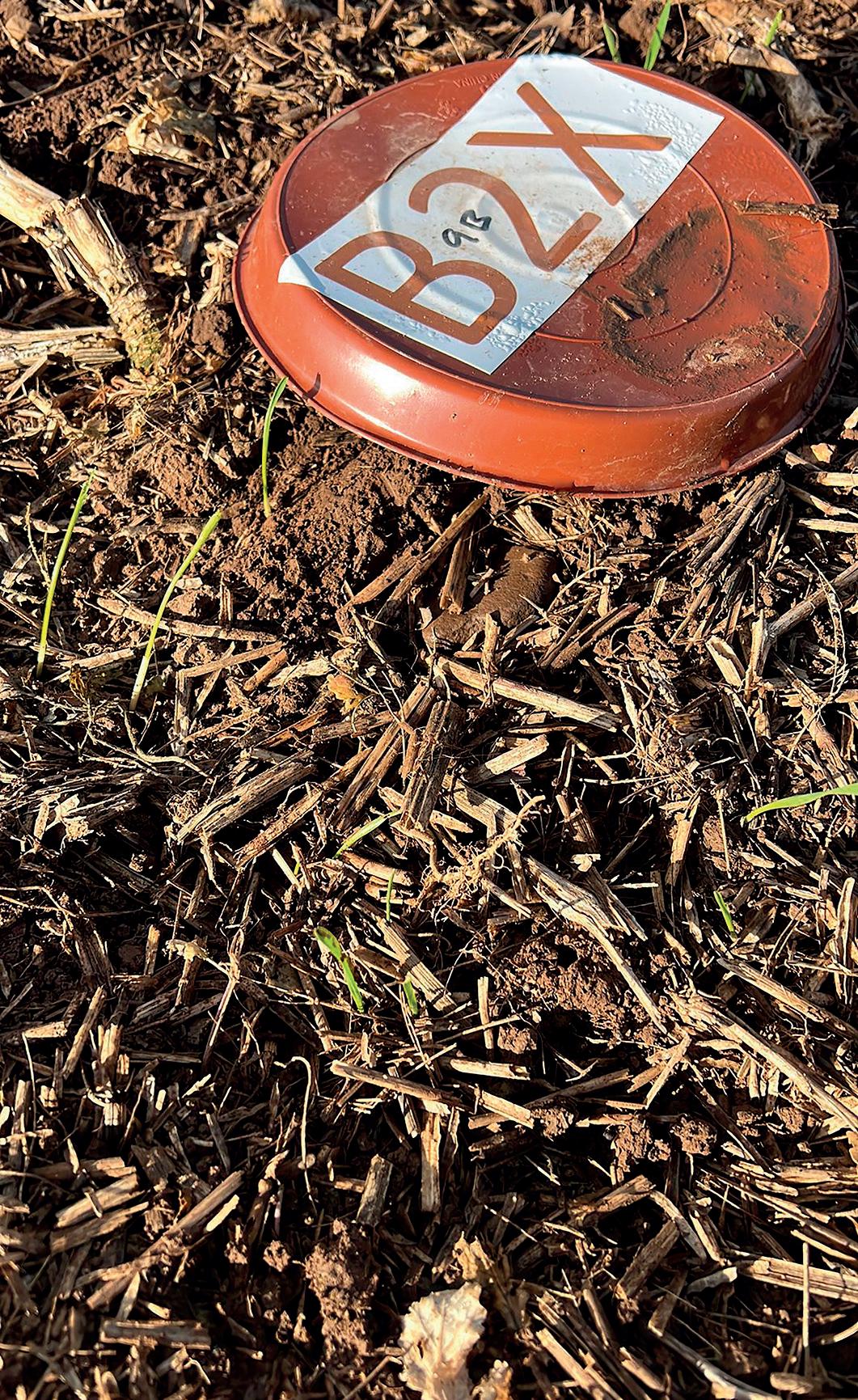
National trial

Keen to learn more about slugs and slug management on both his own farm and further afield, Mr Potter recently got involved with a national trial pioneered by the British On-Farm Innovation Network (BOFIN) which aims to explore the role of a wheat variety claimed to be resistant to slugs in managing grazing damage to the crop.
Mr Potter is one of 10 ‘slug sleuths’ – farmer members of the network – who have established a trial plot of
Watkins 788, a landrace wheat variety never grown before on commercial farms in the UK, as part of the Slug-Resistant Wheat project. This was compared with their farm standard wheat variety and the farmers
monitored the plots closely for slug activity.
Feeding trials at John Innes Centre as part of the Defra-funded Wheat Genetic Improvement Network (WGIN) had previously identified Watkins 788 as a wheat
rMembership of BOFIN is free and there is no obligation to carry out on-farm trials, or to get involved. But for those who do, the aim for BOFIN Farmers is to seek a more scientific approach to on-farm trials. The network seeks to encourage collaboration, discussion, and offer a platform to share ideas and for these to be valued rFind out more at bofin.org.uk
36 TECHNICAL SLUG CONTROL MAY 2023
Refuge traps were placed in plots of Watkins 788 and farm standard variety KWS Dawsum.
The Slug-Resistant Wheat project – key facts
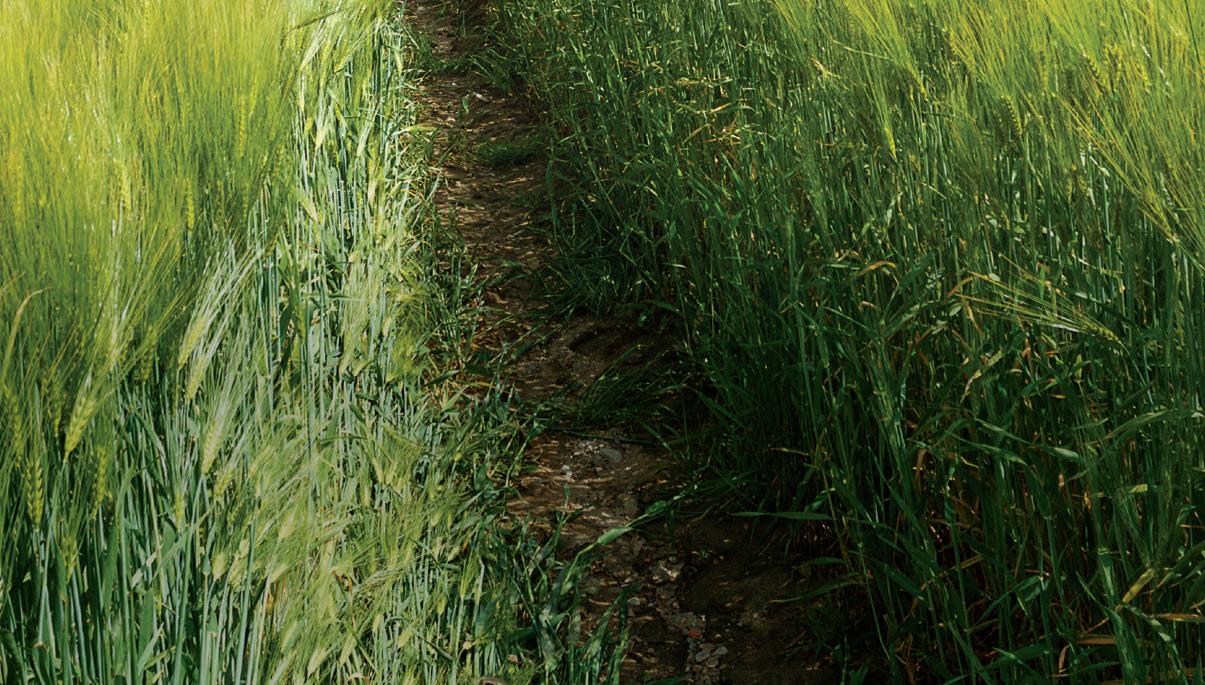


rProject started in April 2022, led by BOFIN and supported by the Environment Agency as part of its Environment Programme
rBased on research indicating that landrace wheat variety Watkins 788 may contain a slug resistance trait
r2022 trials involved 10 farmers from across England contracted to establish two plots of Watkins 788 wheat and compare them with two farm-standard wheat plots to assess slug damage
rRecord low slug populations last autumn meant that the 2022 results were inconclusive, with no plots suffering extensive slug damage
that was consistently spurned by slugs. This was confirmed in a field trial, but the plot was small because of limited seed availability. The aim of this national network of trials was then to see if the same effect was observed across sites in larger plots.
Farmers involved in the trial followed a protocol developed by BOFIN with Prof Keith Walters, professor of invertebrate and pest management at Harper Adams University, who also analysed the results.
Plots
It involved drilling four 24m by 24m plots within a first wheat crop, which had followed oilseed rape, in a field known as being problematic for slugs, explains Mr Potter.
Two of these plots were put down to the Watkins 788 variety and the other two to KWS Dawsum, which is the standard variety on Mr Potter’s farm. Two slug refuge traps were placed in each plot and monitored twice a week, and half the area was treated with slug pellets as a control. The trial area was repeated within the
rHowever, the project proved a success in how plots were established and monitored, and the 10 farmers have been credited with delivering the trial to the standard expected from professional trials technicians
rThe trial will be repeated this summer and will also look at a KWS Santiago x Graham line, bred by John Blackman, that may have a similar property
rMore farmers are needed to progress the research, with BOFIN calling for farmers to sign up as ‘slug sleuths’ to capture and send in grey field slugs for further feeding trials
rVisit bofin.org.uk for more information
same field, this time comparing Dawsum with a pre-commercial variety, bred by John Blackman, which is also believed to be less palatable to slugs.
Despite the refined protocol involved in the most recent study, record low slug populations meant results from the trial were inconclusive, with minimal slug damage across all plots. However, Mr Potter says continuing to undertake research on slugs is imperative for driving future control strategies and he will be involved in a repeat of the study this autumn.
“The thing with this project is that we can’t just do it over one year, it has to be repeated to get meaningful results,” he says.
“If you don’t try, you’ll never find out. Sometimes trials work, and sometimes they don’t – but the best place to do them is on your own farm, and as a group we’re learning a lot about slug behaviour that will help us manage the grazing damage.
“We’re also learning a lot about this landrace wheat, and it’d be great if this results in a variety that the slugs won’t eat.”
Grow the Future
Strength
• Confidence across the bout width
• Shatter resistant
Uniformity
• Zero segregation
• Even spread for even growth
Accuracy
• Unrivalled accuracy up to 54m

• Increased wind resistance
Environment
• Half the ammonia emissions of urea + inhibitor*
*DEFRA, NT2605
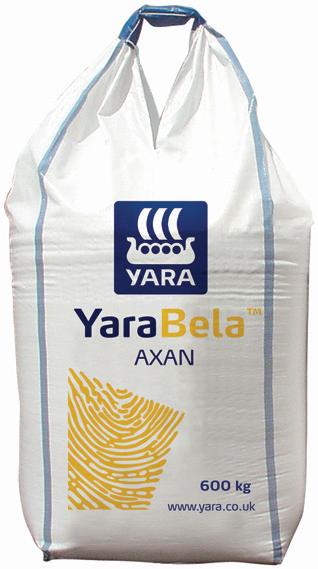
37 SLUG CONTROL TECHNICAL MAY 2023 YaraBela™ AXAN™ @Yara_UK www.yara.co.uk Yara UK agronomy.uk@yara.com
A ‘hard reset’ of its oilseed rape breeding programme has provided RAGT with a pipeline will be making their way into the UK market in coming seasons. Teresa Rush reports.

New OSR breeding programme showing green shoots
Following success with varieties such as RGT Alizze and RGT Windozz (both added to the AHDB Recommended List in 2016/17)), RAGT took the bold step of halting and restarting its oilseed rape programme. The company is now making use of the Ogura-INRA CMS (Cytoplasm Male Sterile) and MSL (Male Sterile Lemke) hybridisation systems, alongside genomic (marker-assisted) selection, research collaborations and innovative testing methods to deliver a range of material bred to suit a range of farm situations.
Priority breeding targets in OSR include yield; resistance to pod shatter; disease resistance; oil and protein; and pest resistance, including resistance to cabbage stem flea beetle and pollen beetle, says oilseed rape breeder Damien Dugue, who is based at RAGT’s Annœullin research station, near Lille in northern France.

The company’s UK managing
director Lee Bennett says: “RAGT had success with Alizze and Windozz. And then, in essence, they stopped the programme and restarted and what you see today is the hard reset. Our varieties were good but not good enough, and not complete enough. So there has been a total restart of the
programme and although it’s very early days for it, it is bearing fruit. We are now only a couple of years away from having a good commercial variety.”
Initiatives

Among the initiatives supporting the new breeding programme is a collaboration in France with Lidea Seeds, Limagrain and Sofiprotéol, in the form of research company Innolea, in which parent company RAGT Semences has a 25% stake, says Mr Dugue.
Innolea’s projects focus on improving the adaptation of rapeseed and sunflower varieties to abiotic stresses arising from limited availability of water or nitrogen, for example, and biotic stresses caused by disease, pests and weeds, using genetics, genom-
ics, bioinformatics and innovative phenotyping approaches.
Here in the UK, RAGT is working with the John Innes Centre and the University of Warwick on improving resistance to cabbage stem flea beetle and pollen beetle. Tackling the CSFB challenge is essential if OSR is to cement itself once again in UK rotations, maintains Mr Bennett, who is keen to point out that the projects are taking different approaches.
“Innolea is looking at cabbage stem flea beetle in a completely different way to what John Innes and Warwick are and they’re also doing the same for pollen beetle. When we get to a situation where we don’t worry about flea beetle anymore, because genetically it’s taken
38 TECHNICAL OILSEED RAPE MAY 2023
We’re trying to drive very high protein oilseed rape as an alternative to soya DAMIEN DUGUE
Plant breeding advances are set to boost the resilience of oilseed rape crops.
of promising new varieties, some of which
READY FUTURE FOR THE programme of success
oped by RAGT in-house, are also helping to differentiate the company’s breeding programme from those of its competitors and deliver progress, maintains Mr Bennett. A novel sclerotinia inoculation technique is allowing varieties to be ‘tested to destruction’, he says.
Test















“Spraying for sclerotinia has become an almost a prophylactic application for what is an extremely incidental disease, but through this methodology we can test varieties to destruction and tell you, categorically, that in the presence of sclerotinia this variety is going to give you some protection or none whatsoever.
care of, we’ll see the OSR area go back up to where it was, because no doubt about it, the UK was a winter wheat and oilseed rape country.
“I think growers would like to get back to it, but plant breeding has got to catch up and deliver what agronomy is, right now, not able to,” he says.

Work with investment company for oil and protein crops, Sofiprotéol, is looking at OSR as a source of protein, as well as a source of oil.

“We’re trying to drive very high protein oilseed rape as an alternative to soya. We’re looking at alternative uses [of rapeseed] beyond the conventional,” says Mr Dugue.
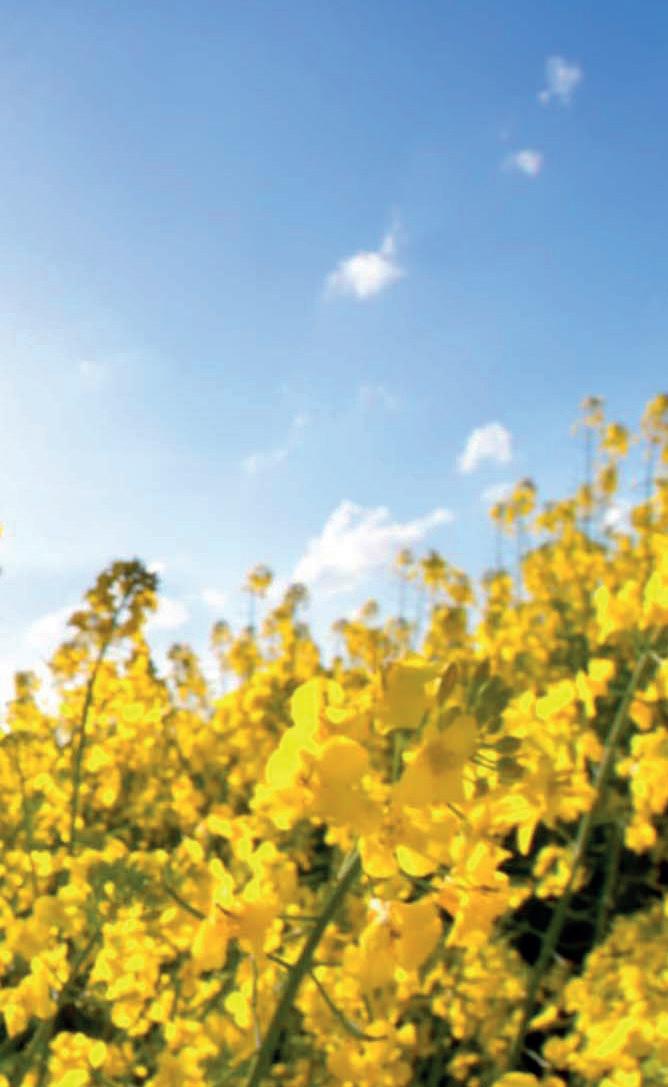
Meanwhile, innovative techniques for testing for disease resistance or tolerance, devel-
“We are not at the commercial stage yet, but what we know is that we have got a very, very robust tolerance that is multigenic, that has been tested and works and that we’ve got welded into parent material. We’ve stuck four genes together and it [the resistance] never blinks.”


RAGT will start to test OSR material with a range of traits conferring new and novel resistances at five sites in the UK, this autumn, including what it claims is unique polygenic resistance to TuYV. This will follow hot on the heels of a clubroot-resistant variety currently in National List year 1 trials, several varieties in NL2, and AHDB 2023/24 Recommended List East/West region candidate variety RGT Kanzzas. The latter achieved 102.7%



LG TYPHOON WINTER WHEAT
• Consistently High Yielding over Regions & Seasons
• Excellent Disease Resistance
• Suitable for Early Drilling & OWBM Resistant
39 OILSEED RAPE TECHNICAL MAY 2023 lgseeds.co.uk/lg-typhoon
gross output at harvest 2022; a 7.8 (NL) rating for light leaf spot and 6.2 for stem canker, says Mr Bennett.
Code-numbered HRG231 (available in Europe as RGT Ceos) is currently in NL1 trials and looks to be a strong all-rounder, with ‘brilliant’ autumn emergence and establishment, strong spring regrowth, good LLS and phoma disease scores, TuYV and pod shatter resistance, while HRF19240 (marketed as RGT Blackmoon elsewhere in Europe) is in NL2 and is ‘stuffed full of yield’, says Mr Bennett.
“It grows like nettles; it has TuYV and pod shatter resistance; it’s such a growy type,” he adds.
Each of the varieties offers the good crop vigour at planting and spring regrowth which is now so high on, if not top of, growers’ checklists.
“Kanzzas is very rapid in the autumn but 19240 needs its own scale; for some people it will be too quick.
“My first selection criterion is the same as that of the farmerspeed of development and vigour. The next one is light leaf spot because that’s the disease that manifests itself clinically first. When you see a crop disappear over winter because it is not winter hardy, the chances are it is poor for light leaf spot resistance.”
Growers further north are urged to look out for HRG941.
“It’s got the best light spot
resistance we have, it’s clubroot resistant, with pod shatter and it’s also very early. If ever you want a product that is tailor-made for Scotland, it’s this one; it’s a good fit for Scotland.”
Seed
There will be seed of all these varieties available this autumn, with RGT Kanzzas available through Agrii and the coded varieties available through selected distributors under an ‘orange label’ certificate, which permits the sale of a limited quantity of seed before a variety achieves National Listing.
“What I want to do is find varieties that are adaptable to a situation and match them to that situation because it’s all about getting the best performance. We’ve got such a broad array of material in terms of growth habits, maturity dates, different traits, coming forward, but this is about getting the variety to fit the farm, not making the farm fit the variety.
“We want to build very rounded products, using all the systems that are available to us, be they breeding systems or trialling methodologies and to be able to say it’s got TuYv resistance, it’s got pod shatter, it’s stiff-strawed, it’s very robust against the important diseases like light leaf spot and phoma; it will also bring sclerotinia resistance into the mix. And, if clubroot is a problem, we’ve got resistance to clubroot and there is no yield lag,” concludes Mr Bennett.
LepR1 phoma resistance provide added layer
New sources of genetic resistance to oilseed rape diseases affecting UK crops should soon be available to growers.
Ash Burbidge reports.
Anew genetic resistance to phoma in oilseed rape is set to be available to UK growers within two years. DSV’s ‘Phoma Blocker’ trait, combines the Rlm7 resistance gene with a new resistance gene, LepR1. Varieties featuring the new resistance mechanism, which is new to Europe, are currently going through the UK testing process.
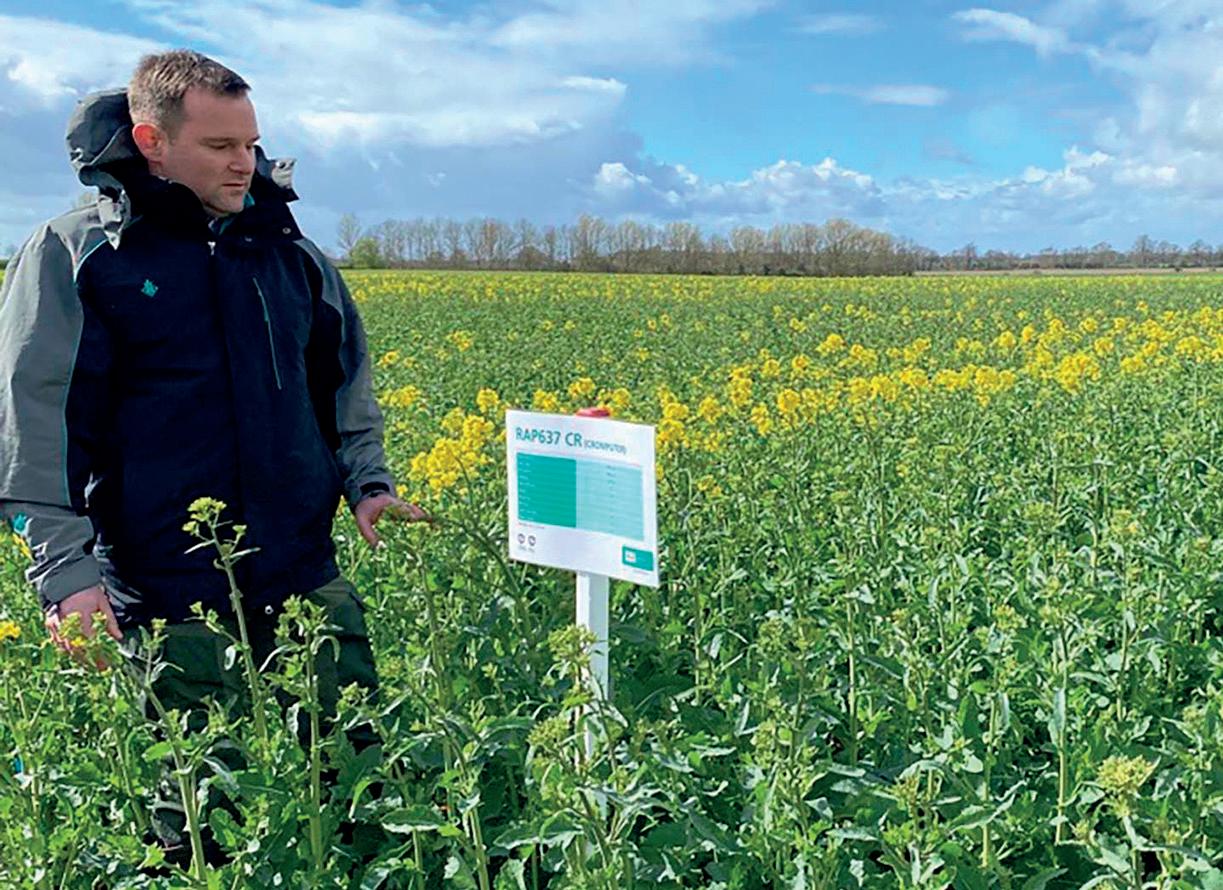
According to Simon Kroger, DSV oil crops product management lead, 53% of OSR varieties on the AHDB Recommended List rely on the Rlm7 gene alone; it has been the main genetic disease resistance gene for many years, and has proved to be very effective. However, there is growing evidence that its efficacy is reducing.
DSV trials conducted in Dyngby, Denmark investigated a range of OSR varieties, classifying varietal phoma resistance on a scale of 0-10, with a score of 0 indicating high resistance to phoma and 10 indicating high susceptibility.
“Varieties with the Rlm7 gene
showed a wider range of phoma susceptibility with scores from 4-9, but the real concern is that the average was the same [7.5] as varieties with no disease resistance at all,” says Mr Kroger.
“DSV Phoma Blocker is made up of LepR1 with Rlm7 and this combination not only showed the narrowest range of susceptibility to phoma in the Dyngby trials but also did well with an average score of just 2.3, compared to the 7.5 for Rlm7 by itself,” he says.
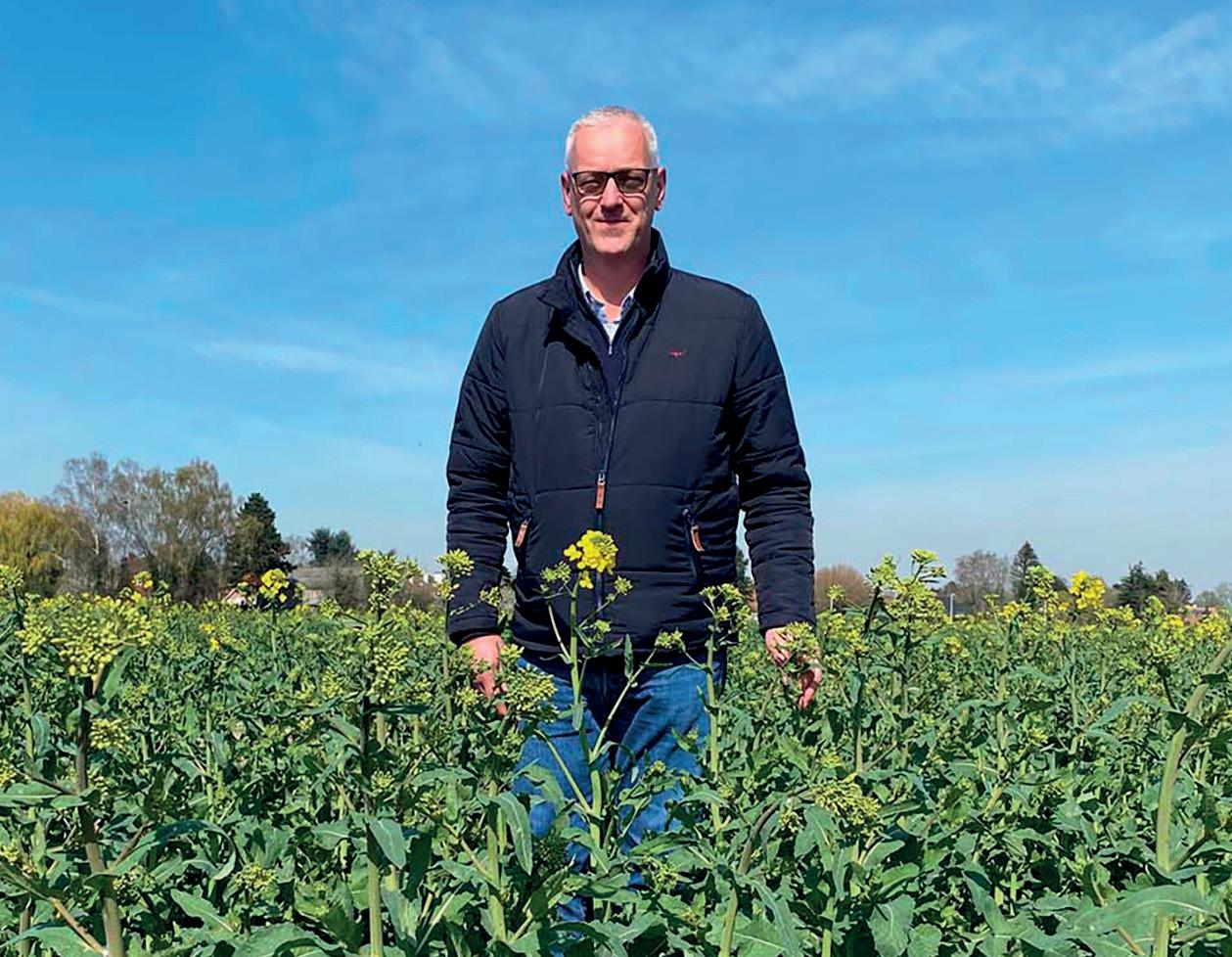
“But the real advantage is that DSV now uniquely has varieties featuring all three different phoma resistance mechanisms - Rlm7, RlmS and now LepR1 - that can be rotated in the field to minimise major breakdown of any one type of resistance.”
DSV already has Phoma Blocker varieties moving through the UK testing process and it anticipates the first of these will be commercially available in 2024 after completing NL2 testing this year.
In further developments, the company is also introducing new genetics to improve
40 MAY 2023
The RAGT oilseed rape breeding programme is focused on producing adaptable varieties that can be matched to actual farm situations, says Lee Bennett, the company’s managing director in the UK.
resistance will layer of security

resistance against the growing threat of clubroot.
Protecting yields
In recent years, hybrid oilseed rapes with genetic clubroot protection have played an important role in keeping the spread of the disease in check and also protecting yields for growers, says DSV UK managing director Dr Alex Doering.

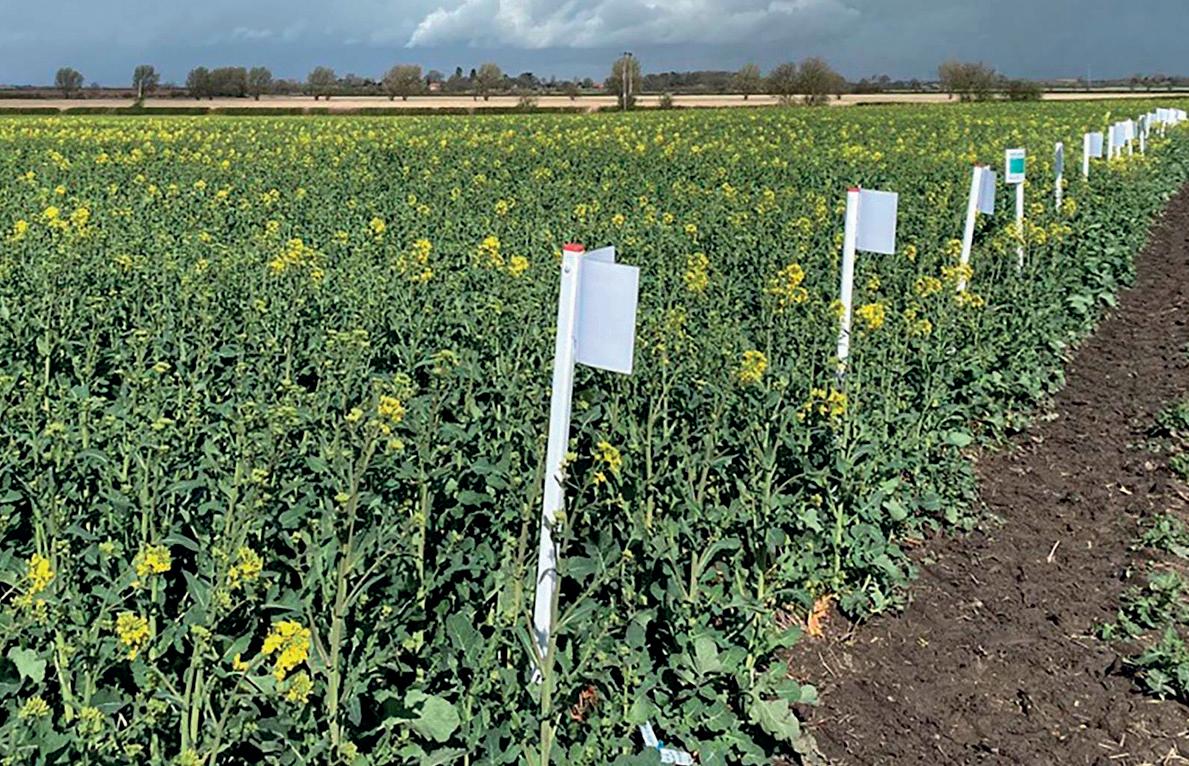
DSV varieties such as DSV Crossfit CR and DSV Crocodile CR offer good protection against clubroot without yields being compromised, which was typically the case before such varieties were introduced, he adds.
While the Rlm7 resistance has been very effective for many years, there is evidence the protection it provides against phoma is reducing, says Simon Kroger.
“Breeding for clubroot resistance is complicated and time consuming with significant incompatibilities between species creating an additional challenge for breeders.”
Despite this, DSV is now introducing a new clubroot resistance mechanism called CRE1 (Clubroot Resistance Enhanced 1), which is claimed to offer broader protection against more pathotypes.
“CRE1 is a novel trait that has been created by crossing from B. rapa. Laboratory infection studies using various P. brassicae isolates show CRE1 to be an enhanced resistance mechanism compared to the classical resistance.
“The first DSV CRE1 resistant variety is expected to be registered during winter 2023/24 in the EU, but it will take a few more years until it is available in the UK.
“In the meantime, we are launching a new variety (RAP637) which as well has a clubroot protection using the established common source of partial resistance, will also be TuYV resistant with verticillium wilt tolerance and a very good lodging resistance score,” says Dr Doering.
PT303. STILL THE TOP CHOICE FOR SCLEROTINIA TOLERANCE.
PT303 Protector® Sclerotinia is the first hybrid offered to UK growers with a claim for Sclerotinia tolerance. It’s impressive disease package includes TuYV resistance, partial resistance to verticillium stem stripe and a score of 7 for light leaf spot and 6 for phoma.

It’s proven its reliability with a gross output of 104% for the UK on this year’s AHDB Recommended List†, with 104% in the East West and 102% in the North region. And with its yields achieved in years when cabbage stem flea beetle activity was very high across much of the UK, PT303 has further proven its ability to deliver.

This season, choose the UK’s all-round top performer. Talk to your advisor or find out more at www.corteva.co.uk/pioneer


UK RECOMMENDED

OILSEED RAPE TECHNICAL
Pioneer Hi-Bred Northern Europe Sales Division GmbH, Corteva Agriscience UK Limited, CPC2 Capital Park, Fulbourn, Cambridge CB21 5XE. Tel: 01462 457272. ®, ™ Trademarks of Corteva Agriscience and its affiliated companies. Pioneer ® brand products are provided subject to the terms and conditions of purchase which are part of the labelling and purchase documents. © 2023 Corteva. Discover more at www.corteva.co.uk Technical Hotline: 0800 689 8899 E-mail: ukhotline@corteva.com †AHDB Recommended List database at ahdb.org.uk/rl
Phoma Blocker is being trialled in Nottinghamshire to test its performance against different phoma races found in the field.
ithout strong genetic traits providing a stable backbone it will be hard to realise the full benefits from tailored nutrition strategies in arable ceops.
That was the message from Limagrain UK’s arable development officer, Liam Wilkinson, during a trials visit near Grimsby, organised jointly with Yara.
This was particularly true for oilseed rape, which faced several threats, including turnip yellows virus (TuYV), the impact of which could potentially outweigh any benefits from tweaks to fertiliser practice.
“If TuYV hits a crop, it will inevitably impact the plant’s ability to utilise nutrients effectively, and we know from YEN research, that crops containing more nutrition generally go on to produce higher yields.”
Nutritional requirements for newer varieties often differ to those grown in the past, so it is vital to understand what individual crops need, Mr Wilkinson added.
“Typically, you would expect conventional varieties to be a bit slower to get away in the spring, so they might require more of a boost. Equally, newer hybrids, like Ambassador and Attica, extend quickly early in the spring, when it can be difficult to travel on the land. As a result, it is often important to load varieties like this with micronutrition in the autumn, so there’s nothing holding growth back when it resumes coming out of winter.”
Hybrids grown in the Limagrain trial at Grimsby received 30kg nitrogen/hectare in the seedbed last autumn, followed by 80kg N/ha + 28kg sulphur/ha in early February, and another 100kg N/ha + 36kg sulphur/ha at the end of March.
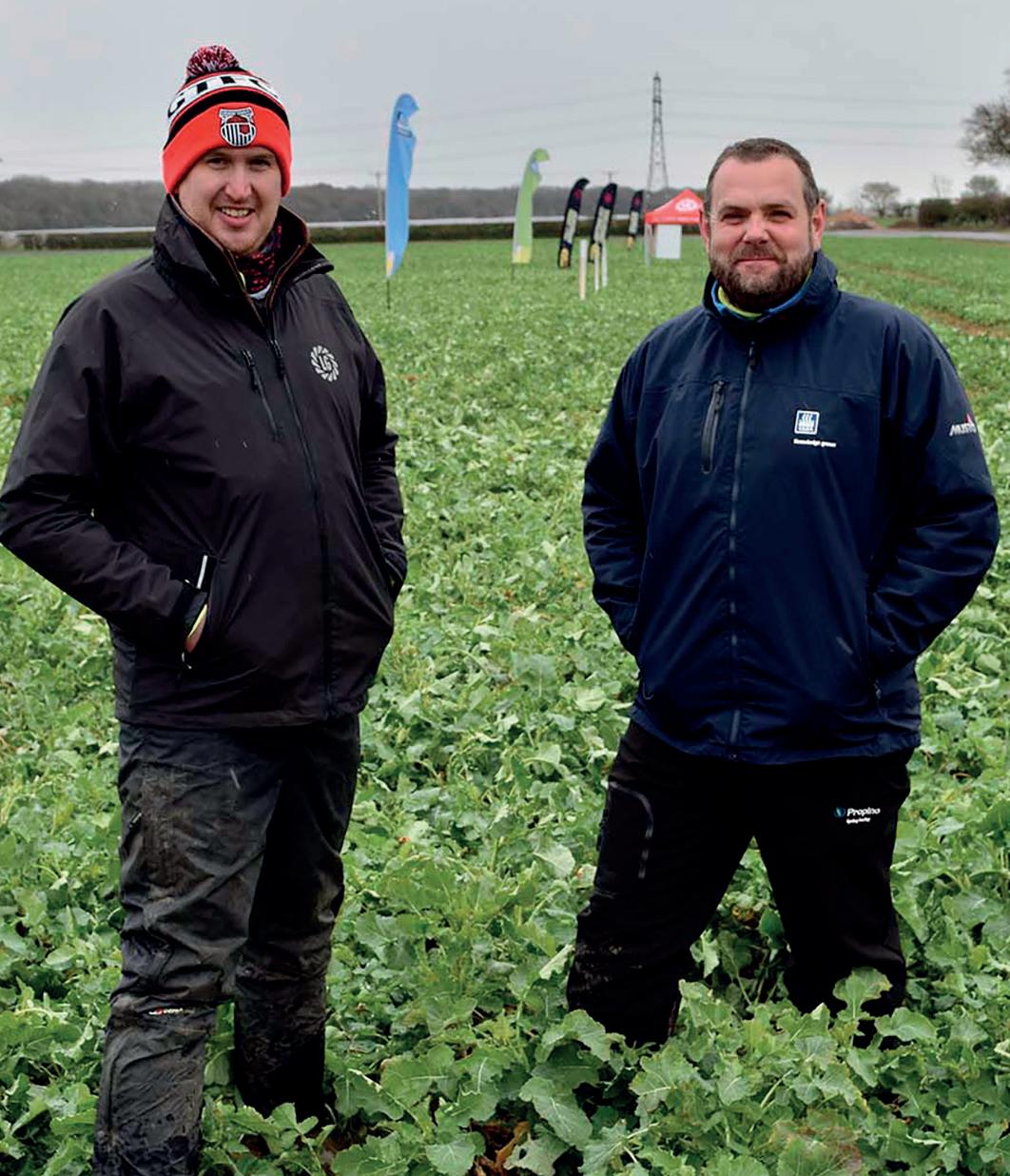
Mr Wilkinson highlighted the importance of adjusting nutrition to crop requirements, particularly nitrogen, which had
WHigher fertiliser prices have prompted many growers to find new ways of improving nutrient use efficiency, but to do so requires having a solid genetic base to work from. Alice Dyer reports.
Genetics and nutrition must work together
Boron plays an important role in oilseed rape flowering, as well as in plant cell structure (alongside calcium); magnesium is a key component of chlorophyll; and manganese is needed for lipid synthesis, so affects seed oil content, he explained.
“We often find magnesium can be the first nutrient to be limited when it turns very dry, which in recent seasons has often occurred around flowering, which is when crop demand peaks.”
Foliar magnesium
In such situations, foliar magnesium at the start of flowering could be a cost-effective way to avoid deficiency occurring, he said.
a big impact on canopy development.
“If crops are a bit backwards, nitrogen plays a key role in building biomass. But equally, if you’ve already got a thick canopy, applying more nitrogen will accentuate stem growth, producing tall, thin stems, more prone to lodging.
“Sometimes, less is more. I’ve seen N-Sensor results drop nitrogen recommendations to 120kg N/ha and still deliver a 5t/ha+ crop.”
Yara’s Phil Burrell said that in

large biomass crops, it was often possible to reduce soil-applied spring nitrogen, and supplement crop requirements with smaller amounts of foliar nitrogen applied at early to late flowering.
“But, don’t do this if the crop is stressed, or it’s very dry.”
Alongside macronutrients like nitrogen, phosphorus and sulphur, it is also vital to optimise micronutrients, notably boron, manganese and magnesium, Mr Burrell said.
Particularly good results have been seen from applying YaraVita Brassitrel Pro - a combination of various micronutrients, including manganese, magnesium, boron and molybdenum - in the autumn, and again in spring, he said.
Five years of Yara trials from 2016-2021, saw an average yield response of 0.29t/ha over untreated crops, from a 3l/ha application of the product in autumn and spring.
“For a spend of just £18-20/ha per application, you only need a small yield increase to pay for it, so it’s a small investment for a decent return,” said Mr Burrell.
42 TECHNICAL OILSEED RAPE MAY 2023
Liam Wilkinson (left) and Phil Burrell.
A new Recommended List, contract price increases and emerging technology are among the latest developments in the sugar beet sector. Alice Dyer reports.

Sugar beet crop optimism despite challenging start
Met with one of the wettest springs in many years, sugar beet growers have been making slow progress with drilling, with just 5% of the national crop in the ground at the end of March.
As of April 17, around 40% of the 800 hectares that Suffolk grower and contractor Will Hitchcock of Hitchcock Farms Ringshall, is responsible for had been drilled. With almost 100mm of rain falling in March, it is proving to be a very much stop-start drilling campaign, he says.
“We did not get started with drilling until March 24 on some really light land and it has been stop-start ever since, when we would normally be easily done by the second week of April.”
With such a large area to drill,
the team was running two drills for 24 hours a day when weather windows allowed, with spray windows being few and far between as well. However, crops went into good seedbeds, thanks to moisture and the legacy of the earlier frosts.
Mr Hitchcock says: “Because we had so much rain over March, we were worried we might lose the frost tilth we had before the rain but we haven’t found that.”
Plant populations
Some fields were so good Mr Hitchcock was able to drill straight into land cultivated in the autumn, saving precious operations time.
“Overall, seedbeds are very good considering the amount of rain and compared to the last two-three seasons where we have had no rain. Plant populations will be good and it will rocket away.”
The dry weather in previous years led to poorer plant populations, which Mr Hitchcock believes made crops more vulnerable to the pest and disease challenges many experienced last season.
“Last year was difficult – we weren’t hugely affected by beet moth, but we found it hit areas of fields that struggled to get going last spring and where the canopy was more open and plants were smaller. Extreme heat encourages beet moth so perhaps we won’t see it this year, but we are hoping if germination is good like we are already seeing this season, it won’t be so detrimental.”
Although the Cruiser (thiamethoxam) active derogation took some pressure off, with a mix of untreated and treated seed being used, Mr Hitchcock says managing aphid risk is challenging.
“Three years ago, on one block of land we couldn’t get a seedbed, so we had to wait until the first week of May, when it eventually rained. Virus yellows infection was very low in that [untreated] crop because we had essentially missed aphid migration. It depends how aphid flights work out but there is potentially an advantage we have seen in the past in drilling later and not getting so much virus infection.”
However, with this in mind, the contract price increase means every day is critical to stop eroding yield later on, Mr Hitchcock adds.

“The price rise from British Sugar makes us want to push the crop as much as we can, which is why every day is critical to final yield.”
This season, for the first time, British Sugar offered a one-time contract to growers who can
43 SUGAR BEET TECHNICAL MAY 2023
Good emergence is expected in warm, moist, soils.
TECHNICAL SUGAR BEET
deliver beet into its Bury St Edmunds, Suffolk factory in early September at a payment rate of £3,000 per hectare regardless of volume. The company says it faced unique supply challenges last season, which required addressing with unique solutions, after dry weather took its toll on the 2022 crop .
Overwhelming
Nick Morris, head of agriculture at British Sugar, says the response to the contract offer was ‘overwhelming’.
Around 1,400ha is being grown on the contract and despite the delayed drilling window, Mr Morris says he is not concerned about impact on yields.
“Inevitably a number of those hectares will have been delayed but we are not unduly concerned, and we want to support growers to do the right thing and plant the crop at the right time.
“The crop was sown into warm seedbeds with plenty of moisture, so we have got great ambition for the crop getting away in good conditions.”
The same can be said for crops vulnerable to aphid attack, particularly for those growers that opted out of using the Cruiser seed dressing, he adds.
“Just because the crop is being
new additions to the RL Late drilling impact on virus yellows
JJust two varieties have been added to the sugar beet Recommended List (RL) for 2024 – a testament to the high yielding varieties on the current list.
Mike May, chair of the RL board, says: “This is fewer than normal, but we now have some very high yielding varieties on there and a lot of the effort from the breeders is going into breeding in traits.”
planted later, it does not mean it will establish to full crop maturity later. Late drilling impact on virus yellows will depend on the weather the crop is going to receive. Quite often we can drill a crop early in March, but conditions are very dry and sometimes cold as well, so while the seed might be in the ground, the crop is not really growing very fast at this time of year anyway.”
This season’s sugar beet area is expected to see a significant uplift on last year, increasing from 88,000ha to an estimated 95-100,000ha.
Mr Morris says: “The contract price hike was received with huge positivity, and we have secured all of the contract area we wanted for 2023 sowing.”
Potential to reduce N use
JAn R&D company based at Lincoln University, has received the stamp of approval from Bill Gates, after receiving substantial funding from his trust to develop technology which enables farmers to reduce synthetic nitrogen inputs.
R-Leaf technology by Crop Intellect, is based on photocatalysis, capturing air pollution, and turning it into nitrogen fertiliser for plants. The technology has been prepared in a simple-to-use formulation that can be added to the spray tank. When on plant foliage, it works
by using daylight to enable the breakdown of nitrous oxides to nitrate that plants use as feed.
Company director Dr Apostolos Papadopoulos says: “R-Leaf can be tank mixed in most situations in broadacre crops. The material ‘actives’ are not water soluble and non-reactive in a solution so there is no potential issue for drop-outs or immediate formulation effects. The mineral content is relatively small and it is unlikely to cause any incompatibilities.
“We have tested R-Leaf in a large variety of commercial farm
Five varieties were withdrawn which means the 2024 list comprises 19 varieties.
The first addition, Osprey from SESVanderHave is an AYPR rhizomania tolerant variety that joins Philina KWS for use where this strain of rhizomania is present. The RL trials are carried out on sites free of AYPR and Osprey yielded 99.2% of the controls’ adjusted tonnes/ha yield. It had 16.9% sugar content in the trials.
Mr May says: “Osprey is a useful addition because it gives another option if we have AYPR anywhere and is slightly higher yielding than the other AYPR tolerant variety on the list. About 40 or so fields are affected [by AYPR] so it is not enormous but when you have
tank mixes with no reported issue.”
Trials
Most trials have been carried out on cereals but the company is commissioning trials in other crops, including sugar beet.
Suffolk sugar beet grower, Frank Stennett trialled R-Leaf on his beet crop last season to help him understand how he can make potential reductions to his nitrogen inputs and increase his farm’s sustainability.
Mr Stennett’s sugar beet crop received two applications of
got it, you need to have those varieties. It’s a niche variety but it yields well enough that some growers will use it anyway.”
The second addition, Smart Vesnica KWS from KWS is an ALS herbicide tolerant variety which achieved 94% adjusted yield in the trials with a high sugar content of 17.4%. These yields were achieved in trials treated with conventional herbicides. It is expected that yields will be higher when the ALS herbicide system is used.
Mr May says: “ALS varieties are becoming very popular because of the need to spray less often and although it might be a bit more expensive to start with, if you can reduce operations on the farm that can save quite a lot overall.”
Ben Bishop, KWS UK country manager for sugar beet says: “Smart Vesnica KWS is a great addition to the RL for 2024 and provides sugar beet farmers with improved yield and bolting characteristics compared with Smart Rixta KWS.
“Best suited to drilling from mid-March onwards, Smart Vesnica KWS shows good tolerance to both
R-Leaf at the recommended rate of two litres/ha.
Root digs were carried out to determine the sugar beet yield. The non-R-leaf sugar beet had an average yield of 106.15 tonnes per hectare, while the R-leaf sugar beet had an average yield of 112.28t/ ha, representing a 6% increase in yield. The R-leaf sugar beet also had higher nitrogen levels in the leaf tissue, which remained steady at around 5% after application, while the non-R-leaf sugar beet experienced a decline in nitrogen levels over time.
Mr Stennett says he believes
44
MAY 2023
Two
will depend on the weather the crop is going to receive
NICK MORRIS
BARLEY CHOICE WINTER EASY MADE
rust and cercospora.
“Smart Vesnica KWS offers farmers an alternative approach to controlling weeds in their sugar beet crops and will support the increasing demand for Conviso Smart.”

Limited data











As these varieties are new to the list, there is very limited BBRO data on their tolerances to foliar diseases. Neither variety has any restriction on sowing date.
Mr May advises: “Before ordering any of the special varieties bred for BCN, AYPR, yellowing virus tolerance or ALS herbicide tolerance, growers should discuss options with the BBRO and breeders who will have more information

on their performance and use in the presence of the specific problem. The breeder and BBRO will have more information on how best to use all the RL varieties in practice.”



The 2022 trials were subjected to a very dry summer and this was one of the major factors that affected establishment of two of the eight RL trials which were not taken to harvest, Mr May adds.

In the 2024 RL table the yield of control varieties in 2022 was 103.3 adjusted tonnes/ha compared to 112t/ha in 2021 and 105.8t/ha in 2020. Mr May says this was almost certainly down to the summer drought. Average sugar content (17.2%) was similar to the previous two years.
Crop Intellect has received Government and private funding to test R-Leaf technology on new crops and scale up.
that R-leaf could be an effective way to increase sugar beet yield by keeping leaf tissue nitrogen levels above the recommended 4%, potentially increasing yield by up to 42t/ha if applied every six weeks from the end of May.
He adds that an increased dose of R-leaf could stimulate more root growth earlier in the crop’s life, and leaving the beet in the ground longer with four treatments could increase yield even further.

LG CARAVELLE WINTER BARLEY








• Highest yielding 2 row winter barley in every region of the 23/24 RL
• Robust disease resistance package







• Excellent specific weight

45 SUGAR BEET TECHNICAL MAY 2023
lgseeds.co.uk/lg-caravelle
ALS varieties are becoming very popular because of the need to spray less often
MIKE MAY
Oilseed rape genetics
Can genetics be exploited to help oilseed rape fight back against cabbage stem flea beetle? Andrew Blake reports on an AHDB-supported research project* aiming to find the answer.
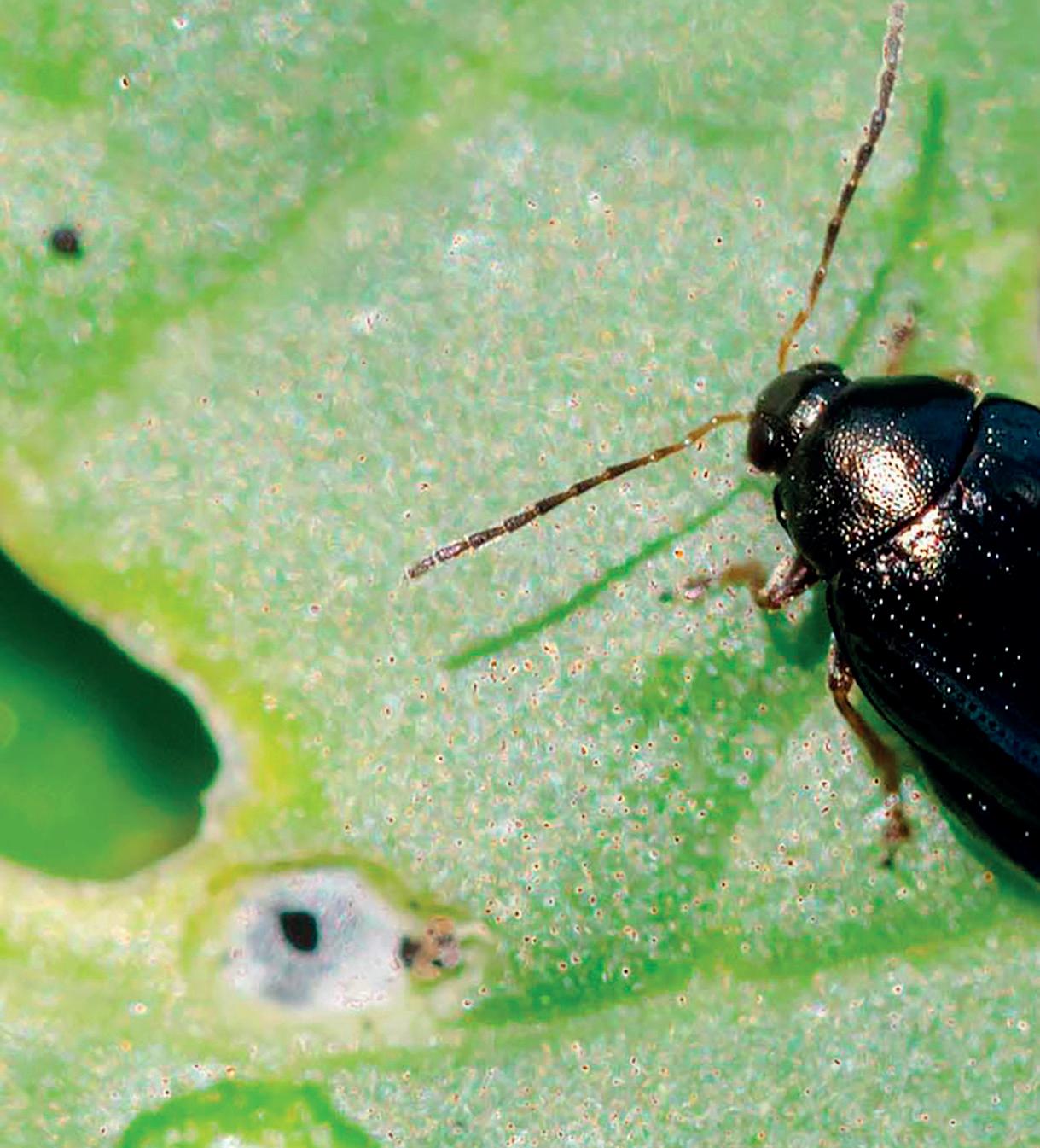
ithdrawal of chemical controls of pests and diseases means resistant varieties will be key to supporting integrated pest management (IPM) strategies. So says Dr Rachel Wells of the John Innes Centre (JIC) , who is leading the four-year project.
“However, unlike plant-pathogen interactions our understanding of the interactions between host plants and chewing insects is limited,” she says.
The latest research builds on work by PhD student Jessica Hughes, which found genetic variation linked to CSFB feeding in brassica napus.
The UK’s oilseed rape (OSR) area halved between 2012 and 2021, and the NFU estimates that removal of neonicotinoid seed treatments to control cabbage stem flea beetle (CSFB) has cost farmers £94 million a year, notes Dr Wells.
“The beetles are attracted to glucosinolates which brassica
species use to deter non-specialist insect pests.
“Even if B. napus has defence or resistance mechanisms that deter feeding, the genetic control of such mechanisms and whether they can be exploited to breed for resistance has remained an open question.
“There are no known examples of resistance in B. napus and little knowledge of resistance mechanisms within our UK crop species. No resistant varieties are currently available for any insect pest of OSR.”
The PhD study worked with historical varieties of winter and
spring OSR, Chinese OSR, swede and kale which contain genetic diversity unlikely to be present in modern varieties.
Genome Regions of the plant genome associated with CSFB feeding damage have been identified, and controlled larval infestation
Genetic control approach welcomed
JThe French agricultural research institute Terres Inovia has found significant differences between winter OSR varieties regarding CSFB larval infestation, notes Susann Volkmann, of KWS in Germany.
“However, this resistance isn’t complete and may be insufficient under very high infestation pressure,” she says. “And there’s no resistance in
the gene pool to leaf damage by the adult beetle.”
Given the neonicotinoid ban, the expectation that fewer crop protection agents will become available, public perception, and the importance of sustainability, it will be necessary to find a breeding solution to controlling the pest, she believes.
“We hope the project will develop knowledge and
approaches that can support that.”
The genetic approach is good and sound, says Mark Nightingale of Elsoms Seeds.
“The interesting thing is all breeders, including us, are already artificially selecting varieties with degrees of tolerance to CSFB which are separate from the JIC resistance.
“The next steps would be to
studies within those varieties are now under way to identify any resistance to the larvae.
This involves work on both adult and larval stages of the CSFB lifecycle in controlled environments and in the field.
“Working within a controlled laboratory environment means we can control the level of infestation
look genetically at the newer, better varieties and compare their genetic profiles with those identified in the project to see if they are one and the same, or whether we as breeders have found additional tolerances.
“That might allow us to stack different tolerance genes in a single variety and hopefully provide enhanced tolerance in future varieties.”
46 RESEARCH IN ACTION MAY 2023
WNo resistant varieties are currently available for any insect pest of oilseed rape
DR RACHEL WELLS
genetics might beat CSFB
AHDB-funded research has identified regions of the OSR genome associated with CSFB feeding damage.
“We have also developed efficient germplasm screening assays to study both adult and larval feeding.
“These protocols can then be transferred to our breeding partners to support them in setting up CSFB screening systems. Screening plant lines within replicated field trials helps us see how plant varieties/accessions/ lines behave in the natural environment.”
Resistance identified in the lab must be transferrable to a field environment to be of use in breeding, she says.
“Field trials also help us understand beetle development in the natural environment, how the larvae develop in the plant over time, and where in the plant they are found.
whether specific chemicals, for example in the waxes on the crop’s leaves and stems, may deter beetle feeding and larval feeding, growth, and development.

effectiveness of our candidate genes. For this we will use genome sequencing in the model plant, arabidopsis, or ultimately within the crop. All information will be provided to our breeding partners so they can apply it to their breeding programmes.”
One surprise in the first year of field trials was the level of larval infestation, says Dr Wells.
“At the JIC site it was incredibly high. There were 37 larvae per plant which is way above the threshold level for treatment; but even so the plants looked relatively unaffected.
to which plants are exposed,” says Dr Wells. “This allows us to focus on genetic effects as opposed to those brought about by the environment.”
For work within the controlled environment, we need a ready supply of beetles and larvae, so optimising insect rearing protocols has been important.
“Having captive insects means we can look at how the plant and the beetle respond to each other. Plants have complex defence mechanisms that are activated by herbivore feeding.
“We can look at the effect that insect feeding has on plant gene expression to determine key genes involved in resistance. We can also explore any effects that resistant plants may have on the insects. This knowledge may help us identify targets for breeding or pest control.”
The work is also examining
“All these data should help pinpoint genes controlling plant/ beetle interactions. To understand genetic resistance, we need to be able to identify and prove the

Project details

r*AHDB project P2007350
Varietal resistance to feeding (herbivory) by the cabbage stem flea beetle in oilseed rape
rJune 2021–November 2025
rFunding: total £1,886,025. AHDB £60,000 + BBSRC Industrial Partnership Award via partners Bayer,
“We’re now on our second year of field trials and have produced some good genetic data and germplasm for future project work. Both field and controlled trials are producing interesting results, but more analysis work needs to be done.”
DSV, Elsoms Seeds, KWS, Limagrain, LS Seeds and RAGT
rResearch partner: Rothamsted Research
rSupport from JIC entomology, bioinformatics and field experimentation platforms, and Rothamsted Research field experimentation and statistical services


Find Jobs Faster
47 RESEARCH IN ACTION MAY 2023 JobsInAgriculture Jobs in your field Let us keep you updated by email and never miss another great job JobsInAgriculture.com
the latest jobs in your inbox with our free email alert service
Receive
Dr Rachel Wells is leading work searching for a genetic solution to the CSFB threat in OSR.
MACHINERY ON TEST
With the performance of a six-cylinder machine and a distinct technology offering, the 163hp Fendt 516 proves to be an adaptable all-rounder. Toby Whatley reports.
Fendt 516 shows small is powerful
In the early 2000s, farmers looking for 160hp mixed utility tractors had few options other than a six-cylinder variant, with equivalent four-cylinder models virtually non-existent.
Roll the clock forward some 15 years and the market offering in the same power bracket is a varied mix for engine sizes, with many manufacturers presenting models in both six
and four-cylinder variations.
So, does a four-cylinder machine with a continually variable transmission and plenty of technology offer a genuine alternative for a farming business or contractor carrying out, tillage, haulage and crop care applications?
Supplied as a Power+ specification, the 516 can be delivered in four specification levels:
Engine and transmission
JSitting at the top of Fendt’s four-model 500 Series, the 516 delivers a rated output of 163hp and a maximum of 171hp from its four-cylinder 4.1-litre Deutz engine.
Being Fendt, the transmission is a continually variable transmission-only arrangement, with the range using an ML90 version of its Vario transmission.
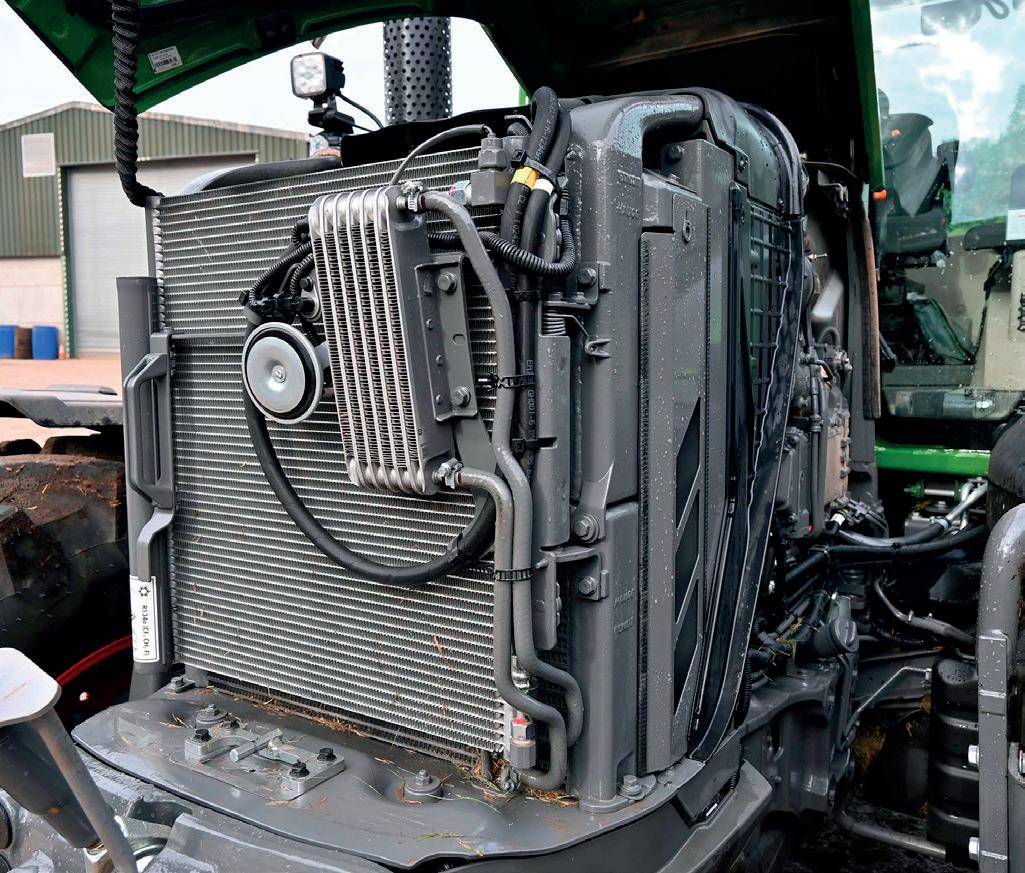
Operation
In use, we had no significant concerns with the performance and operation of the driveline set-up, with little difference in the operator feel to any other model in the manufacturer’s range, or the wider Agco stable.
The glory days of Fendt’s
Also in this section
fuel reductions have largely been passed, as competitive manufacturers have caught up
Power, Power+, Profi and Profi+.

The main differences between the four levels are the introduction of guidance as standard on the plus variants and an increase in the standard hydraulic outputs and spool connections.

In practice, the Power+ specification appeared to deliver a capable machine for all of the tested activities.
A notable difference between its performance and that of a six-cylinder machine was a reduction in available power when under heavy loads, an example being engaging the beaters on a full spreader travelling uphill.
It’s not an easy ask for any machine, but this did reveal a weakness with a smaller capacity engine.
Servicing
Servicing and access to the engine and cooling pack were good.
with transmission and engine management technology, with the 516 using slightly less fuel than our test farm’s larger CVT-equipped tractors.
Generally, the engine load response was good and it adapted well to a range of tasks, both in pto, draft work and haulage.
The side panels were a reasonable challenge to fit and remove for smaller operators. Engine services extended to 500 hours and 2,000 hours for the transmission.
Although not excessively short, compared to some competitive machines with 600- or 750-hour engine service intervals, high-hour users would need to consider this additional operational cost.
48
MAY 2023
The 516 performed well as an all-rounder and six-cylinder replacement.
52 ‘Handle anything’ tractors delivering value all year round 54 Coming soon to the digital shed 56 Efficient bulk handling underpins diversification 60 Rain stops play on demo day 67 Long term flexibility from Horsch 3TD
We had few complaints with the performance and access to the Deutz-sourced engine.
Linkage pto and hydraulics
JFront and rear linkage lift capacities were 3,420kg and 7,890kg respectively. In operation, both linkages are actuated through a spool-type paddle on the console. The fully integrated front linkage was refined and operated effectively with a front flail, particularly when travelling over uneven ground.
Surprisingly, for the specification of the machine, no front spool was supplied, which did somewhat reduce the uses of the linkage.
Fendt advises the Power models can be fitted with an optional single front spool, with the Profi versions having access to twin front spools.


Our test machine was fitted with the optional mid-sized 110 litres/minute load-sensing hydraulic pump, with a 75 litres/ minute offered as standard on the Power models.
Profi and Profi+ buyers have the option to choose a larger 158 litres/minute pump.
Throughout our test, we did not have any issues with hydraulic performance and the option to assign a spool on flow priority means the machine could work comfortably with an air drill without the need to specify a larger pump to avoid a fan drop on headlands. Like many CVT tractors, the 516 uses a split transmission and auxiliary hydraulic system to prevent contamination and oil starvation of the driveline.
Four rear spools were supplied with the option of up to five,
depending on specification.
Disappointingly, none of the 500 series include spool release levers as standard, although the feature is optional. Spool marking was effective, with the colour coding aligning with the assignment in the cab.
The UK-specification extending hitch occupied a spool permanently which, although generally not an issue, did see the hydraulic hose routing limit access to the lighting socket.
In use, this resulted in the hoses pressing against the
SpecificationFendt 516 Power+
rEngine: Deutz TCD 4.1-litre, four-cylinder
rRated power/max power: 163hp/171hp
rTransmission: AGCO
ML90 CVT 50kph
rSpools: (F/R) as tested 0/4
rHydraulic pump: 110 litres/minute L/S
rTyres (F/R) 540/65R28/ 650/65R38
rLength: 4,453mm
rUnballasted weight: 6.4t
rPrice: £216,820
rLead-time (Dec 2022): Six months
lighting connector which was not ideal, considering the reputation seven-pin sockets have for functionality.
The rear pto was supplied as a four-speed, 540/540E/1000/1000E fixed six-spline-only unit on Power models. Users looking to change between six and 21 stubs are required to spec a higher option, however a two-speed pto limit then applies.
For a tractor of the delivered complexity and adaptability, this limitation of the pto output was unexpected.
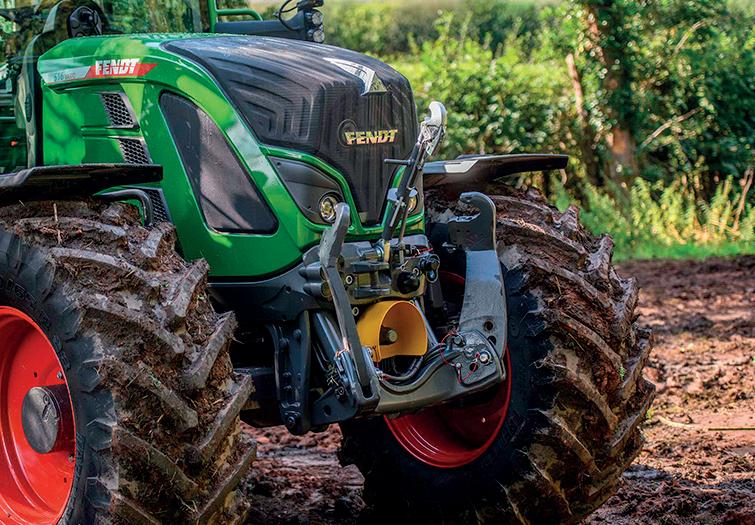
49 MAY 2023
Despite being a lighter weight machine, the unit delivered effectively in heavier draft work.
The front linkage was fully integrated into the machine.
MACHINERY ON TEST
Cab and operating system
JAligning with the larger 700, 900 and 1,000 Series as well as the smaller 300 models, the 500 Series uses Fendt’s VisioPlus cab with a FendtONE operation system.
For users without Fendt experience, the cab’s design and layout is quite different from competing machines and does lack some explanation of what certain symbols mean and what influence they have.
However, in the time we spent with the machine, our test team did become accustomed to the controls and their adaptability for specific tasks.
Adaptability and integration of implement control is a major point in the design and function of the FendtONE system.
Initially, the range of seemingly unmarked switches appears somewhat puzzling, however, as implements are assigned and saved to the tractor, their varied purpose becomes more logical.

Control
When operated with an IsoBus implement, the control is taken further with the option to use the in-built rate and section control alongside the guidance system.
By no means unique to Fendt, this level of technology integration is potentially a key point of the machine’s ability to work effectively in application and establishment tasks.
The console-mounted, 12-inch terminal is complemented by a second 10-inch dash.
We liked the option to move data between the screens, including placing the display on the dash and leaving the rate and section on the armrest.
Users requiring a third display can specify an additional unit which lowers from the roof and integrates with the first two.
The visual graphics of both screens were very good and the sensitivity and software
processing between the varied pages were highly refined, with a near-endless range of screen layouts possible, depending on the key information required.
Integrated into the main console, the Fendt Guide GPS system won praise from the test team for its performance and functionality.

Operating with a roofintegrated Novatel receiver, the non-subscription, Egnosdelivered signal was stable and repeatable across challenging terrain, with consistent pass-topass accuracy for most field and tillage activities.
Users looking for improved signal accuracy can opt for the optional RTK guidance package.
Setting up tasks and automated processes for the headland management system using the drag-and-drop feature of the controller was not without frustration. However, following some operator manual referencing we were able to generate some fairly complex assigned processes.
In use we had mixed options on this level of automation for machines with multiple operators as, although it was effective and highly refined,
the option to engage the pto, activate hydraulics and select a cruise speed following the press of the ‘go’ button could result in some fairly disastrous outcomes if an operator is unwary or an incorrectly attached implement was used.
Joystick
Positioned alongside the main armrest controller, the 3L joystick can be assigned to a claimed 27 functions and includes a smaller, thumb joystick on top of the main unit itself.

Users with IsoBus implements or a loader would find this control particularly appealing as it allowed the integration of spools and direction changes.
The general fit and finish of the cab and interior was very good, with plenty of seating, steering wheel adjustment, and two large storage lockers.
Visibility from the large, unsplit windscreen was excellent and, although our test machine was not provided with a loader, the combination of hydraulic control, manoeuvrability and visibility could make the 516 an effective loader tractor.
A surprise was the lack of an opening right-hand door. Fendt advises this is an option and although it is rarely used, the lack of a low-level opening did make the task of cleaning and blowing out the cab harder, with the dirt stubbornly collecting in the bottom right-hand side.
50
MAY 2023
The console, controller and joystick are highly customisable, however some controls were not easily identified.
The well-built FendtONE cab layout is shared with several other series in the manufacturer’s range.
Likes and gripes
JPositives
rOperating system
rRange of control configurations
rRide quality
rLED work lighting
rCab storage
rVisibility
rManoeuvrability
Verdict
JOur test team were consistently impressed with the capabilities and performance of the relatively small tractor, with few concerns as a replacement for a larger six-cylinder variant.
The lighter-weight machine with the capacity to add significant ballast, including up to 1.2 tonnes on the rear axle, created a machine which could perform effectively in crop care applications and heavier cultivation.
If we were buying the machine as an owner-operator – or for a single driver, the level of complexity and ability to fine-tune the controls
Business Development Manager
Agriconnect is a business unit within the Arc network, a global events, data, and media platform. Arc is a fast-growing global events, data, and media platform with a varied portfolio content led portals, magazines, and events. Agriconnect’s mission is to empower, inspire, and connect people and business in agriculture by creating trusted content and connections that help the industry thrive.
Since 1844, the brands of Agriconnect have been the trusted source of information for farmers and with brands like Farmers Guardian, events, like LAMMA and Farm Business Innovation, and digital platforms, like FG Insights, Agriconnect continues to bring together the British farming community.

THE ROLE:
• We are now looking for a motivated and driven salesperson to join our Sales team.
• The main function of the role is to develop business through growth in revenue, yield, and to increase customer numbers. You will be required to identify new opportunities and influence companies’ media buying habits within the agricultural sector. Due to the ever-changing nature of the industry, this person will have the ability to spot new avenues and exploit market trends.
• Hours: 35 hours per week – Mon – Fri
• Location: Preston – temporary hybrid remote
JNegatives
rToolbox design
rAwkward Adblue filling
rShorter service interval length
rComplexity of controls for the occasional operator
rSingle pto stub

• Salary: Competitive, dependant on experience.
SKILLS & EXPERIENCE:
• Own, support and fully develop specific market sectors
• Conduct sales presentations by telephone, email or face to face to existing and prospective clients in order to develop existing business and generate new business wherever possible.
• Advise existing and new customers on the most effective solution to meet client needs within the Agriconnect portfolio.
• Continually seek and develop new sales & opportunities.
• Ability to accurately forecast future sales
• Keep abreast of all current trends, activities and relevant news within agriculture and specific sector

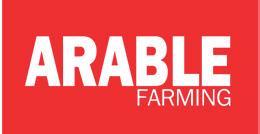
• An interest in agriculture
to suit a specific task and implement are unmatched. Combined with the guidance, rate and section control and loader potential, it does offer the possibility of delivering an all-in-one package for farming businesses looking to reduce their tractor numbers but maintain flexibility in how they operate.
Where we would have some reservations are the initial price to deliver the full suite of abilities and the complexity of the overall machine when working with less experienced operators or seasonal workers.
• Highly motivated & driven, with an ability to meet ambitious performance goals
• Be enthusiastic and motivated to continually explore new opportunities, whilst possessing a natural inquisitive nature
• Excellent communication written and interpersonal skills
We offer an excellent package including:
• A competitive basic salary
• 25 days holiday increasing to 27 after two years
• An extra day off on your birthday
• Free life assurance
• Contributory pension scheme
• Employee assistance programme
Arc has ambitious plans for growth, and this is an opportunity to be part of our continuing success story whilst enjoying a fabulous work/ life balance.
We strive to create a culture that is open and respectful, where differences are valued and celebrated. We want everyone to be able to reach their full potential, so we are committed to cultivating a company that promotes inclusion and belonging.
To apply for this role, please email amber.tabiner@agriconnect.com
51 ON TEST MACHINERY MAY 2023
The pto shaft was a fixed six-spline output.
‘Handle anything’ tractors delivering value all year
Weighing up the options for high horsepower tractors to tackle a wide range of jobs has seen half-track join wheels in one Lincolnshire farm business’ fleet. Jane Carley reports.
From their first Xerion 3800 purchased in 2005 to the sparkling new Axion 960 Terra Trac delivered on-farm in April 2023, it is fair to say that F. Pickering and Sons have a quite a bit of experience with Claas tractors.

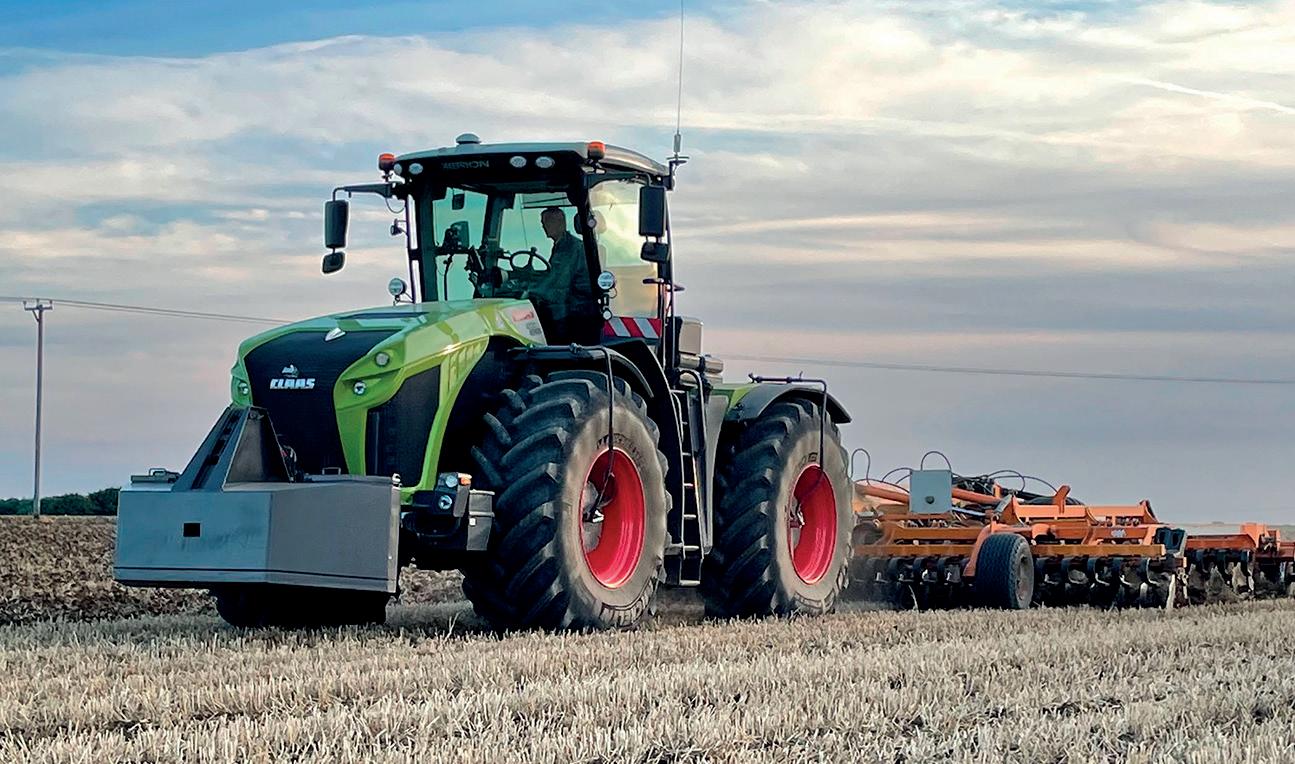
“The Xerions have suited us because they can handle anything from ‘big tractor duties’ - draft work and cultivations - to working on the clamp,” says Matt Pickering.
“We work for a number of AD plants ensiling grass and maize in partnership with local contractor David Fox and the Xerion has proved invaluable for clamp compaction.”
There is certainly the work to keep a big tractor busy all year round – with close to 2,000 hectares of drilling on the family farm and contracts and 2,800ha
of combining, the AD work is the perfect complement to arable operations.
Digestate application with tankers and dribble bars in autumn and spring is followed by 900ha of maize drilling, and the team of eight then moves onto grass and wholecrop silage before the cereal and maize harvests.
Weight distribution
Matt’s father, Robert, the main operator of the newest Xerion, a 2021 plate 4200 model, says:
“With the addition of CTIS working with VF tyres it can do any job, operating down at 7psi. You can take extra weight off and what remains is distributed over a large surface area, which makes a big difference in a wet spring.”
High horsepower tractor choice has expanded significantly since the first Xerion 3800
arrived at Grange Farm, Harpswell, and Matt says that alternatives have certainly been explored.
“There are a lot of good tractors available now. The Case Quadtrac comes closest for arable work but wouldn’t be suitable for the clamp. Plus we do a lot of roadwork - up to a 40 mile radius - with the Xerion we know that we can just go when we need to.”
The 445hp Axion 960 Terra Trac half-track was a specified after a lot of consideration, he adds.
“We had an Axion 950 wheeled tractor (410hp) with 7500 hours on the clock which was out of its extended warranty period. All the tractors are on service contracts as it helps us calculate exactly what they will cost us over their working life, so it was time to change. We looked at a new wheeled Axion but thought that the half-track drive would put the power down better and give more traction.”
Demos with a Flatlift and
then drilling wheat in land that had come out of sugar beet showed its potential.
“It didn’t make a mark,” says Robert. “When you are working for others it is so important to get that right.”
Yet a wheeled tractor almost got the nod, Matt adds.
“We also demoed the Fendt 1050 and I liked it very much; it’s certainly the nearest competitor to the Xerion. But we could see the potential of the half-track system and wanted to try something different; added to which the relationship that we have with our dealer, Claas Eastern is hard to overlook.”
Direct drilling
The Axion 960 TT also gives some food for thought for the future. Drilling is an increasingly important service and a 6m Horsch Avatar has joined the 8m Vaderstad Rapid in the fleet.
“We may switch the 6m for a 12m Avatar,” Matt explains.
“Many of our customers are just dipping their toe into direct
52 MACHINERY TRACTORS MAY 2023
A Claas Xerion 4200 and Axion 960 Terra Trac are the cornerstone of F.
The Xerion is flexible enough to handle cultivations and clamp work.
tractors round
drilling; on a triple mower and a 32m dribble bar. Three new 185hp Arion 660s were added in 2022, used mainly for logistics – including slurry tankering and silage carting. Over the years, Claas tractors have replaced a mixed fleet on the farm, but the door is not closed to other brands.

partly from operator preference but also for the fuel savings.
“You are always in the right gear, which comes into its own for roadwork,” Robert says.
Fuel usage
Pickering and Sons’ business. drilling and the smaller drill allows them to try it out; but with the wet conditions I would expect them to look at it more seriously in the future.”
Tyre choice for the front axle will be key in difficult terrain, he suggests – the Michelin Axiobib 710/60 R34 being a pricey, but ideal partner for the 735mm tracks.
The fleet also includes a 235hp Axion 830 used for maize
“You could argue that a JCB Fastrac would be better than the Arions for what they do,” says Matt, “But again it comes down to dealer support, and the operators do like them.”
“Ride comfort is very good,” adds Robert, “and comparing these Arions with the 2019 plate models they replaced, there’s a big difference in the smoothness of the transmissions and in general build quality.”
Transmissions are the Claas CMatic CVT throughout,

Telematics is mainly deployed on the business’s combines, although Matt finds it useful for monitoring fuel usage on the tractors.
“It may be something we get more out of in the future; one benefit is remote service access so the dealer can diagnose any issues and we also get service alerts which are handy with such a large fleet. However, each driver has his own machine, so they look after them very well and are on top of service schedules.”
With Claas tractors still in a relative minority on arable

farms, he admits that resale values have lagged behind other brands.
“But that’s starting to change; we were pleasantly surprised with the offer for the Axion 950. I think that’s down to the better quality finish and tech developments on the latest tractors,” he says. “We’re seeing more of our neighbours switch to the brand.”

Robert suggests that plenty of horsepower will be the way forward for contracting businesses in the future.
“I’ve gone up 400hp during my career having started with a David Brown 770. We took on 400ha of land for a new customer last year and drilling that would have taken most of the autumnwe completed it in three days. We aim to do more with the same labour resources, making the best use of machinery year round.”
53 TRACTORS MACHINERY MAY 2023
Robert (left) and Matt Pickering have secured increased workloads.
The Arion 830 tackles a range of work, from operating a dribble bar to mowing and maize drilling.
Michelin Axiobibs on the front axle of the Axion 960 Terra Trac are a good match for the flotation offered by the half tracks.
Developers of autonomous machines are now considering how they will market their products and the alliances that will be formed with implement suppliers. Agxeed is making good progress discovers Jane Carley.
Coming soon to the digital shed
Founded in 2018, Netherlands-based AgXeed has made the transition from drawing board to robot production in a short space of time. The company now has 30 of its AgBots with customers across Europe, with the first models due in the UK this summer.
Founder and chief executive Joris Hiddema has a long history in engineering with roles at John Deere and Agco’s Grubbervorst technology centre. He established AgXeed with three similarly-experienced partners, their goal being to offer an autonomous solution to some of farming’s challenges.
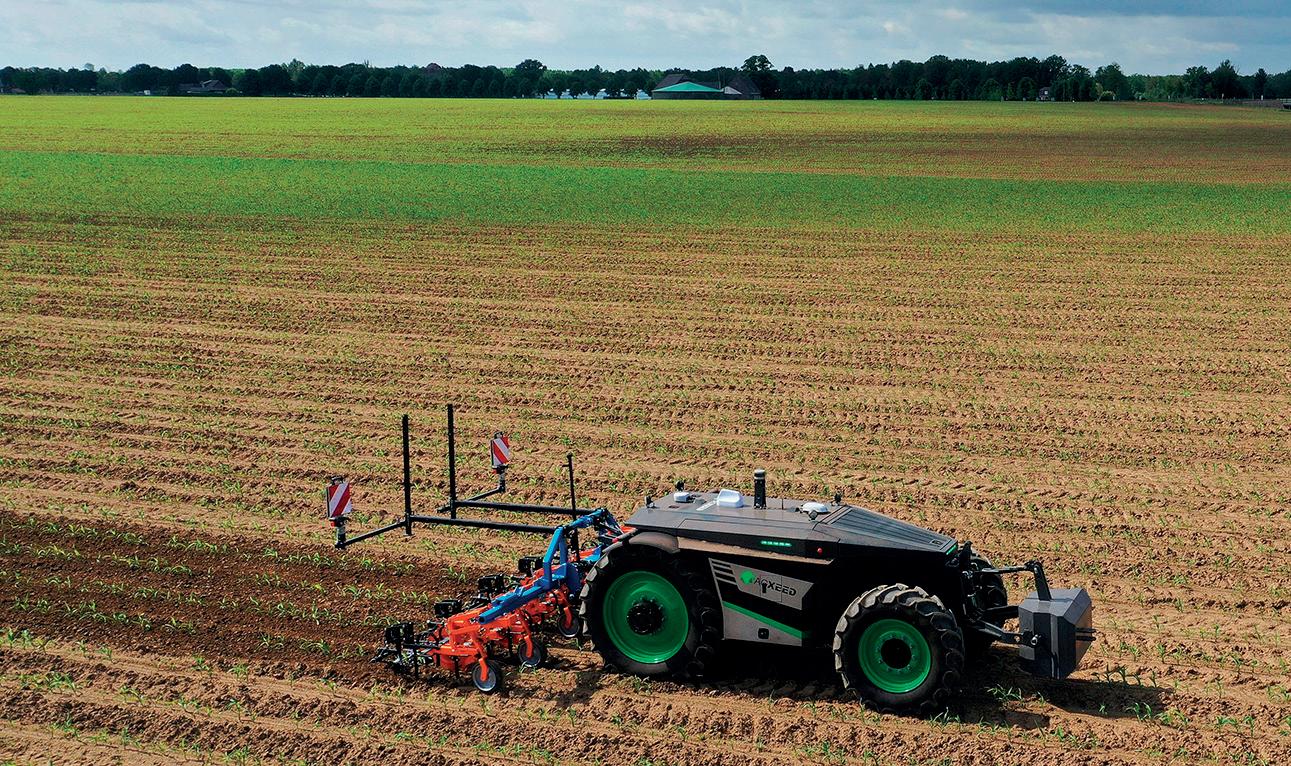
The company rolled out its
first prototype in 2019 and began commercial production in 2022, setting up an international distribution network. It has also attracted investment from some key partners in the machinery trade, notably Claas, which distributes AgXeed products through selected dealers in Germany and Switzerland, including via a rental model. Amazone also came on board in 2022 and has adapted implements from its existing range to work with the AgBots.
In the UK, AgXeed is represented by technology specialists SoilEssentials and AS Communications (ASC).
Graham Ralston, hardware
director of SoilEssentials, outlines the issues facing farm mechanisation in the 21st century which could be addressed with the use of robots.
“To increase the scale of their businesses, farmers have invested in large, heavy equipment, which ties up working capital, in order to complete the work in the timescales available. Tractor prices are increased by increasing levels of ‘cab comforts’ which seem to be needed to attract a dwindling workforce.”
The effect of this, he maintains, is soil compaction and a consequent cycle of remediation. Meanwhile, customers are increasingly looking for traceability – likely to be mandatory eventually – and time management has become an issue. This is particularly the case for smaller businesses who may have diversified enterprises from which time spent in the tractor seat can be a distraction.
Farmer and director of ASC
Will Mumford echoes the labour challenge, plus the increasingly unpredictable climate exacerbating the issues caused by heavy machinery.
He says: “We need to remove weight but we now don’t have the option of 20-30 people operating smaller machines, so automation will be the key.”
Benefits
According to Joris Hiddema, the first customers are already seeing the benefits of deploying AgBots with increasing hours in the field carried out autonomously.
“The farmer can plan ahead and optimise as he goes, using precision farming to increase yield while gathering data for business decisions,” he says.
For example, on a 200-hectare farm near Mannheim in Germany’s key vegetable region, grower Volker Hack has carried out 350 hours work in two months, with


54 MACHINERY TRACTORS MAY 2023
Agxeed has AgBots out working with customers and has formed alliances with several major machinery manufacturers, including Amazone and Claas.
Front and rear linkages and optional electric pto allow the AgBot to be used with a range of existing implement designs.
The four-wheel AgBot has adjustable track width and can be equipped with wheels up to 710mm for a variety of tasks.
the AgBot working day and night.
SoilEssentials was attracted to the product by its quality design and engineering, while the standard three-point linkage fitted means that customers can use existing implements with the AgBot, says Mr Ralston.

Both ASC and SoilEssentials are working to develop their skills with the products, but already have experience with generating the accurate maps of field boundaries needed to operate them.

The maps are created on foot and the loaded up into the AgXeed online portal, allowing the operator to manage and pre-plan work.
“Purchasers need to consider the location of land parcels and logistics, and how the operator is going to integrate with the machine, setting up alerts for refills of fuel, seed and fertiliser,” says Mr Mumford.
“Having studied the autonomous machines on the market, I believe AgXeed’s AgBots are the right choice, comparable with a ‘conventional tractor’. As a farmer, I also wanted to be confident that this would be the right choice for me.”
Graham Ralston outlines the considerations for farmers before investing in an autonomous machine.
“Think about which tasks it can perform on your farm, where it will work and how you will manage the logistics. Also who will need to integrate with it - so who needs to ‘buy into’ the system - and how they will be trained.”
The AgXeed range
JThe AgXeed range includes three models to suit different applications, with wheeled or tracked chassis. All feature hybrid drive from a diesel engine and optional electric pto.
The AgBot 5.115T2 is fitted with rubber crawler tracks, adjustable for track widths from 1.9 to 3.2 metres and is powered by a 156hp Stage V Deutz engine. With cat 2/3 linkages front and rear, it offers three tonnes and 8t lift capacity respectively and up to four double acting spool valves.
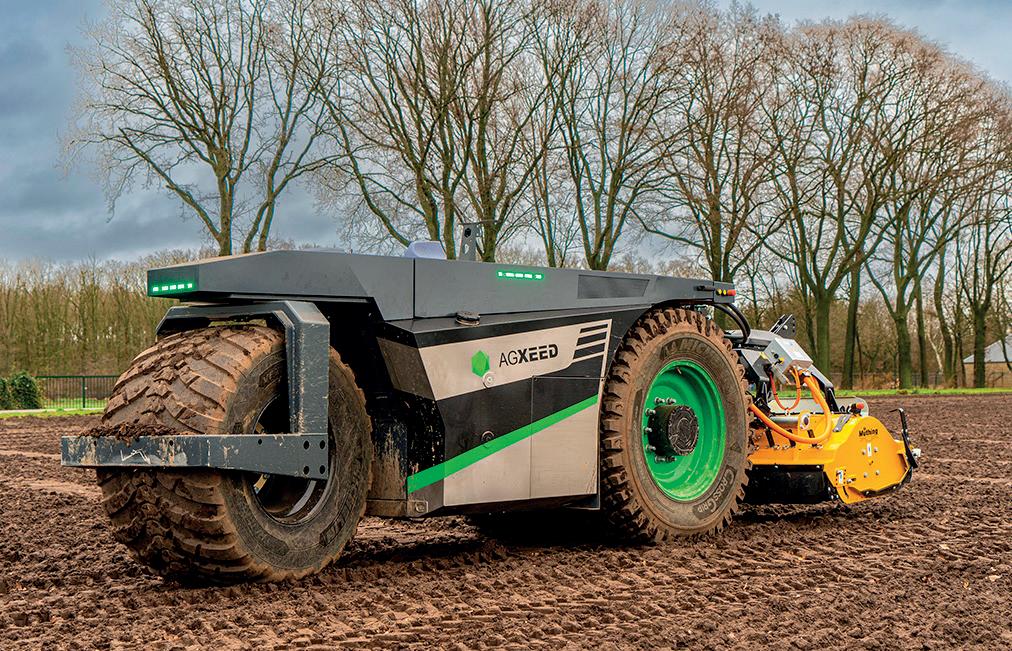
Designed for light soil applications and maintenance, the four-wheeled AgBot 2.055W4 has a 75hp Stage V Deutz engine and lift capacity of 1.5t and 4t front and rear and up to three spool valves. Track width is adjustable from 1.5-3m and there is a choice of wheel/ tyre configurations including 710mm wide flotations.
Three-wheel layout on the 2.055W3 is designed to offer a light, even tread and this model is targeted at orchards and similar applications. It shares the 75hp Deutz power unit with its four-wheel brother and has a cat 2 three-point linkage with 2.5t lift capacity plus three spool valves. Wide tyres up to 710mm minimise ground impact.
“The lack of a cab enables autonomous machines to be omnidirectional,” says Mr Hiddema. “You can hitch a front mower or a rear mulcher on either linkage and work in either direction to suit your requirements.”
Mr Ralston says he can see applications in the UK for repetitive tasks such as grass mowing or to free up an operator for other jobs during drilling.
“The AgBot could take care of a 3m drill while the operator gets on with rolling; but he’s then
also already in the field when it needs refilling with seed.”
Communication is via RTK GNSS for guidance and positioning; AgBots are connected to the AgXeed portal which allows management by farm, field and part-fields, using a ‘digital shed’ where AgBots are combined with implements ahead of being assigned a specific routing for the task in question.
This considers the mounting position, size and settings of the implement, with the routing algorithm incorporating data on the desired turning radius, number of headlands, routing mode and overlap.
All tasks can be stored for later execution or sent to the chosen combination for immediate action.
A remote control is used to attach implements and navigate AgBots to the field, where operation is autonomous.
Work can be monitored remotely via a camera on
the machine and the AgXeed portal allows remote access for servicing. IsoBus integration of implements means that machine failures such as a clogged seed tube on a planter are communicated as an error code on the phone app version of the portal – AgXeed is working with its implement partners on standard IsoBus error codes for this.
“Remote access is available to AgXeed and its distributors,” says Mr Hiddema, “This means that many issues can be quickly fixed remotely.”
Operations
The operations and analysis section of the portal gives a full overview: fields and part fields, orchards, planned, running and executed tasks, as well as live telemetry information from running combinations. A complete history of the information gathered while the combinations were working is available, including time and efficiency analysis, fuel consumption data and application quantities, and is stored with a time stamp.
While the AgXeed team concede that purchase prices for autonomous equipment will always be higher than their manned equivalent, they stress that lower lifetime costs can be achieved with the lower service, labour and fuel costs on offer.
55
MACHINERY MAY 2023
TRACTORS
The three-wheel AgBot layout is designed to minimise its impact on soil and is aimed at orchard or similar applications.
The lack of a cab enables autonomous machines to be omnidirectional JORIS HIDDEMA
High capacity handling is the order of the day for one East Midlands farm which has recently invested in JCB’s highest capacity AgriXtra Loadall complete with a six-tonne lift capacity. Geoff Ashcroft reports.

Efficient bulk handling underpins diversification
Speed and efficiency are key criteria on which Fred Walter and Son judge their telehandler choices.
Based at Sutton Grange Farm, Sutton-cum-Lound, near Retford, Nottinghamshire, the farming
business run by father and son team Fred and Sam Walter comprises 1,000 hectares of grass, arable and maize crops with on-farm storage that can accommodate 17,000 tonnes of grain.

“With a lot of sandy ground, we took the decision to diversify
many years ago,” says Sam.
“We worked closely with grain merchants to adapt our buildings to suit. We have since added an AD plant as a separate enterprise, for which we grow and harvest 2,000 acres of maize.”
Sutton Grange Farm’s grain storage operation sees around 30,000t of grain pass through the yard annually, along with a further 6,000t of wood pellets, which reinforces the farm’s decision to operate three JCB telehandlers supplied by local dealer Peacock and Binnington.
“If we have a day when there’s 1,200 tonnes of grain to go out, we need big buckets and plenty of them,” says Sam. “With a good bushel weight and a
four-tonne bucket, we can load 29-tonne artics in seven passes. And with that level of performance, lorry drivers don’t waste much time being filled.”
Experience
The farm has gained a lot of materials handling experience over the years and quickly ruled out loading shovels with toe-tip buckets because of their bulky size and cost.
“Telescopic handlers are an ideal solution for our farming activities,” Sam says. “With multiple steering modes, you have great manoeuvrability in the buildings, particularly when cleaning out corners. We also have a machine that is relatively Continues over the page.
56 MACHINERY MATERIALS HANDLING MAY 2023
The generous four-tonne bucket can load grain bulkers in just seven passes.
If we have a day when there’s 1,200t of grain to go out, we need big buckets and plenty of them
SAM WALTER
You dreamt it. We built it.

The new Fendt 700 Vario Gen7.
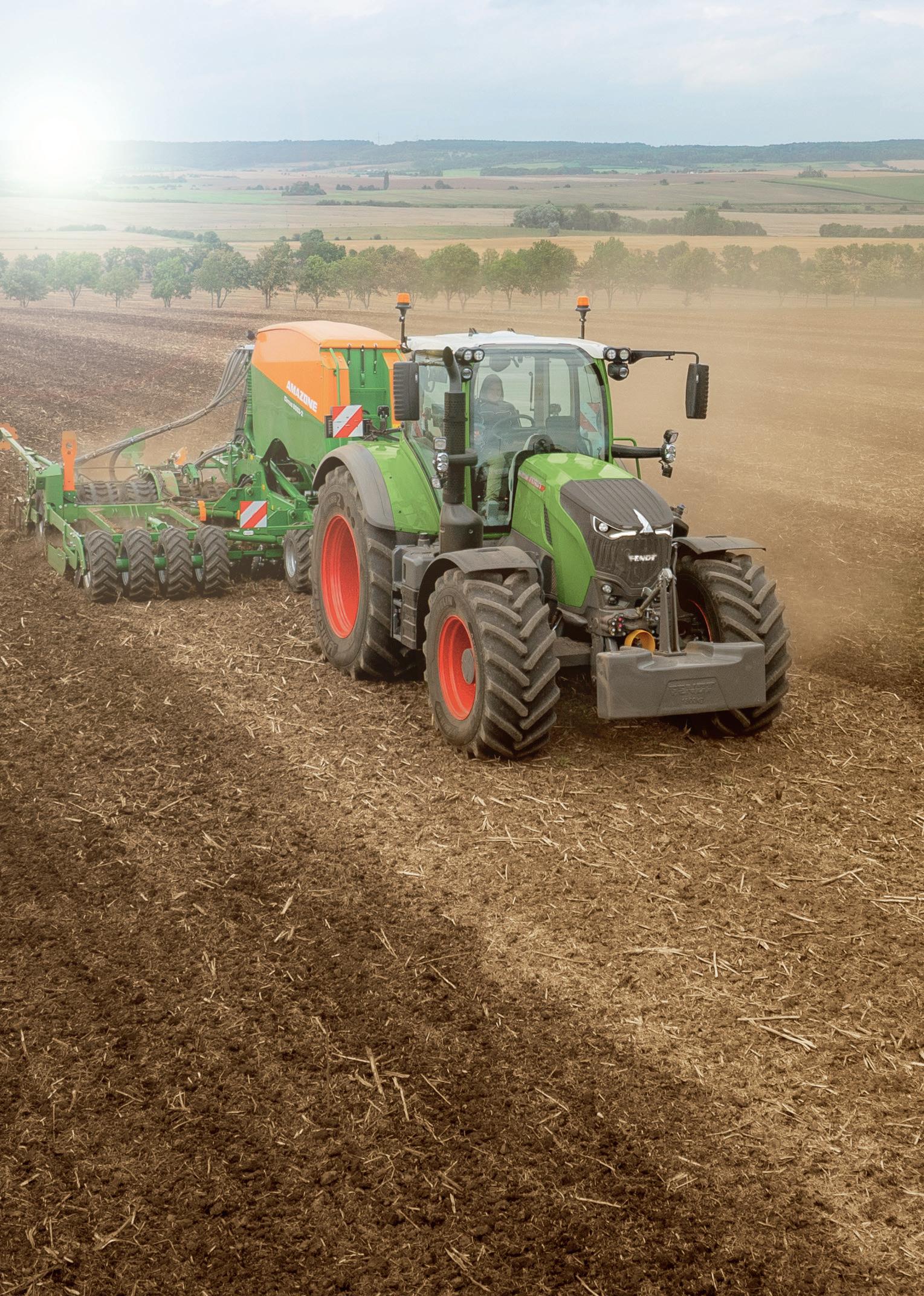
Performance on a new scale. Packed full of technology, such as a newly developed engine with Fendt iD low-speed concept, the intelligent VarioDrive driveline with variable all-wheel drive, combined with high-performance hydraulics with a delivery rate of up to 220 l/min, make the Fendt 700 Vario Gen7 a pioneer in the 200-300 hp class. Learn more: fendt.com/nextgen700
It’s Fendt. Because we understand Agriculture.

fendt.co.uk Fendt is a worldwide brand of AGCO Scan to fi nd out more
MACHINERY MATERIALS HANDLING

compact and agile compared to an industrial loader.”
For materials handling, the farm has recently invested in JCB’s flagship farm-spec telehandler, the 560-80 AgriXtra – its six-tonne lift capacity beats the farm’s previous heavy lifting 550-80 model by half a tonne.


“For us, materials handling is all about how quickly we can move a tonne,” Sam says.
Alongside the heavy lifter sits a smaller 541-70 and a high-reach 536-95 that are both used around the yard, but are used more widely for farm work. These two very different machines have their own strengths, with the 536-95’s two-stage boom favoured for its generous lift height and forward reach. Combined with a 3m grain pusher attachment, the 536-95
has no problem stockpiling grain in the farm’s 16 stores, making the most of storage capacity.
Hours
Collectively, the three handlers are racking up some 360 hours/ month, but with the 560-80 as the mainstay of the grain handling operation, it is currently clocking around 150 hours/ month. Complete with 8,000hour warranty, the handler will remain on-farm for four years and as part of its specification – as with the farm’s two other telehandler models – it is shod on Michelin Bib Load tyres to suit the yard-based workload and trundling around on concrete.
“The semi-industrial tread blocks are far tougher than standard cleated agricultural

tyres,” says Sam. “We’ll wear through two sets in four years, and over that time, the 560-80 will clock-up over 7,000 hours. Without them, we’d be buying tyres every year.”
He adds that to keep a lid on operating costs, anything with an engine is looked after by supplying dealers with comprehensive service and warranty packages. This also extends to the farm’s two Fendt 936 and four Fendt 720 tractors.
The farm’s reasoning is that with the cost of kit on a seemingly ever-increasing spiral, dealer service records should translate into higher trade-in values when the time comes to replace.

“We’ve already proved that it’s the sensible route to maximising trade-in values because of credible service history and traceability,” Sam says. “And it’s all carried out on-farm, so there’s little downtime as a result.”
The 560-80 AgriXtra model is powered by a 4.8-litre JCB DieselMax four-cylinder diesel engine producing 145hp, with a DPF and diesel exhaust fluid used to achieve the latest emissions control. The handler also gets the British maker’s DualTech VT transmission, which combines hydrostatic
fluidity and control, with the efficiency of a powershift.
Without the use of a torque converter, the DualTech VT transmission uses the hydrostatic element up to 19kph, before automatically switching to powershift with a direct drive capability to improve efficiency on-road and when towing.
“The DualTech transmission has taken a bit of getting used to, as the telehandler spends most of its time in hydrostatic mode,” he says. “We wanted a full-powershift like its predecessor, but that wasn’t an option when it came to model availability. And lift capacity was more important than transmission options.”
He says that operators have got used to the transmission, from spending plenty of time in the cab.
“The level of control available does let you set engine revs independently of forward speed. This makes the most of loader power for faster cycle times, when pushing the boom out and up, to load over the side of lorries.”
Against its predecessor, the 560-80 gets the CommandPlus cab with 12% more internal space, a 50% reduction with in-cab noise levels and 14% better upward visibility through a seamless one-piece curved front windscreen.
58 MAY 2023
Semi-industrial Michelin Bib Load tyres are specified to suit the yard-based workload. The materials handler fleet comprises highreach 536-95, 560-80 and 541-70 models.
Alongside buckets of various sizes, widths and capacities are forks, augers, grabs, bale spikes, log grab, bag handlers and bucket-brushes.
While its maximum lift capacity is 6t, the handler can raise 3t to its full height of 7.9m. A Z-bar linkage, more commonly found on wheeled loaders, gives 6.5t of breakout force,
MATERIALS HANDLING MACHINERY

handling and loading tasks,” says Sam.
In the hydraulics department, JCB has equipped the 560-80 with regenerative hydraulics that make the most of gravity, recovering energy to increase the speed of boom retraction and lowering.
“Cycle times are really quite good, and the speed comes from not needing to rev the engine very hard,” he adds.
When it comes to attachment choices, Fred Walter and Son has committed to JCB’s Q-Fit headstock. Chosen for compatibility across all the three machines and to suit the farm’s legacy of attachments acquired over the years, it has proved a versatile solution for the business.
endless, with over 25 different types accessible to all three telehandlers. Alongside buckets of various sizes, widths and capacities are forks, augers, grabs, bale spikes, log grab, bag handlers and bucket-brushes. Even the farm’s diesel bowser is equipped with Q-Fit brackets, as is a portable wall to partition a livestock building.
“Safe handling is the key for us,” he says. “We’ve adapted most things that need to be moved around the yard with a set of loader brackets.”
making light work of higher capacity grain buckets.

“It does everything we ask of it. And it does it just that little bit better than our old 550 too, improving our efficiency with bulk

“We’ve adapted all sorts of attachments to use JCB’s Q-Fit brackets, to suit any form of materials handling task. Though we do keep dedicated three- and four-tonne grain buckets purely for use in the stores.”

The list of attachments seems

“When you have a telehandler with such strong lifting performance, this is far safer than swinging something off chains or straps,” he says. “There’s very little that we cannot lift safely and efficiently.
“Would I go bigger? Yes I would, then I could use a bigger bucket, and that all adds up to more efficiency when dealing with lorries,” says Sam.
59 MAY 2023 From combines to culitivators and everything in between, you’re sure to find what you need on FGBuyandSell.com. Start listing your items FREE today! Browse. Sell. Buy at FGBuyandSell.com
Lemken Solitaire DT
Continuing the trend in increased soil conservation, a growing list of new and established manufacturers have entered the direct drilling fold. James Huyton takes a look at what was on offer at the Agrii drill demo day.
Rain stops play on demo day
Following the success of last year’s direct drill demo day held in Lincolnshire, Agrii reconvened in Kent in April, with a wider range of drill manufacturers.
Held at Court Lodge Farm, Maidstone, this year’s event aimed to give prospective buyers an insight into the market offering, alongside demonstrations in a variety of
field conditions. On hand to offer practical in-field advice were Agrii representatives Steve Corbett and Neil Harper. Court Lodge Farm manager Dom Hughes looks after 800 hectares of arable cropping on behalf of M.C. Attwood and Partners. The farm’s soils are largely silty clay loam and the rotation is predominately winter cropping with the addition of spring barley.
JLemken debuted its Solitaire DT drill at the event. This drill uses a flexible, modular design that the manufacturer claims performs across a range of soil types. Currently available in fourand six-metre working widths, Lemken plans to introduce a 9m option next year.


A split seed and fertiliser tank is available in 3,400- and 5,100-litre capacities.
Leading press wheels are designed to consolidate the seedbed prior to the initial cutting disc. Users who do not require pre-consolidation can specify optional shatter
The event attracted more than 150 growers keen to learn about the latest manufacturer developments. Recent years have seen changes in several farming policies, with the Sustainable Farming Incentive soil standards providing payments to farmers using beneficial soil health techniques. The event highlighted direct drilling as one part of a larger soil health picture.
Mr Corbett said: “Fundamentally, building a friable drilling zone through incorporation of organic matter in the soil is key to zero till.
boards, with most working depth adjustments being made hydraulically from the cab.
The demonstrated machine used a leading wavy-edged disc to cut the surface trash, followed by a fertiliser coulter bar, which could also be used to establish inter-row crops.
A final set of packing tyres consolidates the seedbed before double disc coulters place the seed (see inset). Row centres can be set at both 125mm and 167mm. Optional features include a third tank, following harrow and independent hydraulic Optidisc coulters.
Cover crops have the potential to help alleviate soil compaction in conjunction with subsoiling.” Manufacturers were assigned same-sized plots, with each machine establishing spring barley at the same seed rate. Once sown, the plots will be managed to harvest from which yield data will be taken.
Unfortunately, due to inclement March weather, ground conditions on the day were unsuitable for drilling.
Continues on page 62.
60 MACHINERY DRILLS MAY 2023
PERFORMANCE WITH PRECISION MAESTRO

The Maestro offers the largest range of precision single-seed drills on the UK market from 6 to 36 rows. Choose AirVac (CV, RV & SV models) or AirSpeed (CX, RX & SX models) Precision Metering for reliable grain embedding at high speed in crops from OSR to maize. HORSCH.COM


AirVac: a vacuum for reliable singulation and high precision for sowing speeds up to 12kph. Great flexibility for the widest variety of crops and sowing conditions, enabling the sowing window to be increased if wet.
AirSpeed: overpressure for precise singulation giving perfect plant spacings at high operational speeds with consistent embedding of the grain.





TOGETHER FOR A HEALTHY AGRICULTURE

#FUTUREGROUND
Scan to find out more
MACHINERY DRILLS
Virkar Dynamic DC
JCurrently offered in four- to six-metre options with a 12m version due later in the year, the Virkar is fitted with a 5,300-litre hopper capable of split seed and fertiliser or single use. Factory-set row centres can be specified at 190mm to 250mm.

Features include a rear steering axle capable of headland tracking, which allows for reduced turning circles. The manufacturer
claims this system offers exceptional contour following when working across slopes. Leading discs cut surface trash and reduce soil burst from the following tine. Hydraulic coulter legs can deliver a penetrating pressure up to 280kg per row, with twin formation press wheels and harrows creating soil to seed contact.

Full IsoBus compatibility and variable rate control is available as an option.
Vaderstad Rapid A 600S
JA long-standing part of the Vaderstad range, the Rapid has undergone some recent

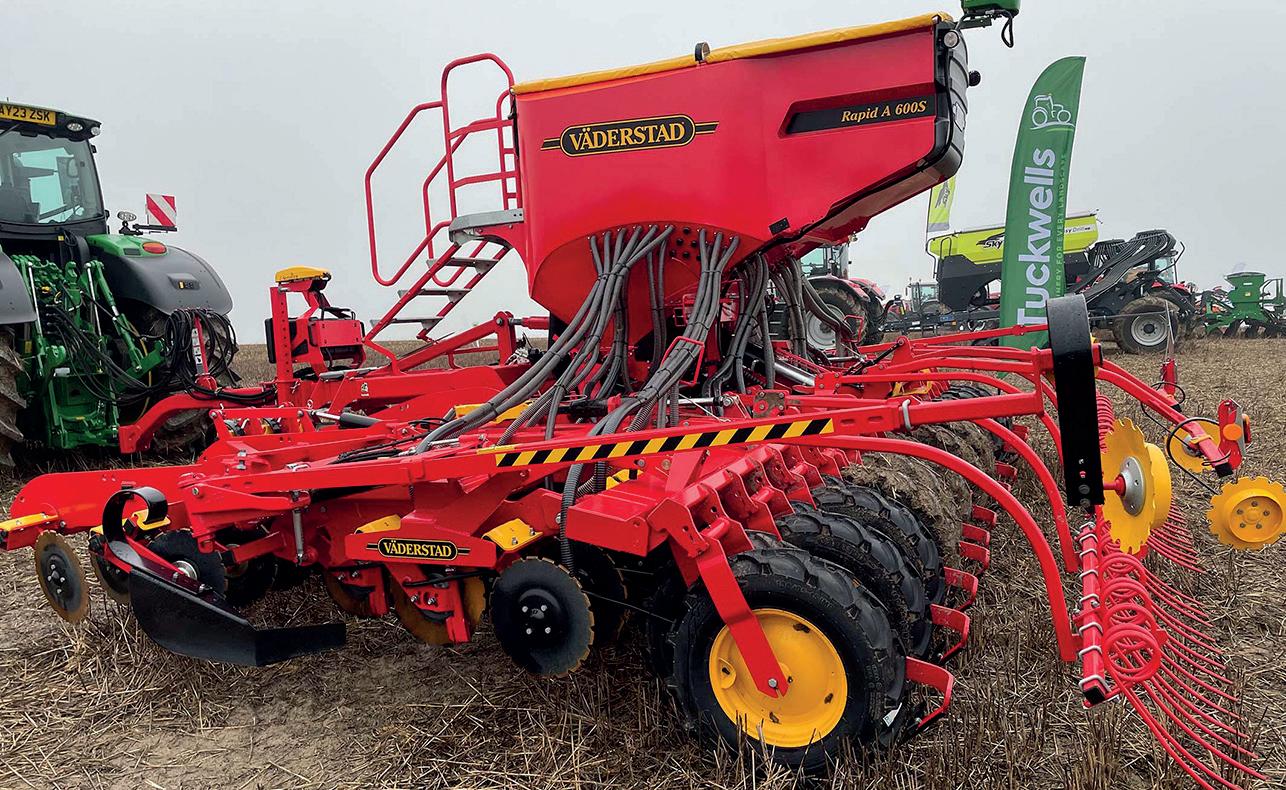
adaptations to accommodate its use as a low disturbance drill. The changes extend largely to
three rows of disc coulters set at a shallower angle to reduce soil disturbance. The manufacturer claims this disc formation allows for greater trash flow in green cover crops.

Accurate seed placement when sowing at speed is achieved through the Seed Eye system. Sensors in the drill allow seed to be counted at a rate of up to 250 seeds per second through each coulter. Linked with guidance on the
tractor and implement, a 30mm bout to bout accuracy can be achieved.
Blockage monitors, variable rate control and sectional control can all be linked through the iPad-based E-controller.
62 MAY 2023
John Deere 750A
JClaimed to be John Deere’s most popular drilling format, the 750A has seen several modifications for the European market in recent years. The manufacturer highlights a larger diameter, spoked press wheel which is claimed to reduce soil and trash build up around the disc coulter.
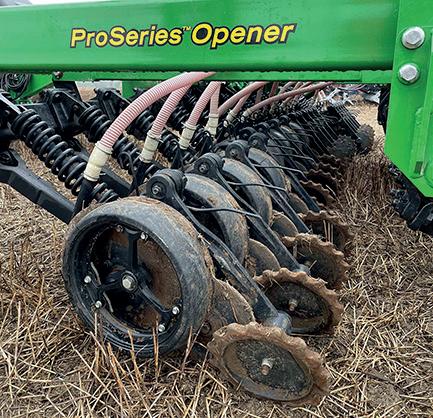

Manual adjustment of the spring-loaded coulter arms can deliver a claimed 250kg soil penetrating pressure. Each of the 36 disc coulters allow for manual depth adjustment through a sliding handle system. Set at a seven-degree angle, the disc coulters aim to reduce soil disturbance with serrated closing wheels forming the seed to soil contact. A split tank is available with a capacity of 2,300 litres alongside working widths of up to six metres.

63 DRILLS MACHINERY MAY 2023 Join the Evolution! Darwin got it right – we have to adapt to benefit from our conditions. Based on over 20 years’ direct drilling experience, our new Evolution drill adapts to fit your farm’s cropping, soils and weather. It’s thanks to some new cost-effective precision tech, plus alternative tines, hoppers and front disc toolbar. You say you want an Evolution? Contact your local Claydon dealer to find out more. Establishing a better way claydondrill.com info@claydondrill.com LOVE YOURSOIL
Continues on page 64.
MACHINERY DRILLS
Amazone Condor
JAmazone recommends an optimal forward speed of 8kph with the Condor but with working widths of up to 15 metres efficient work rates can still be achieved.
The three-way 7,800-litre split hopper allows the operator to sow both main crop, companion crop and fertiliser in one pass. The single shot approach delivers all three components out of the same coulter with the manufacturer claiming the independently operated coulter system allows for precise contour following.

Greater trash flow is achieved through the staggered coulter leg design, which Amazone says achieves better results compared to a disc coulter when working stoney land. Depth control is adjusted through a manual handle on each coulter.

GPS control allows for half width working around the headland and the Auto Point feature allows accurate start
and stop of seed flow when approaching and returning from a headland.
64
MAY 2023
Post-establishment and spring plant counts proved to be a differentiating factor among drills which took part in an on-farm trial in the North West.

Drill trials establish plant count benefits
The Hutchinsons/ CAS drill demonstration at Aston Grange Farm, near Runcorn, hosted by Stephen and Andrew Shaw in autumn 2022, was never designed to find the ‘best’ direct drill, but instead to provide a view on the performance of
different drills when drilling wheat into cover crops and the impact on the subsequent crop establishment.
Plant counts taken after establishment and again in the spring have shown some interesting differences.
Agronomist Daniel Baron says: “When it comes to Continues over the page.

SOLUTIONS FOR ALL SOILS

KUHN offers a wide range of equipment that improves land preparation according to farmers’ environmental conditions.

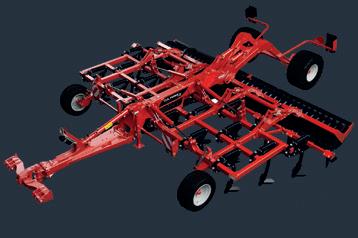





CULTIMER
CROP RANGE BE STRONG, BE KUHN See
PERFORMER

65 DRILLS MACHINERY MAY 2023
STRIGER OPTIMER
PROLANDER
us at:
13th & 14th June 2023
Cover crops can help remove moisture and widen the drilling window in the wetter North West.
MACHINERY DRILLS
deciding which drill to buy, or cover crop to sow, there is clearly no one-size-fits-all answer.
“Every farm, field and soil is different, and everyone has their preferred brand, not to mention budget.
“We wanted to trial several types of disc and tine drills and look at differences in wheat establishment as well as looking at the impact of a starter fertiliser.
“The high rainfall in the North West is one of the biggest
Farm facts
challenges to crop establishment and production.
“Up here we are looking at average rainfall of 900mm.
“Cover crops potentially play an important role in helping to pull moisture out of the ground and help dry up soils to widen the drilling window.
“It all comes down to being able to get onto the fields to drill in the autumn.”
The 10-hectare field used for the trial, previously in potatoes, was divided into sections of just under a hectare each with the three types of cover crop drilled and a range of different drill systems across each section.

Established in August, these consisted of:
crimson clover and berseem clover.
KWS Extase winter wheat was drilled on September 15 at 168kg/ha, aiming for 330 seeds/sq.m and 20% field loss to give 260 plants/sq.m.
“We also wanted to look at the effect that a starter fertiliser such as Primary P would have on the crop, so for the plots drilled with the Horsch, Avatar, Sky, Mzuri and Claydon drills, 10kg/ha of Primary P was used on half the plot,” adds Mr Baron.
Residue

Primary P had a significant impact on establishment with a 20-30% improvement over those plots that did not receive any.
“Plant counts were taken again in mid February and there was still a clear benefit from those trials that received the Primary-P. We will take the plots to harvest and then we will have the complete picture and be in a position to draw some final conclusions.”
r
r
r
1. Maxi Cover - buckwheat, white mustard and berseem clover - designed for rapid growth.
2. Maxi Veg - linseed, buckwheat, phacelia and crimson clover.
3. Maxi Impact - sunflowers, linseed, buckwheat, phacelia,
“By October 19, we were able to see some clear differences in establishment that showed that, generally, disc drills coped better than tine drills with high residue levels,” he says.
“Looking at individual drill performance, the Horsch Avatar had the best average establishment and the Kverneland U Drill did an excellent job even though it is not marketed as a direct drill. Most noticeably,
66
MAY 2023
We wanted to trial several types of disc and tine drills and look at differences in wheat establishment
DANIEL BARON
rS. and A. Shaw Aston Grange Farm, Aston, Runcorn, Cheshire
Rotation: 364 hectares of wheat, barley, oats and oilseed rape
120ha potatoes - owned and rented land
Soils: Sandy loam to silty clay loam
The trial aimed to provide a view on the performance of different drills when drilling wheat into cover crops.
The first part of our Horsch Focus 3TD test revealed how the German-built machine could be a strong competitor in the strip-till drill sector, suitable for medium-sized farms looking to change their crop establishment system, or offering larger units establishment flexibility. In part two, Toby Whatley looks at the machine’s metering and tank system and gives an overall verdict.
Horsch Focus 3TD test
Metering systems, tanks and controller







JThe 3,500-litre pressurised tank was supplied in a 60:40 split, and filling height was just under three metres to the opening lid.
This was not an issue to fill with a telehandler, however a tractor loader without a bag lift attachment would struggle to position a 600kg bag safely.
Airflow was supplied from a single 45-litre/minute
hydraulically-driven fan at the front of the machine.





Priority
When working with a tractor which does not have spool priority, the fan speed drops during lifting and lowering were not sufficient to create a low flow alarm. However, if priority was available on the tractor, it would be a sensible choice. For those looking for greater
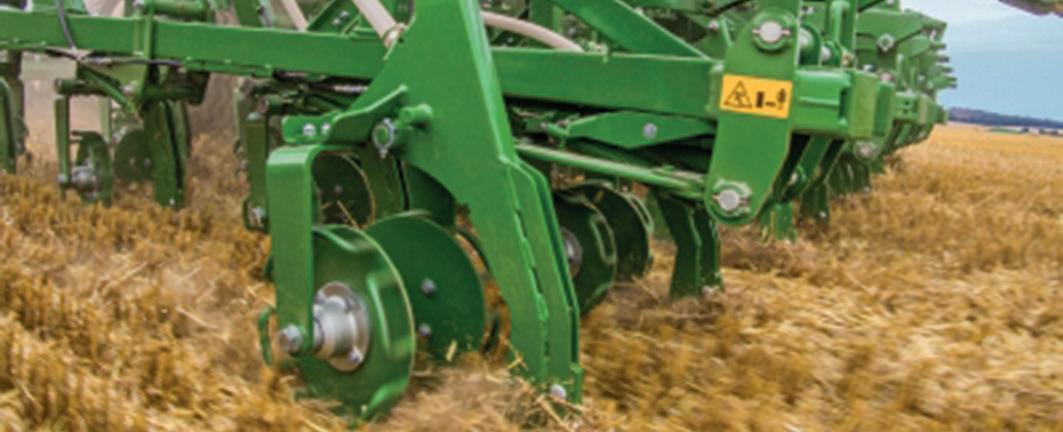


flexibility with product mixes, a third MiniDrill can be fitted to the drawbar. Using its own fan and metering system, the MiniDrill has a 400-litre tank and can be set to deliver a third product, such as slug pellets, alongside the main hoppers.
An interesting option, which was developed for the German

market, is the choice to intermediately plant crops within the tramlines.


Primarily designed to reduce run-off when working on a slope, the tramline coulters turn on and off to create a patchwork of plants and open tramline to prevent an exposed channel running downhill.
The twin metering systems
Continues over the page.
We all know that the key to good plant establishment is not only perfect planting depth control and excellent seed/soil contact but also targeted fertiliser application in the seed row.

So bring on the Primera DMC direct seeder which, with its integrated fertiliser hopper, does all of these things by the bucket load.
With a huge clearance from point to point, the chisel openers perfectly follow every little contour and cope with any amount of trash, so the Primera DMC is ideal for working in a cover crop, after a cover crop, after a cash crop or just well - drilling!
So if you are looking for a direct seeder that will cope with life’s up and downs - look no further than the Primera DMC.

DRILLS MACHINERY Contact your local dealer or phone us on 01302 755 725 www.amazone.co.uk
Each individual hard-faced chisel opener is guided at the perfect planting depth by the following Reflex rollers.
az Ltd. 1983–2023 TWO-PART FEATURE For part one of our product test, see AF April.
For perfect seed and fertiliser placement – let’s get straight to the point
Metering systems, tanks and controller continued...


are easily accessible and include a mechanical divider, which directs the output to either the seed or fertiliser distribution heads.
This design impressed our team; it allows much greater flexibility in use when compared to a conventionally designed seed and fertiliser drill, where the output from the split tank is fixed to its delivery location.
This relatively simple system offers some interesting options for drilling diversity, such as filling both tanks with seed and running both units at the same rate, or a mix of seed and companion cropping which are both delivered to the coulters but at different rates.


The weight distribution of the machine can also be adjusted through filling the






tank closer to or further from the drawbar.
Calibration of the units uses a large bag which fits into the base of the assembly. Generally, the fitting, weighing and removal of the bag is straightforward, but we would have preferred a metal cover to the base of the unit rather than the PVC flap which was used.

Cell wheel
Changing the cell wheel requires the removal of the outer bearing assembly, and pulling the cell wheel and driveshaft from the motor.
Puzzlingly, the metering design does not include an upper closing slide, so changing the cell wheel once the hopper was filled was not particularly easy.
Operation of the drill was fully IsoBus-controlled and, apart from some initial software setup downloads, running the machine with a John Deere 6155R was straightforward.
Delving into the control complexity of the system revealed some unique John Deere features which needed to be set to communicate with the Greenstar guidance correctly.
However, once overcome, the operation between the two systems was very good. Users of other tractor brands should be able to assign specific machine functions to in-cab controls, in addition to adding camera feeds from the drill, if fitted.

For users without IsoBuslinked tractors, an additional control screen is offered.








68 MACHINERY
MAY 2023
DRILLS
Sign up to get an email alert every Thursday See what’s in the next issue of Go to www.fginsight.com/email-me and enter your email address Farmers Guardian
The metering system was easily accessed and allowed the product to be delivered to the seed or fertiliser heads.
Multicast







- Multi use air seeder
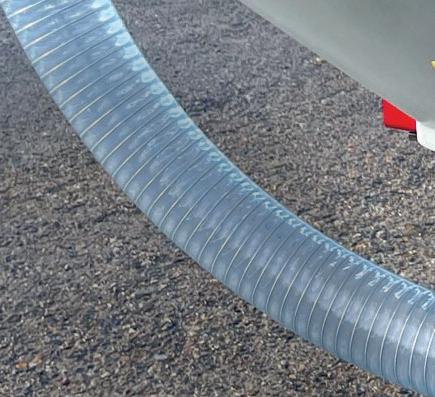
Techneat MulticasT – a seeder that applies numerous products and suits a wide variety of implements.



Designed and manufactured in UK


25 years experience
Applies all small seeds, Avadex granules, cover crops and slug pellets
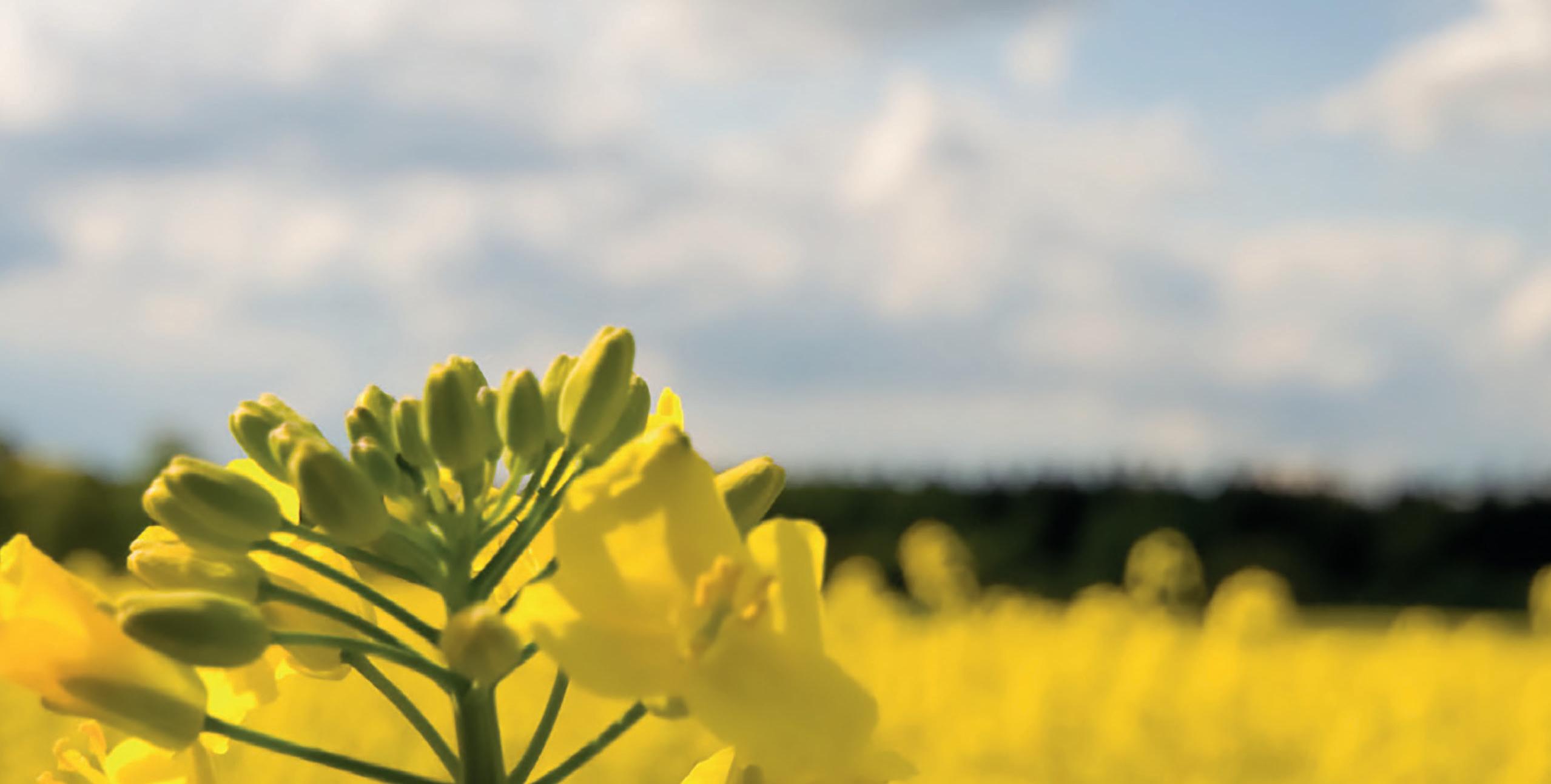
Powerful hydraulic fan
Garmin GPS control system

200l or 400l hopper

Configure the spec` to suit your needs

















12m/15m boom available
Dual hopper option
Excellent service and spares support
69 MAY 2023
IsoBus control was straightforward to use, but an additional control box is also offered.
The calibration bag worked well, however fitting into the unit was a fiddle.
info@techneat.co.uk www.techneatengineering.co.uk
01353 862 044
Multicast - Agronomist & AF - Farm Contractor - Half Page Horizontal - 210 x 141 + 3mm Bleed.indd 1 05/12/2022 11:01 am
MACHINERY DRILLS
AF verdict
JThe Focus TD is another option in an already busy strip-tillage market and is comfortably positioned at the higher-priced end.
Our team could not fault the build quality and attention to detail with some of the fit and finish.
In use, the machine performed well, with consistent establishment in varied, but generally good, conditions.
The overall machine length (nine metres) was a concern when travelling on rural roads and through some tight gateways.
The lower linkage drawbar assisted with this and offered a tight steering lock. However, the mid-mounted wheels created an alarming quantity of swing from the rear of the machine.
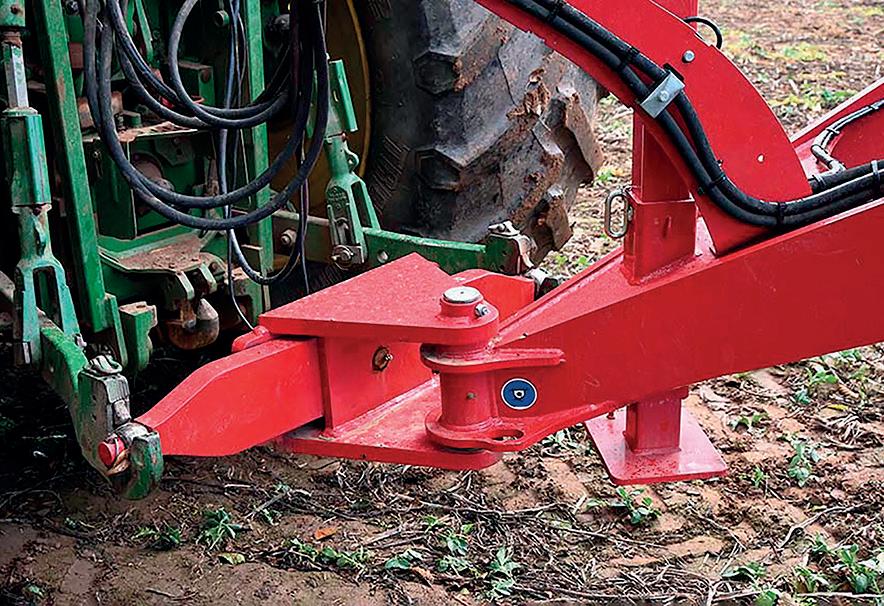

Pulled by the 6155R, average fuel consumption was 10l/ha across 20 hectares of planting, which was slightly lower than the farm’s existing strip-till machine, but greater than a pure disc drill of a similar size.

The adaptability of the
machine to change the cultivation, establishment and metering of products does position the machine to offer greater long-term flexibility. It also possibly improves risk management in terms of the method of crop establishment,
Likes and gripes
JPositives:
rMetering system flexibility
rCalibration access
rLevel surface finish
rSeed placement consistency
rRange of machine configurations
rTank design and access

variety of products applied and adjustments available, depending on conditions. But, the additional components would add a sizeable increase to the cost and business dependence on an already expensive machine.
JNegatives:
rOverall length
rLack of work lights
rTyre replacement process
rEmptying the tank was only possible through the metering system
rOuter disc folding was manual and difficult with the machine raised
70
MAY 2023
The lower-linkage drawbar allowed tight headland turns.
Manually-folding discs either side were difficult and awkward to use.
A level surface finish was achieved during the test with good seed placement.
Expanding to meet demand








Demand for its Claydon Opti-Till agricultural crop establishment machinery has led family-owned UK manufacturer Claydon Yield-o-Meter to further expand its factory in west Suffolk. The completion of a new purpose-built building at the site in Wickhambrook will more than double production capacity and create additional jobs.
Supported by a £267,400 Growing Business Fund Grant from the New Anglia Local Enterprise Partnership (NALEP), the project will help the 40-yearold company meet an increase in orders. These are expected to grow further in 2023 as the business works to develop sales of
a range of products, including it Evolution and Hybrid drills.
Founded by arable farmer Jeff Claydon 1981 to manufacture the Claydon Yield-o-Meter, the firm developed the Opti-Till Direct Strip Seeding System in 2001, to help reduce crop establishment costs without adversely impacting output.
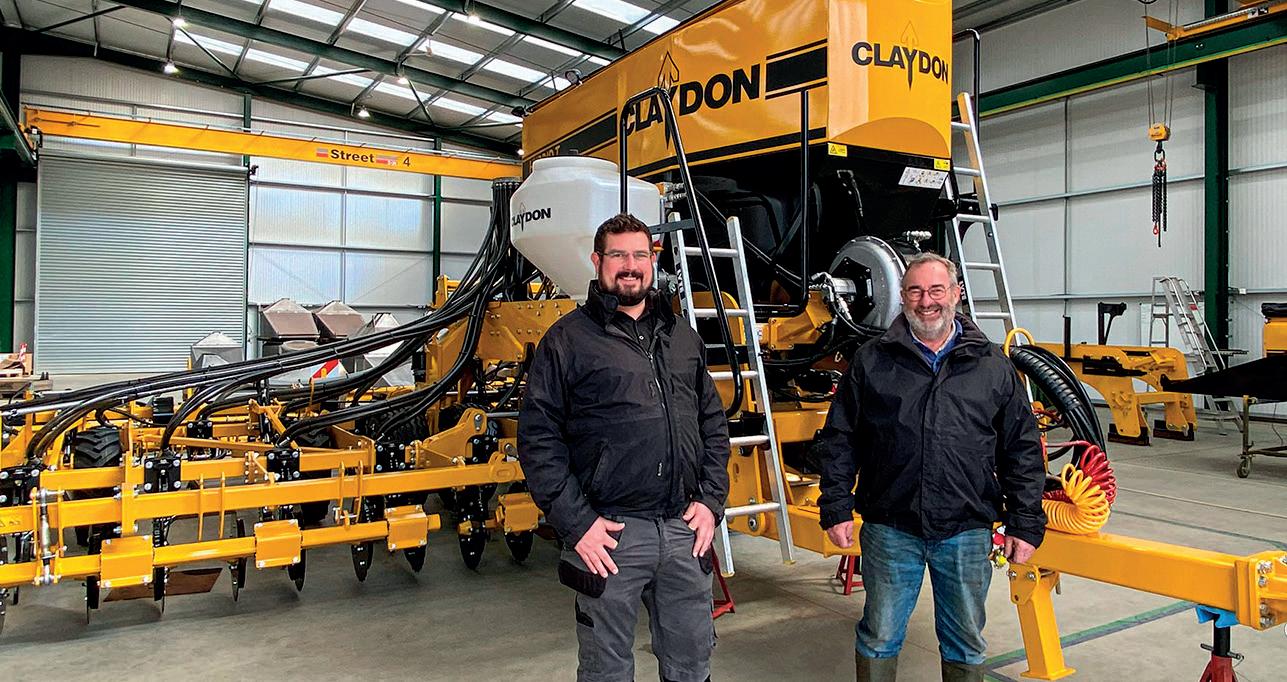

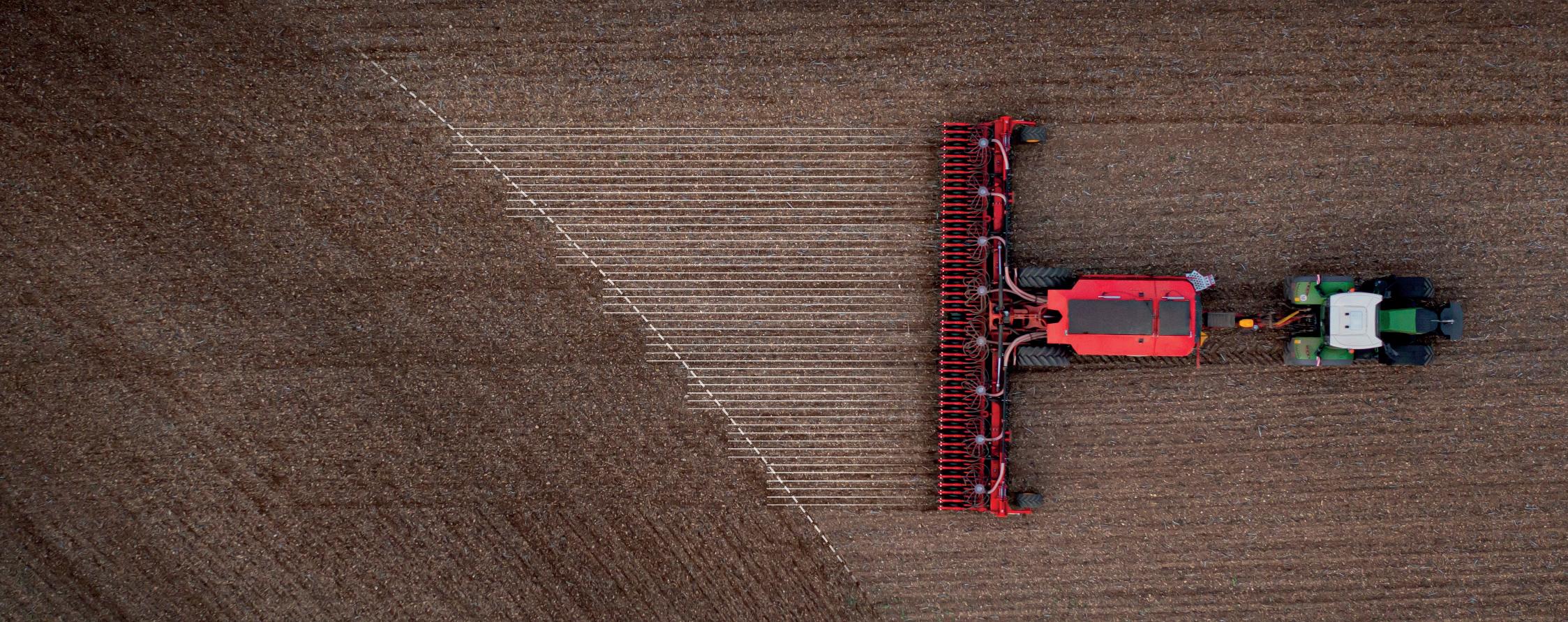
In 2015, Claydon was awarded the NALEP grant to help the business develop in three stages. The first of these was the construction of new offices adjoining the company’s existing production facility to house additional staff to support customers in the UK and overseas markets. The second stage in the company’s development, which has just been completed, involved the construction of a new assembly building on

the footprint of derelict former farm buildings and is much needed, says Jeff Claydon.
“The company is growing rapidly and massively, a highly skilled team is in place, but additional production capacity is needed to manufacture Claydon Opti-Till products to fulfil demand from markets all over the world, including the UK where sales have doubled.
“Despite huge uncertainties caused by Brexit and Covid-19, in July 2021 we decided to go ahead
with the new building to mark the company’s 40th anniversary. Claydon staff completed the footings in the winter of 2021 and construction started in summer 2022.
“This significant investment we have made in these new production facilities will help us to take a quantum leap forward to meet demand for Claydon products and is a key part of our long-term plan to develop the potential which exists all over the world,” says Mr Claydon.
71 DRILLS MACHINERY MAY 2023 Wherefarmingstarts Visitvaderstad.comtolearnmore. Inspire Fullcontrolin8sections!Thisisakeyfeatureof thenew12metreseeddrillInspire1200C/S. VäderstadInspire1200C/Sisbuilttocombine capacitywithsoundagronomics. Introducing Inspire1200C/S
Oliver and Jeff Claydon in the company’s new manufacturing facility.
Green light for use of mancozeb this spring
Multi-site potato blight fungicide mancozeb will continue to be available this spring as a valuable tool to help control disease and preserve the effectiveness of existing chemistry. However, the regulatory picture for the longstanding fungicide is still challenging, with its current approval expiring in early 2024.
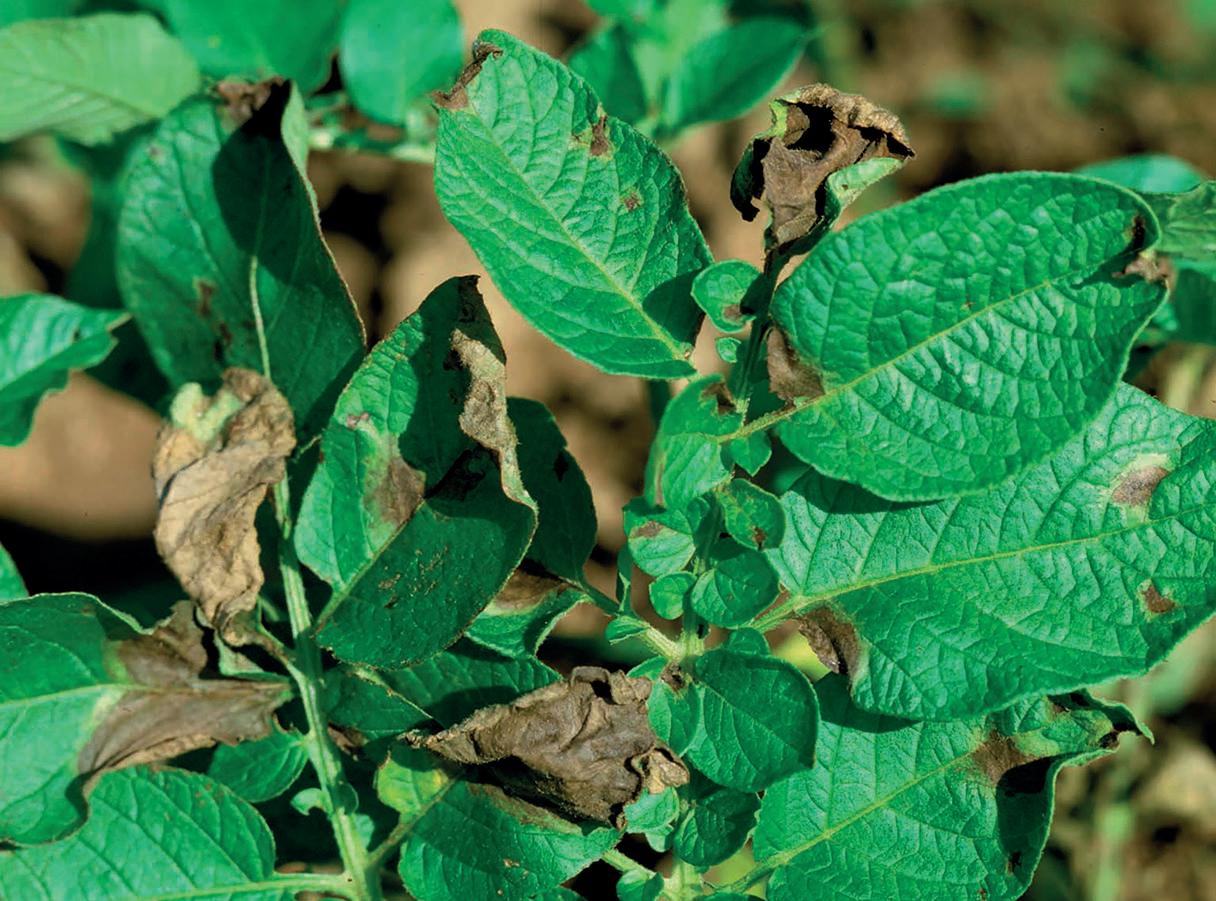
The active substance renewal is currently being assessed by the Chemicals Regulation Division (CRD), but no conclusion is expected imminently.
The uncertainty about whether mancozeb would be available this year meant some manufacturers were reluctant to risk being left with stocks. However, crop protection manufacturer UPL says it has committed to supplying the
fungicide in 2023 to ensure that growers have the option to use it this season.
Geoff Hailstone, UPL’s potato technical expert, says: “Mancozeb provides good activity on both alternaria and late blight. Critically, it is cost-effective, persistent and has multi-site activity, making it an ideal tank mix partner. Mancozeb can protect the activity of other products, most of which are single-site fungicides with a higher risk of resistance or insensitivity developing.”
Focus

Fungicide resistance management is in focus this season, after last year’s blight control failures associated with the spread of blight genotype EU_43_A1.
It was first identified in Denmark in 2018 and subsequently accounted for 21% of
Crop protection range broadens with two PGRs
JTwo plant growth regulator (PGR) active ingredients have been added to Adama UK’s range of crop protection agrochemicals.
The actives trinexapac-ethyl and chlormequat are registered for use on a selection of spring and winter arable crops: Adama’s trinexapac-ethyl formulation is registered for use on spring and winter barley, durum wheat, grassland (seed crop), oats, rye, triticale, and spring and winter wheat, while its chlormequat formulation is registered for use on winter
barley, oats, and spring and winter wheat.
Both active ingredients were marketed by Adama prior to the Syngenta Group merger.
Product manager Jonny Oosthuizen says: “As part of our portfolio growth plans, we will be looking to develop new co-formulations of both actives and will be conducting trials to assess the efficacy of Adama’s formulation of trinexapac-ethyl against other standard formulations. We look forward to updating our trade customers and growers accordingly.”
samples in 2021 and 45% of Danish samples in 2022.
EU_43_A1 is the first strain of P. infestans reported to have resistance to a CAA fungicide. Cross-resistance to this whole chemistry group – including dimethomorph, benthiavalicarb and valifenalate – is likely, explains Eric Anderson, senior agronomist at Scottish Agronomy.
He says: “We rely on CAA-containing fungicides for about 50% our blight programmes in the UK, so this news is very concerning.” EU_43_A1 has not yet been discovered in the UK, he adds.
“However, the fact that we have not found it does not mean it is not here. For this season, we must use precaution when planning our blight fungicide programmes.”
When building a blight programme, mixes of products from different mode of action groups will be essential to protect crops and preserve the efficacy of products for future seasons.
“The alternation between mixes is equally essential to prevent resistance from developing. In this context, mancozeb will be the tank mix partner of choice this season,” he says.
Alternative Growers should avoid using products such as Shirlan (fluazinam), Ranman Top (cyazofamid), Revus (mandipropamid) or Carial Flex (cymoxanil + mandipropamid) without the inclusion of another product at an effective dose and with an alternative mode of action, Mr Anderson says.
“Another consideration is alternaria control. Several fungicides that control alternaria are in co-formulation with a CAA-containing product. Unless the variety has good resistance to the disease, mancozeb will be useful in suppressing alternaria. I would advise applying 1,000g of active/ha of mancozeb alongside a mixture of singlesite chemistry.”
72 PRODUCT NEWS MAY 2023
Mancozeb is important for both blight control and preserving fungicide efficacy.
MATTCulley
Urea offers a crucial opportunity to show self-regulation works
Last month I started off discussing how wet early March had been, so I will resist saying much about the rest of the month. But much as we have needed some moisture back in the ground, I could do with a few more dry days at home and it’s a relief that it now seems likely. It’s a good job we did have the dry February, which allowed many people to start drilling earlier than they normally would be able to.
However, at times it has been not just the rain which has felt relentless. There have been quite a few articles and stories in the media in recent weeks critical of particular aspects of farming. This is frustrating for all of us,
About the author
rNFU crops board chairman Matt Culley is a fourth-generation farmer from Hampshire working in partnership with his parents and brother

rThe 720-hectare enterprise produces wheat, barley, oilseed rape, forage maize and rye for anaerobic digestion across varying soil types, from chalk and chalk loam to clay cap. This includes 170ha of owned and rented land and 540ha of contract farming agreements
rThe family also runs a pick-your-own soft fruit and summer vegetables business
especially as farmers, and the NFU spends as much time as possible championing all the good things arable farmers do. Of course, where there is bad practice or bad behaviour it is important we challenge it, whether it is a result of accident or intent. But the reality is, the overwhelming majority of farmers are doing the right thing for their crops and the environment, and we shouldn’t let this get lost in the noise.
Narratives
Absurd as it sounds, one thing that is almost always missing from these debates, sadly, is much coverage of food production. On the policy front, there is lots to do, not least countering the simplistic and contradictory narratives where manures are seen as bad in one media story, at the same time as some policies would like to see us using more of them to improve the soil and reduce the amount of manufactured fertiliser used. Over the coming months, we will be working to increase the link people make in their minds between what they see in the countryside around them, and what they eat and drink, in the annual Your Harvest campaign. For those on social media, keep an eye out because we hope people across agriculture and the supply chain will join in promoting harvest to the public and policymakers. It sometimes feels a harder task for the arable sector because the things we
grow have to be processed into something before the consumer buys it, which increases the gap between farm and fork. But hopefully this campaign will help close that gap.
One bit of good news relates to another topic this column has covered before - solid urea fertiliser. It now seems likely the industry approach of self-regulation in the form of ‘Option 4’ will take effect from April 2024. Now I wouldn’t normally say more regulation, even self-regulation is a good thing, but in this case it is, because the alternative was likely to be Defra’s preferred option of a total ban on solid urea fertiliser.
The NFU and others have convinced Defra to give us a chance to use it in a way which reduces the risk of losing ammonia to the atmosphere. This will mean uninhibited urea can be used between January 15 and the end of March, and outside of these dates you will need to use inhibited urea. If you use urea, it will be worth being familiar with the rules in full and how they might affect the way you use it. The changes were originally planned to come in this year, but we argued they should be delayed because of the crisis in the fertiliser market. The Government has now decided the rules will be brought in from next year, so we should all be prepared.
It is also an opportunity, and a crucial one, to show that we can make this approach work, and prove to the Government it was right to trust us to self-regulate, rather than legislate.
73 TALKING POLICY MAY 2023
BASIS news How to find an environmental consultant
In just nine months since its launch, the Environmental Advisers Register has reached some 150 members and BASIS Registration has introduced an added bonus of a ‘find an adviser’ feature to its website to help farmers and landowners find suitable consultants in their area.
“As well managed environmental features become increasingly important, the new online directory will enable farmers and consultants alike to find the details of advisers on the register working in their area,” explains Teresa Meadows, BASIS head of environment and public affairs.
“Register entries include their contact information, the locality they work in, their particular areas of expertise and an optional personal profile as part of their directory entry.
“With the increasing emphasis on environmental matters on farmed land, farmers are looking for expertise in addition to that of well-established agronomists. The new feature is designed to help.”
Categories
Starting at basis-reg.co.uk/ environmental-advisers/ find-an-adviser, those seeking to identify advisers in their area first enter their location and then select one or more of the categories of interest: air and climate; biodiversity; energy and resource use; historic environment; livestock management; nutrient management; plant and crop health; productivity; soil; water; and woodland.
The result of the search shows the range of advisers on the register who meet the chosen criteria of location and skills.
The information can include a photograph and contact details along with the locations that the
adviser covers and the skills they offer. Register members also have the option to include biographical details such as education, professional qualifications, career history and areas of special interest.
“The results will help farmers and land managers who are seeking professional advice for projects such as applying for an agri-environment scheme or improving environmental features on an area of land to find suitable advisers who are qualified, experienced and committed to continuing professional development,” says Ms Meadows.

BASIS also hopes the new online directory will encourage
more advisers working in related environmental areas to join the Environmental Advisers Register.
Membership
Advisers wishing to gain membership have three options at present. Until the end of 2023, there is the option of entry via the ‘acquired rights’ route for those who have at least three years’ experience in the relevant areas of environmental advice. Applications are assessed by an industry steering group. Those who have previously completed the BETA Conservation Management course can also apply through this route.
Both these options require a
compulsory 30 question multiple choice assessment which must be completed within 40 minutes. This asks questions across a range of environmental advice areas drawn from across the skills areas of the register.
The third option, for those who have not gained the necessary experience, or are entering this area of advisory work, can achieve entry by successfully completing the Certificate in Sustainable Land Management.
For more information about both routes, visit: basis-reg.co.uk/environmentaladvisers/becoming-a-member
74 MAY 2023 The latest news for BASIS
FACTS-qualified
and
farmers and advisers.
MORE ONLINE
Farmers are looking for environmental expertise in addition to agronomy advice.































































November 29-30, 2023 NAEC Stoneleigh, Warwickshire FarmersGuardian and ArableFarming JoannaWignall 07881 386 250 Joanna.Wignall@agriconnect.com For more information contact: Limited stands remaining for 2023 More than 60% of stands have been booked for The CropTec Show 2023.YARA, UPL, Bayer and Kuhn are among a host of returning sponsors and exhibitors. Join us at our new venue, NAEC Stoneleigh, Warwickshire and exhibit your product or service to targetted audience of growers, decision-makers and agronomists. Why exhibit at the CropTec Show? of visitors are the decision maker 81% is the average intended spend of buyers £138k of visitors are farm owners 31% directly involved in agronomy 18% of the country are 98% registered attendees 3,000 The CropTec Show provides a platform and opportunity to showcase the latest technological developments and innovation for the arable sector to those seeking proggessive growth. Stands available from £1,674+VAT croptecshow.com




























ARE YOU A BUSINESS THAT HAS BEEN OPERATING FOR UNDER 2 YEARS? 2023 The dedicated Start-Up Zone at Future Farming Expo is ideal for enterprises that have been in operation for less than two years. The zone allows smaller businesses to participate in events alongside larger corporations and other like-minded businesses. WHY FUTURE FARMING EXPO SHOULD BE ON YOUR 2023 CALENDAR: 3 Exposure to thousands of farmers, advisors, and rural business owners 3 Promote your product or expertise to an engaged audience 3 Generate crucial leads for your business 3 Promotion across huge brands, such as Farmers Guardian 3 Pre-and post-show marketing across web and social media Brought to you by: Contact Joanna Wignall on Joanna.wignall@agriconnect.com or 07881 386 250 to discuss your stand or sponsorship options. 10 th - 11 th October 2023 www.futurefarmingexpo.com






























































































































































































































































































































































































































































































































































































